MEET THE SPECIALISTS
At Lyon & Turnbull we want to make buying at auction as easy and enjoyable as possible. Our specialist team are on hand to assist you, whether you are looking for something in particular for your home or collection, require more detailed information about the history or current condition of a lot, or just want to find out more about the auction process.
ALEX TWEEDY Head of Sale


alex.tweedy@lyonandturnbull.com
kerstin.schaeffer@lyonandturnbull.com
KERSTIN SCHAEFFER Junior Specialist
3
1
EGYPTIAN MOSAIC GLASS INLAY OF A COMIC ACTOR
EGYPT, PTOLEMAIC PERIOD, 1ST CENTURY B.C. - 1ST CENTURY A.D. mosaic glass, on a turquoise ground, depicting Silenos or a new comedy actor wearing a vine wreath
2.5 x 1.2cm
Provenance: Private collection, London, United Kingdom, formed 1965 - 2020
£1,000-1,500
EGYPTIAN MOSAIC GLASS INLAY OF A COMIC ACTOR

EGYPT, PTOLEMAIC PERIOD, 1ST CENTURY B.C. - 1ST CENTURY A.D. mosaic glass, on a grey ground, depicting a white comic actors mask

2 x 1.4cm
Provenance: Private collection, London, United Kingdom, formed 1965 - 2020
£800-1,200
2
4
FINE ANCIENT EGYPTIAN MOSAIC GLASS INLAY
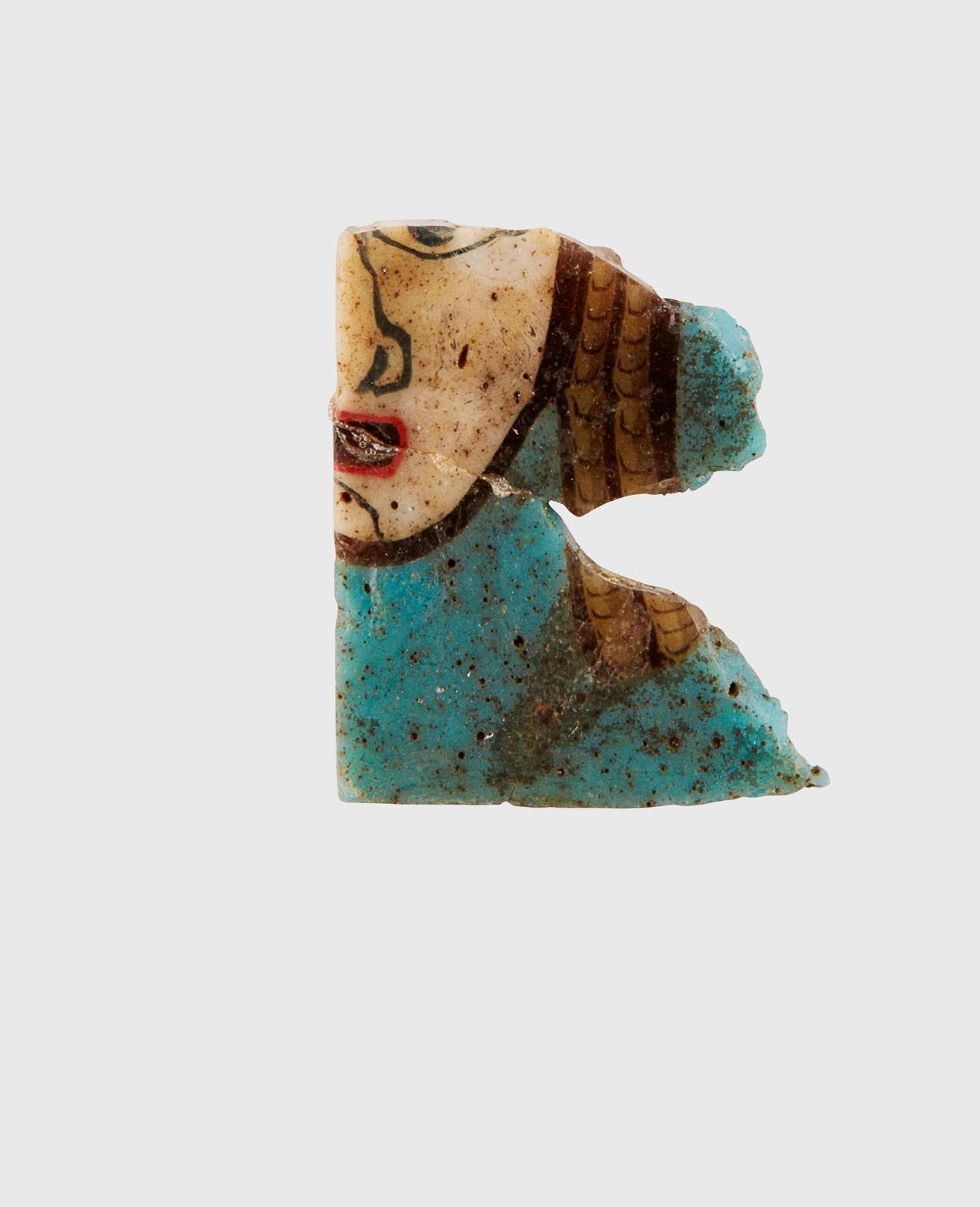

EGYPT, PTOLEMAIC PERIOD, 1ST CENTURY B.C.1ST CENTURY A.D.
mosaic glass, on a dark blue ground, depicting an actors mask of an elderly bearded man from the new comedy
3 x 1.5cm
Provenance: Private collection, London, United Kingdom, formed 1965 - 2020
£1,500-2,500
3
EGYPTIAN MOSAIC GLASS INLAY OF A COMIC ACTOR
EGYPT, PTOLEMAIC PERIOD, 1ST CENTURY B.C. - 1ST CENTURY A.D.
mosaic glass, on a blue ground, depicting a white comic actors mask
1.2cm x 1.1cm
Provenance: Private collection, London, United Kingdom, formed 1965 - 2020
£400-600

4
5 Other fees apply in addition to the hammer price: see the ‘Buyer’s Guide’ section on page 2
5
COLLECTION OF ANCIENT GLASS INLAY FRAGMENTS
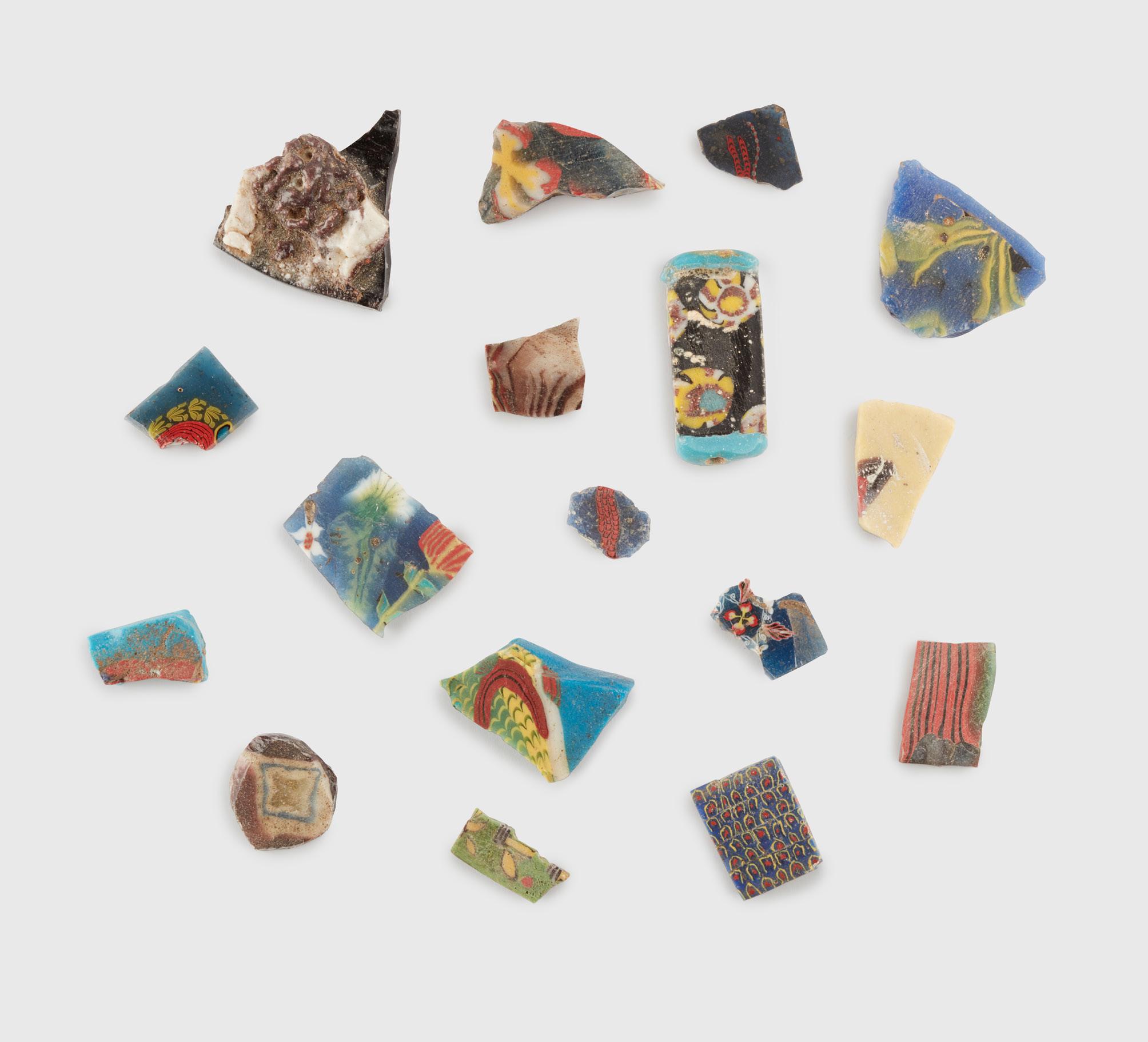
EASTERN MEDITERRANEAN AND NEAR EAST, 1ST MILLENNIUM B.C. a collection of seventeen fragments, including pieces depicting a comic actors mask and multiple floral scenes (17)
largest 5.4cm long
Provenance: Private collection, London, formed 1965 - 2020
£400-600
ANCIENT EGYPTIAN GLASS INLAY FRAGMENT

EGYPT, C. 1ST CENTURY B.C. - 1ST CENTURY A.D.
core formed glass, with a central design of a white and blue petaled flower in bloom on a red background, with a yellow and red border

2cm x 2cm
Provenance: Private collection, London, formed 1965 - 2016
£300-500
7
ANCIENT EGYPTIAN GLASS INLAY
EGYPT, PTOLEMAIC PERIOD, FIRST CENTURY B.C. - FIRST CENTURY A.D. core formed glass, depicting a worshipper on a maroon ground with decoration blue, red and black border
2.3cm x 3cm
Provenance: Private collection, London, United Kingdom, formed 1965 - 2020
£400-600

6
6
PHOENICIAN JANIFORM COMIC FACE PENDANT NEAR EAST, 600 - 400 B.C. glass, formed of a cylindrical dark blue bead with applied white detail on both sides marking the facial features, raised on a bespoke mount
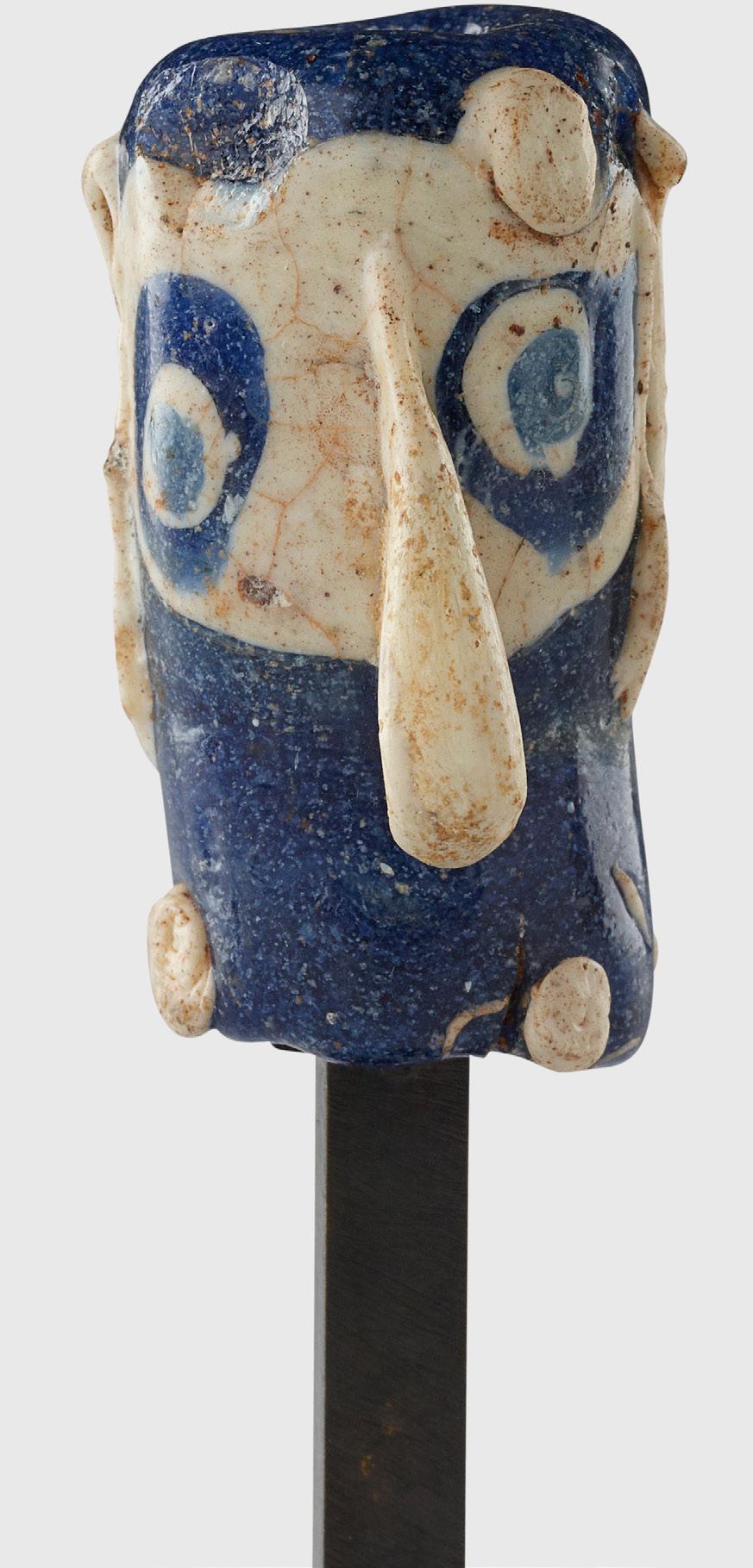

4.5cm high
Provenance: Private collection, London, formed 1960s - 2020 £3,000-5,000
8
7 Other fees apply in addition to the hammer price: see the ‘Buyer’s Guide’ section on page 2
ANCIENT SASSANID MINIATURE BLUE GLASS BOTTLE NEAR EAST, FIRST HALF OF THE FIRST MILLENNIUM A.D. rising from a small discoid foot, the piriform body with raised ribbing running diagonally upwards, short neck and flaring rim, dual small strap handles, the colour a sapphire blue when applied to light
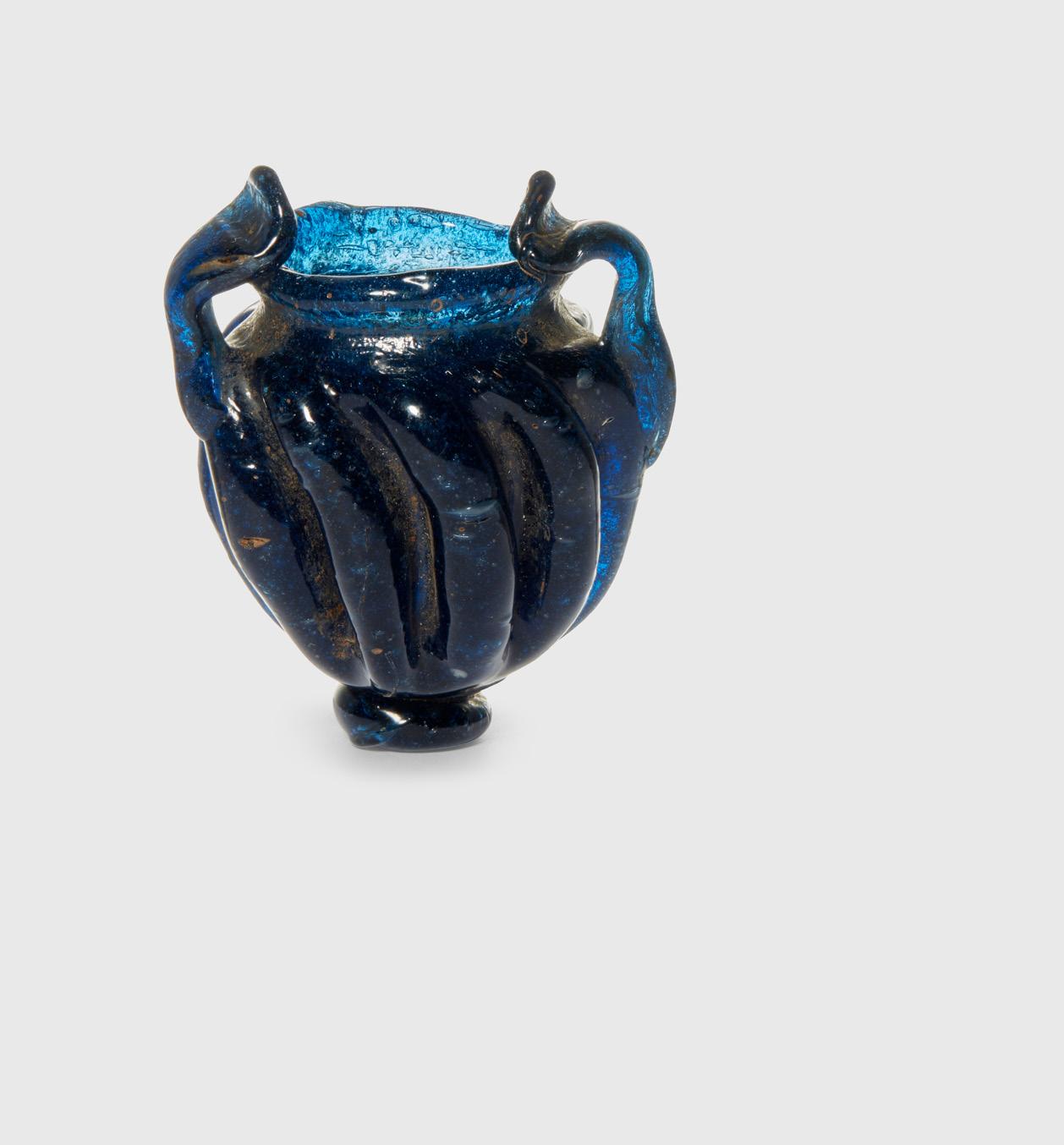
5.6cm high
Private collection, London, United Kingdom, acquired Christie’s 1980s
£1,000-1,500 10
BYZANTINE GLASS BOTTLE

EASTERN MEDITERRANEAN, 4TH - 6TH CENTURY A.D. blown and applied glass, of amber colour, the bottle sitting on a recessed base, the shoulders tapering to a slender neck and subtly everted rim, the body decorated with a series of three (>?<) crescents of trail within which sit applied human faces
9cm tall
Provenance: Private collection, United Kingdom, acquired on the London art market in November 1999
£1,000-1,500
GREEK MOSAIC GLASS MINIATURE AMPHORA EASTERN MEDITERRANEAN, C. 3RD CENTURY B.C. miniature glass amphora with piriform body, carinated rim, applied handles and discoid foot, with polychrome geometric motif to the equator

4.7cm high
£500-700 12
IMPACT DESERT GLASS SPECIMEN SAHARA DESERT
of smoky yellow colour, formed as a result of a meteorite impact, where the intense heat and pressure generated by the impact caused the surrounding sand or rock to melt and fuse together
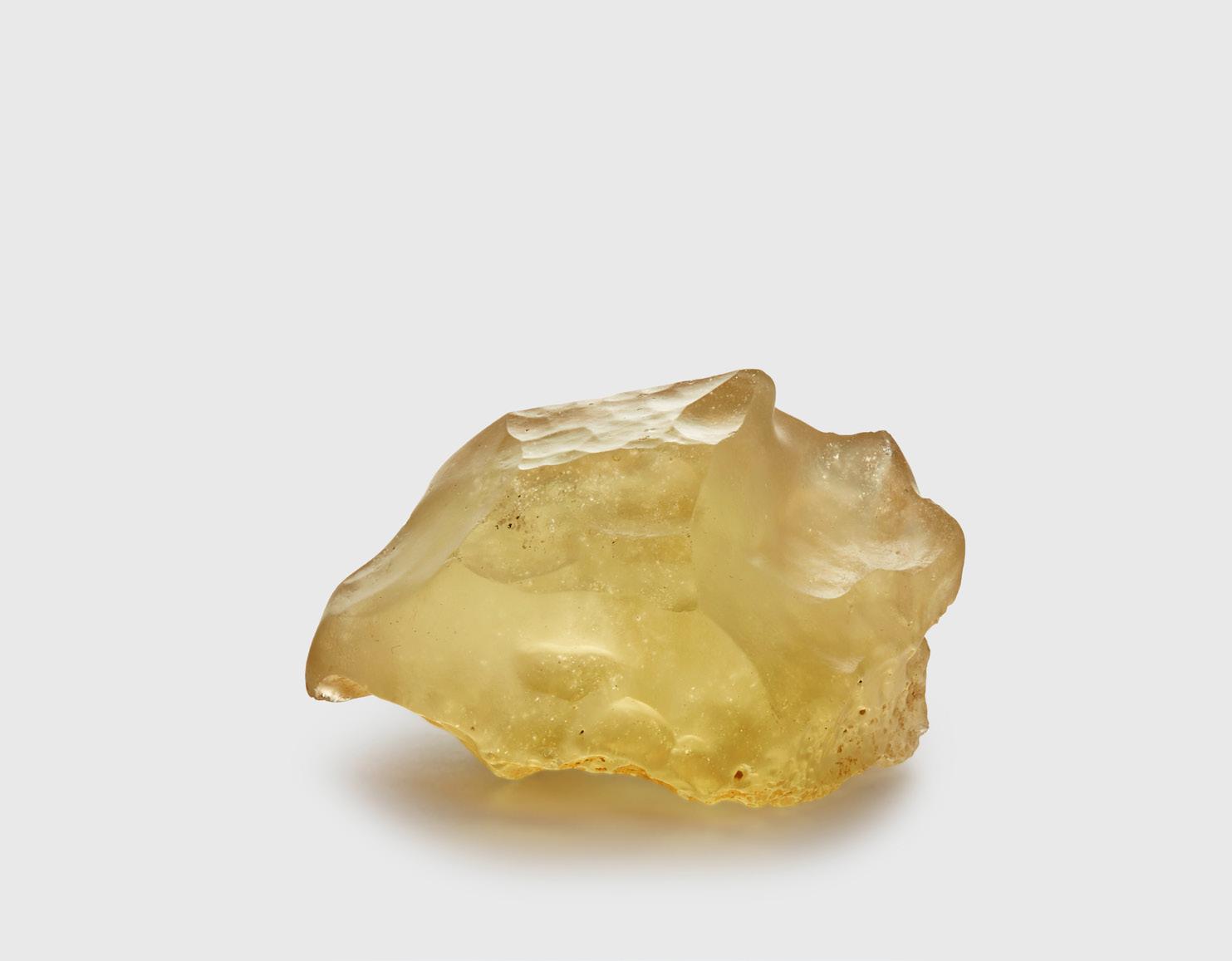
6.6cm diameter, 120.3g
£800-1,200
9
11
8
CROSS SECTION OF A PALLASITE METEORITE
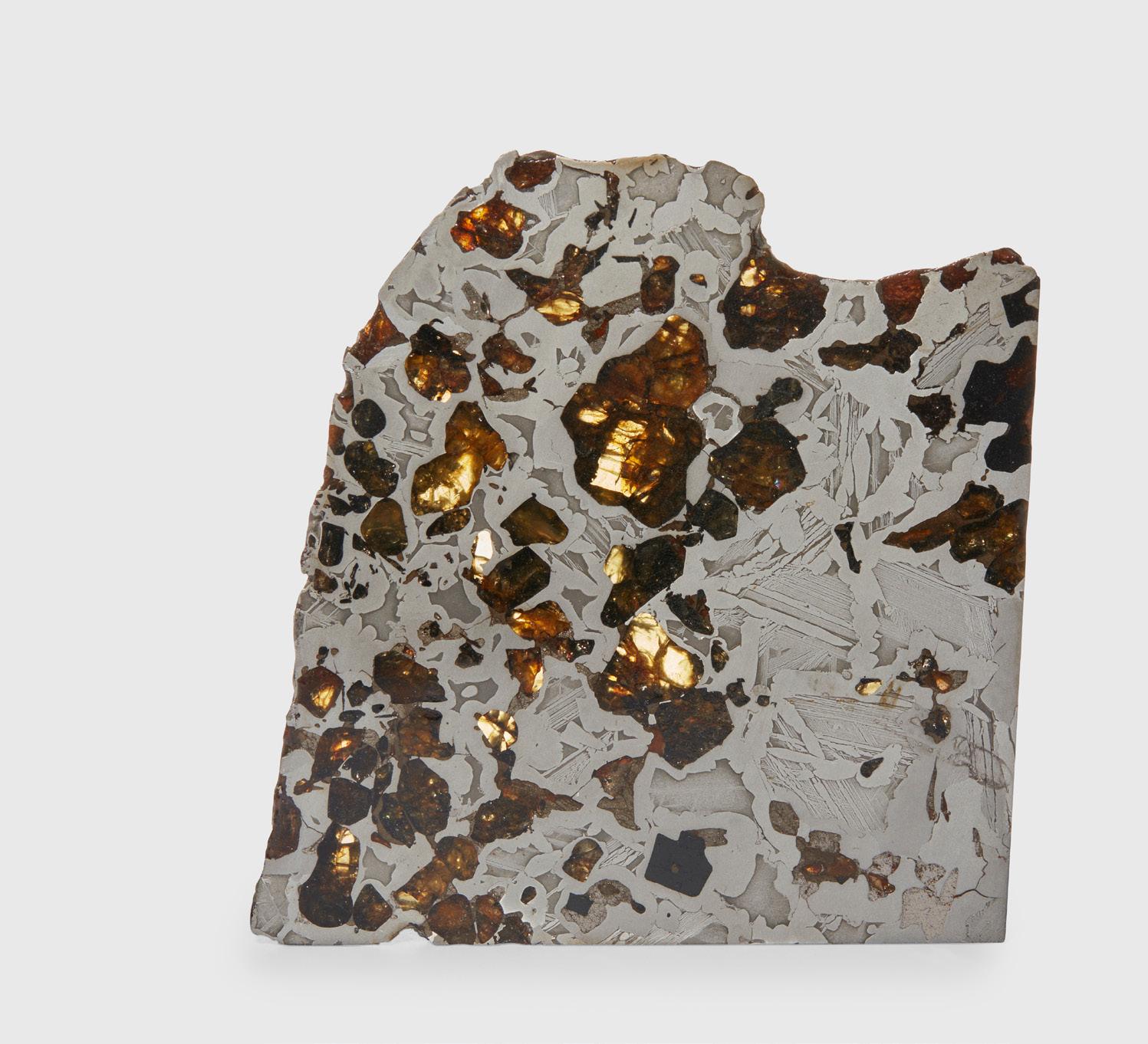
SEYMCHAN, SIBERIA, C. 4.5 BILLION YEARS B.P.
the slice with olivine crystals suspended within the metal matrix and etching
7.8cm tall
Note: The meteorite that produced this sculpture was formed in the Asteroid Belt around the same time as the birth of our Solar System. It consists of both metal and olivine minerals, the remnant materials of planet forming collisions occurring during this formative period.

£1,500-2,500
14
SIKHOTE ALIN METEORITE
SIBERIA, 4.54 BILLION YEARS B.P.
displaying a gunmetal patina, the form sculpted by the intense heat and melting during its atmospheric entry, raised on a custom mount
15.9cm high including stand
Note: The Sikhote Alin shower was the largest meteorite shower of the last several thousand years. The meteorite is considered to have broken off from a larger mass in the asteroid belt around 300 million years ago, before beginning its slow journey towards Earth. The present example fell to Earth over eastern Siberia on the 12th February 1947 as part of that famous event. Many of the eyewitnesses at the time thought the world was ending; a smoke trail streaked across the sky, shockwaves from the explosion shattered windows and uprooted trees and sonic booms were heard hundreds of miles away.
£1,200-1,800
13
9 Other fees apply in addition to the hammer price: see the ‘Buyer’s Guide’ section on page 2
15
VILLANOVAN BLACKWARE URN
NORTH-CENTRAL ITALY, MID 9TH CENTURY B.C.
terracotta, bi-conical urn, with incised geometric panels and chain decoration, with single handle

36.7cm high
Provenance: Bought from Gerry Eisenberg at Royal Athena Galleries in New York in 1999
Private Scottish collection since £1,000-1,500
10 Other fees apply in addition to the hammer price: see the ‘Buyer’s Guide’ section on page 2
VILLANOVAN BLACKWARE AMPHORA

NORTH-CENTRAL ITALY, MID 9TH CENTURY B.C.
terracotta, standing on a flat base, the wide neck and body decorated with linear sgraffito, cornuta handles
36cm high
Provenance: Bought from Gerry Eisenberg at Royal Athena Galleries in New York in 1999 Private Scottish collection since £2,000-3,000
Note: Before Rome became the dominant city-state on the Italian peninsula during the 6th century BCE, the region known today as Tuscany, near Florence, was the most advanced and influential. The Villanovans, who inhabited the area, were highly skilled metalworkers and potters. They practiced cremation and placed the ashes in urns, such as the typical example shown here, which was wheel-thrown and assembled. The linear design was achieved using sgraffito, and the distinctive cornuta (horned) handles, influenced by metalworking, make a striking statement. The pot was fired using a smoky reduction method, which explains its black colour.
16
11
FINE BRONZE AGE DRINKING CUP
WESTERN EUROPE, C. 800 B.C.
hammered bronze sheet, with a flaring rim and short neck above a rounded shallow body adorned with dual horizontal bands of punched circles, the underside with a concave base bordered by three chased concentric bands, the handle formed separately and affixed with a squared bronze pin at each end, displaying a rich green patination
17cm diameter inc. handle
Provenance: Private collection, Walton-on-Thames, acquired 1930-1970s Private collection, United Kingdom, acquired from the above 1970s
Note: This drinking cup would likely have originally been part of a set, with a number of such cups accompanying a larger vat from which would have been served beer or in more southerly locales, wine.
£3,000-5,000

During the Late Bronze Age in Central Europe (1300 to 800 B.C.), and indeed Europe more widely, archaeological evidence suggests that societies were increasingly characterised by a martial ethos, hierarchical social structures and a focus on military prowess as a means of securing and expanding territory. There is evidence of the emergence of a specific warrior class that held a prominent place in society. Many such individuals were buried with their weapons and other possessions, which were believed to be necessary for their journey into the afterlife. The following collection contains a range of objects that would have belonged to people from this world.
Echoes of this martial culture are to be found in Homer’s contemporaneous epic poem, the Iliad, which provides a vivid portrayal of the spirit of the Late Bronze Age, where large groups of armed individuals would travel significant distances in search of plunder and enrichment. The actual reasons for the emergence of these warrior cultures is not entirely clear. However, some scholars suggest that it may have been driven by a need for protection and control of natural resources such as metal ores and fertile land. Others propose that it may have been linked to the increasing complexity of political structures and the need for military power to enforce social order.
In Central Europe, this warrior elite appears to have enjoyed high social status and power, and the objects featured here reflect their world of privilege.
The drinking cup (lot 17) would likely have originally been part of a set, with a number of such cups accompanying a larger vat from which would have been served beer or in more southerly locales, wine.
Archaeological evidence from burials also reveals the importance of personal grooming in Late Bronze Age Central Europe. Alongside martial gear, warriors were often buried with personal care items such as razors and knives (see lots 18, 19, 20) suggesting that personal grooming and appearance was an important aspect of their culture. For example, a burial discovered in Hungary contained the remains of a male warrior who was buried with a set of bronze grooming tools, including tweezers, a razor, and a comb. The presence of these grooming items alongside weapons and armour suggests that personal appearance and hygiene were important considerations for warriors, and that they may have used these items to maintain a clean-shaven or trimmed appearance.
Further to the south in Mycenaean Greece, we have contemporaneous literary traditions making reference to such practices. For instance, within the Iliad there are several references to personal grooming among the warrior elites. In Book 18, the Trojan prince Hector is described as taking a moment to comb his hair and beard before re-entering the battle. This moment of personal grooming suggests that even in the midst of a violent conflict, appearance and presentation were still important considerations for warriors.
The twisted torque (lot 22), bronze bangle (lot 24), spiral fibula (lot 29) & spiral brooch (lot 21) are fine examples of the ostentatious jewellery worn by the elites of the Late Bronze Age. In the case of the brooch & fibula, their use of the spiral is also significant; the spiral is believed to have held symbolic meaning, and its presence in various forms of art suggests that it held significance for people during this period. Its importance is widely debated, but it is often associated with notions of cyclical time, movement, and transformation.
The significance of the spiral in Bronze Age art may have also been influenced by the materials and techniques used in its production. Bronze Age artisans were skilled in the creation of intricate metalwork, and the spiral may have been seen as a way to showcase their technical abilities.
17
12 Other fees apply in addition to the hammer price: see the ‘Buyer’s Guide’ section on page 2
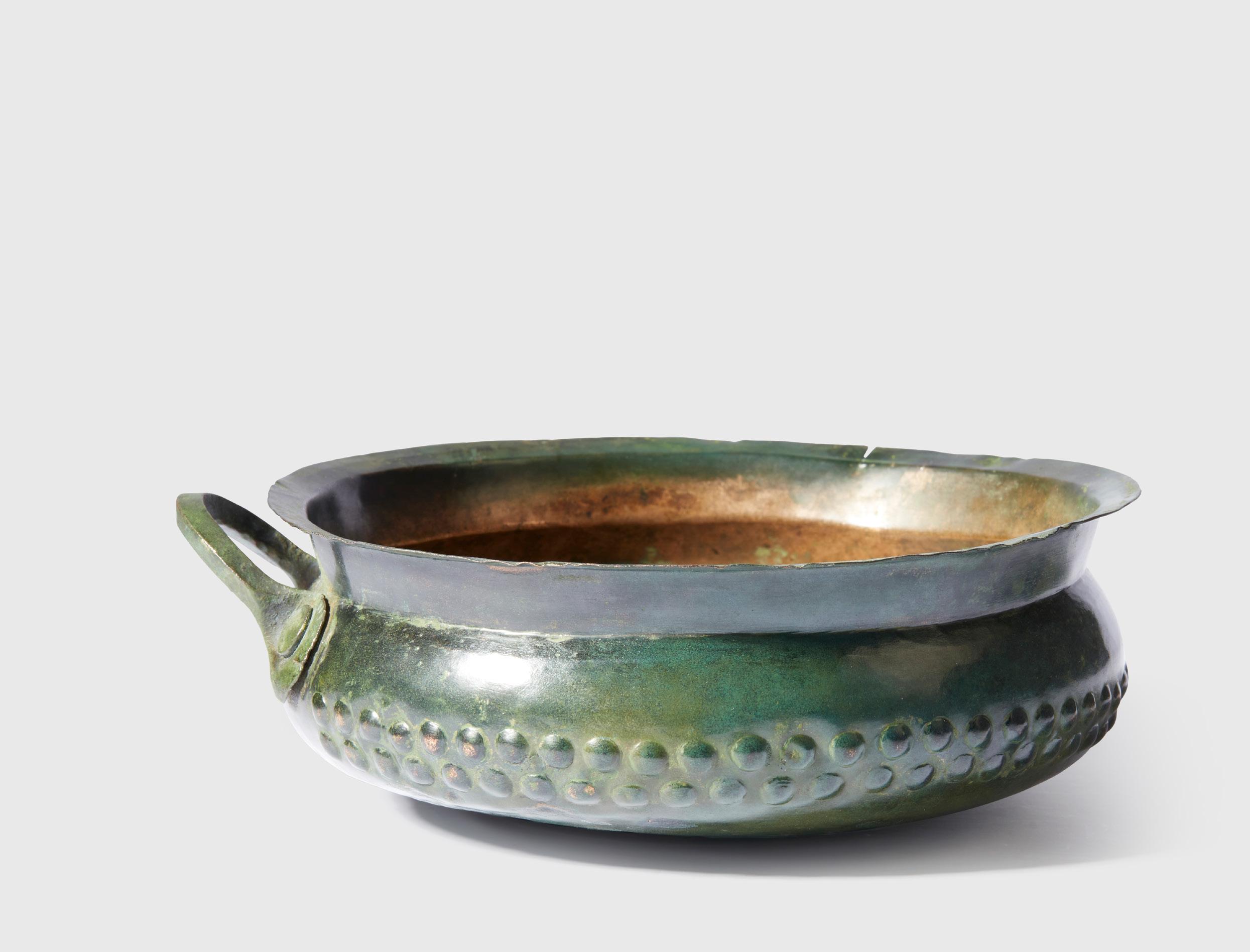
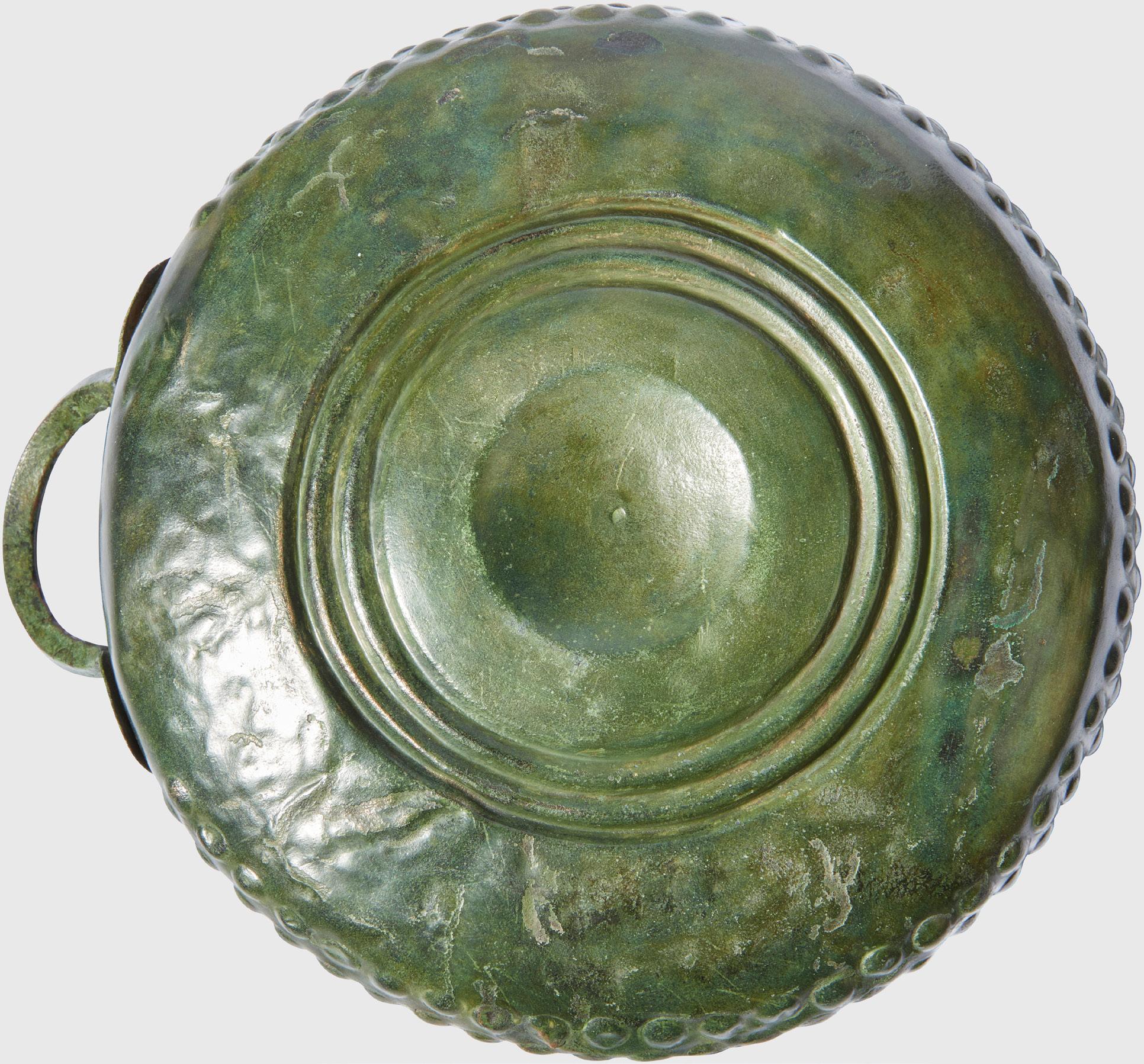
13
BRONZE AGE KNIFE
CENTRAL EUROPE, C. 1200 - 1000 B.C. cast bronze, featuring a long blade and ribbed handle with looped terminal
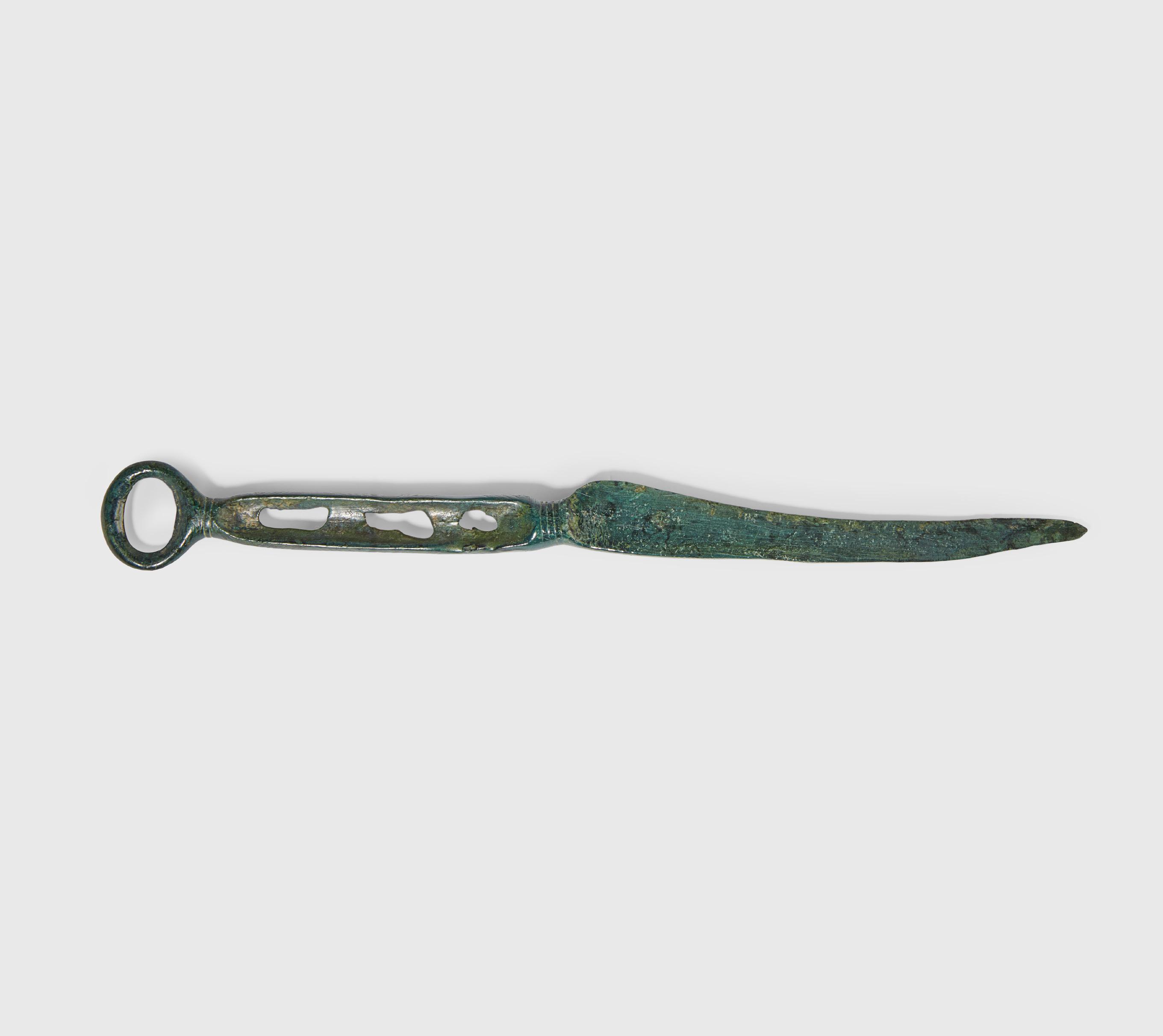
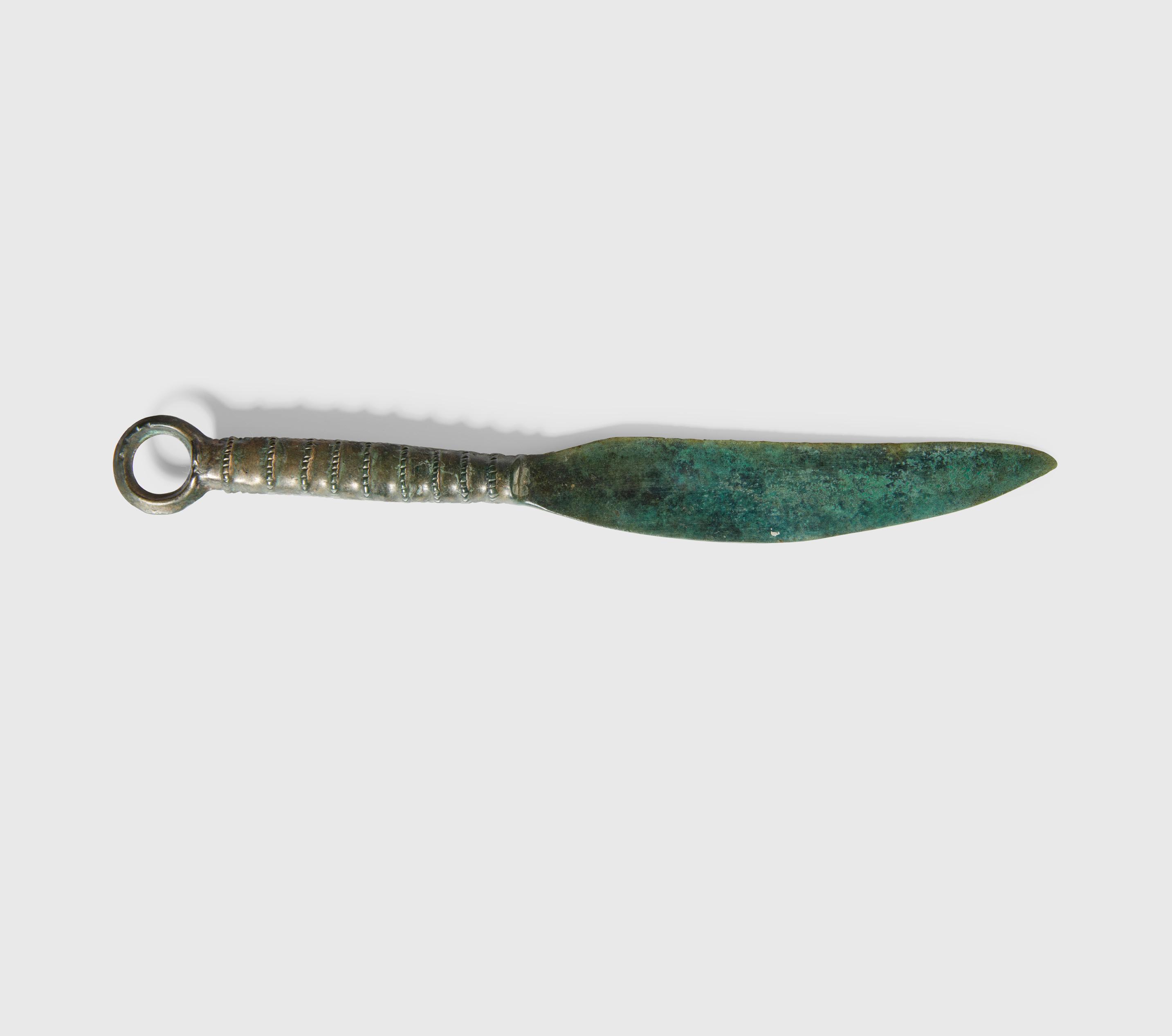
21.6cm long
Provenance: Private collection, Walton-on-Thames, acquired 1930-1970s
Private collection, United Kingdom, acquired from the above 1970s £600-900
FINE BRONZE AGE RAZOR
CENTRAL EUROPE, 1200 - 800 B.C.
cast bronze, with a wafer thin curving blade, the short handle with circular terminal
15.8cm long
Provenance: Private collection, Walton-on-Thames, acquired 1930-1970s Private collection, United Kingdom, acquired from the above 1970s £400-600
Note: Archaeological evidence from burials also reveals the importance of personal grooming in Late Bronze Age Central Europe. Alongside martial gear, warriors were often buried with personal care items such as razors and knives, suggesting that personal grooming and appearance was an important aspect of their culture. For example, a burial discovered in Hungary contained the remains of a male warrior who was buried with a set of bronze grooming tools, including tweezers, a razor, and a comb. The presence of these grooming items alongside weapons and armour suggests that personal appearance and hygiene were important considerations for warriors, and that they may have used these items to maintain a clean-shaven or trimmed appearance. Further to the south in Mycenaean Greece, we have contemporaneous literary traditions making reference to such practices. For instance, within the Iliad there are several references to personal grooming among the warrior elites. In Book 18, the Trojan
prince Hector is described as taking a moment to comb his hair and beard before re-entering the battle. This moment of personal grooming suggests that even in the midst of a violent conflict, appearance and presentation were still important considerations for warriors.
20
LATE BRONZE AGE KNIFE

CENTRAL EUROPE, C. 800 B.C.
cast bronze, featuring a flat curving blade, long handle perforated for the insertion of inlay culminating in a suspension ring
21.5cm long
Provenance: Numisart, Munich, Germany
Private collection, United Kingdom, acquired 1995 from the above £500-800
18
19
14
FINE BRONZE AGE HALLSTATT SPIRAL FIBULA
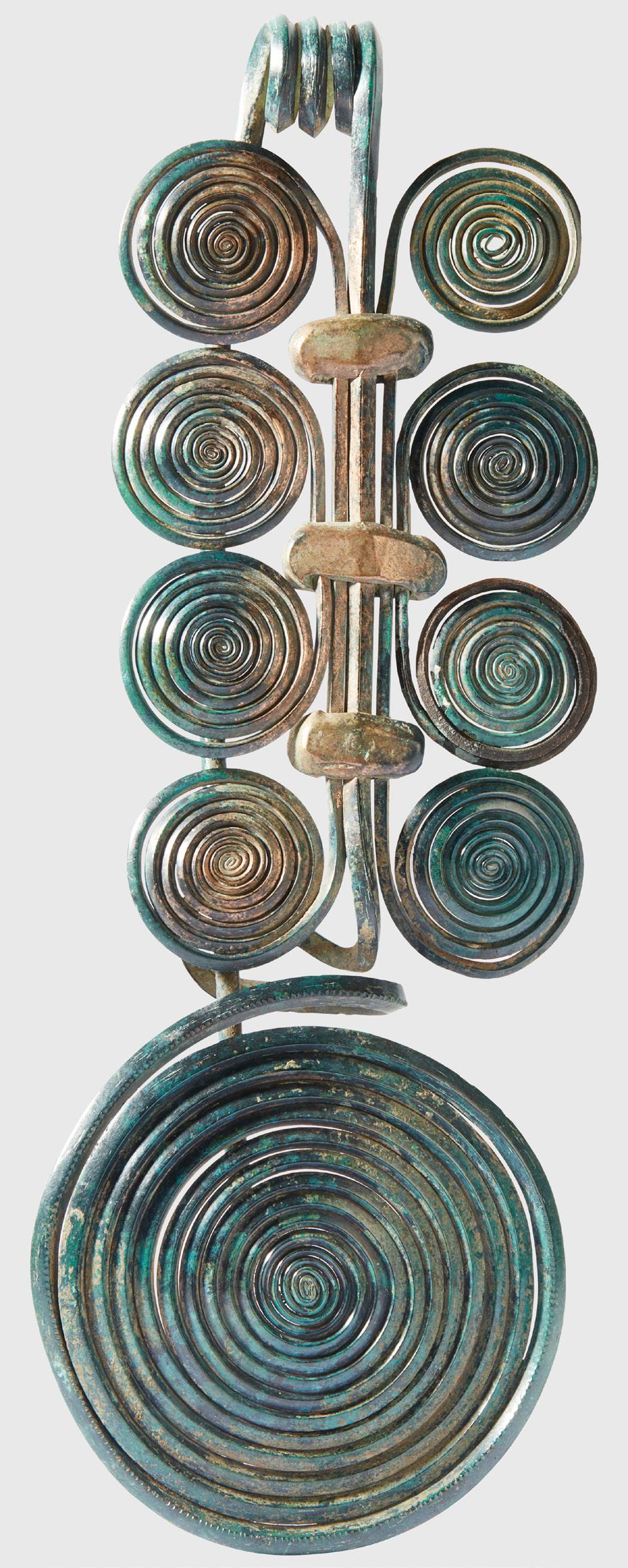
SOUTH CENTRAL EUROPE, LIKELY BALKANS, C. 1000 - 800 B.C. bronze wire, the base of the fibula formed of a single large spiral below a bow with eight smaller lateral spirals, which are attached to the central bow by three cuffs, the head formed into a loop with a quadruple spiral, the reverse with surviving pin 21.2cm long
Provenance: Private collection, Walton-on-Thames, acquired 1930-1970s Private collection, United Kingdom, acquired from the above 1970s £6,000-8,000


The spiral motif is a prevalent feature of Bronze Age art across Europe, particularly in the Late Bronze Age around 1300-700 B.C. The spiral is believed to have held symbolic meaning, and its presence in various forms of art suggests that it held significance for people during this period. Its importance is widely debated, but it is often associated with notions of cyclical time, movement, and transformation.
The significance of the spiral in Bronze Age art may have also been influenced by the materials and techniques used in its production. Bronze Age artisans were skilled in the creation of intricate metalwork, and the spiral may have been seen as a way to showcase their technical abilities. It is also possible that the spiral was used as a decorative element to enhance the beauty and value of objects, such as jewellery and weapons.
21
15 Other fees apply in addition to the hammer price: see the ‘Buyer’s Guide’ section on page 2
BRONZE AGE NECK TORC

CENTRAL EUROPE, C. 1200 B.C. cast bronze, of twisted construction, the tapering ends with flattened, coiled terminals
21.5cm diameter
Provenance: Private collection, Walton-onThames, acquired 1930-1970s Private collection, United Kingdom, acquired from the above 1970s
£600-900 23
PAIR OF BRONZE AGE SPIRAL BANGLES
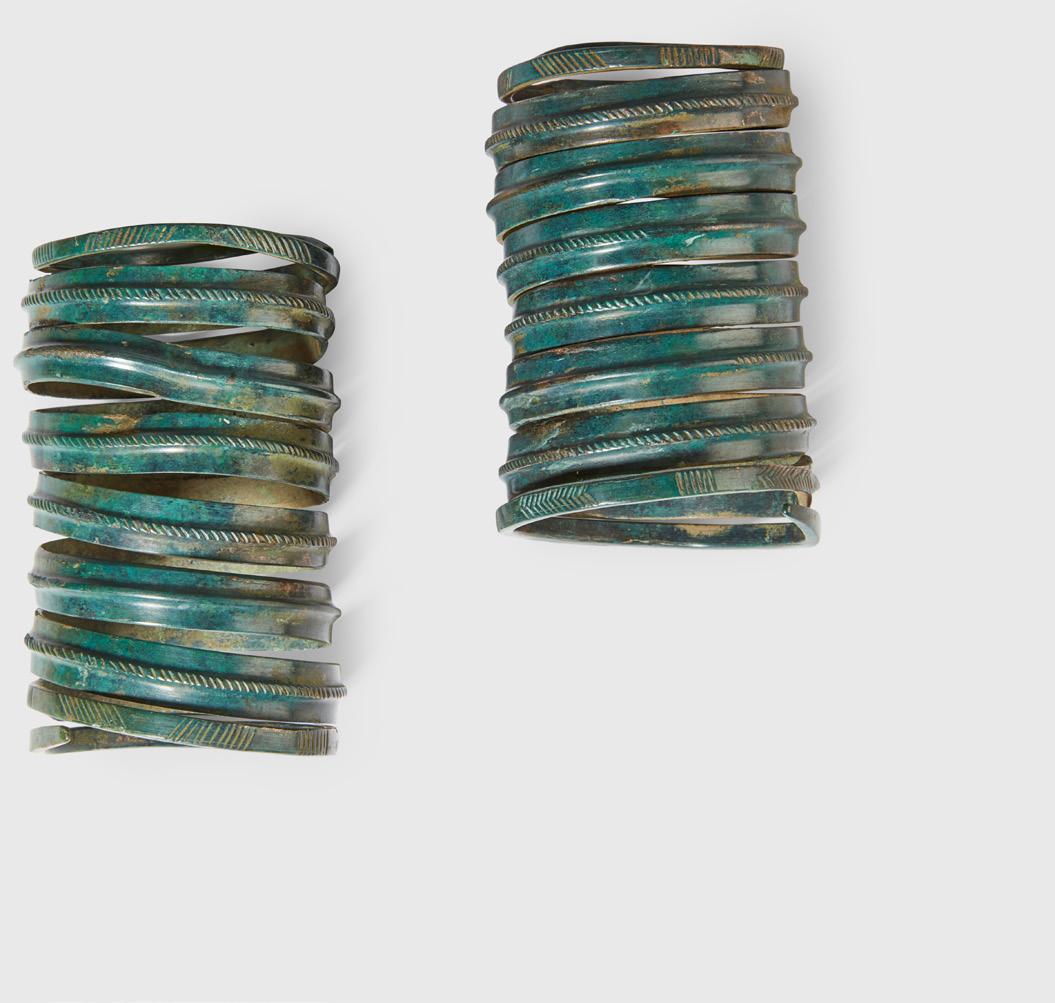
CENTRAL EUROPE, 1200 - 900 B.C.
copper alloy, each made from a single piece of continuous thread, with etched decoration and a raised central ridge (2) largest 7.5cm tall
Provenance: Private collection, Walton-on-Thames, acquired 1930-1970s Private collection, United Kingdom, acquired from the above 1970s
£600-900 24
BRONZE AGE BANGLE
CENTRAL EUROPE, C. 1200 - 800 B.C. cast bronze, the broad pennanular bangle with subtle tiering at the terminals, incised with geometric patterning throughout, rich green patination
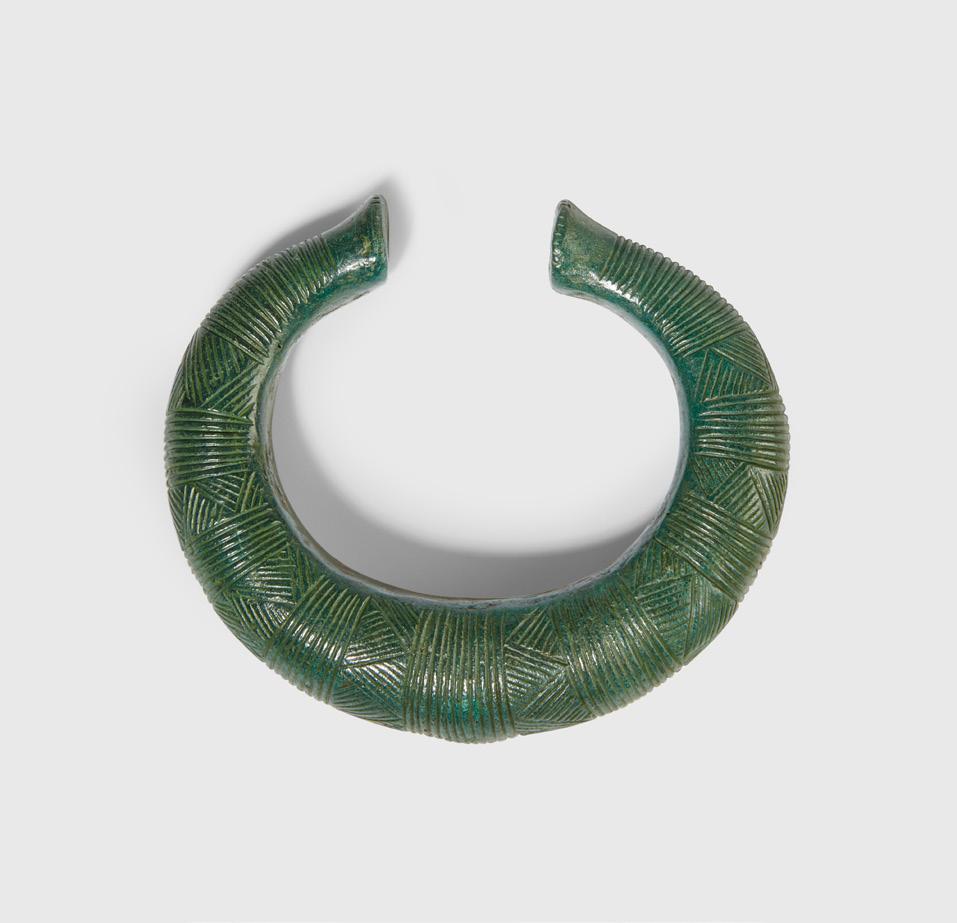
8.5cm diameter
Provenance: Private collection, Walton-on-Thames, acquired 1930-1970s
Private collection, United Kingdom, acquired from the above 1970s
£2,000-3,000
22
16
25
BRONZE AGE GOLD SPIRALS
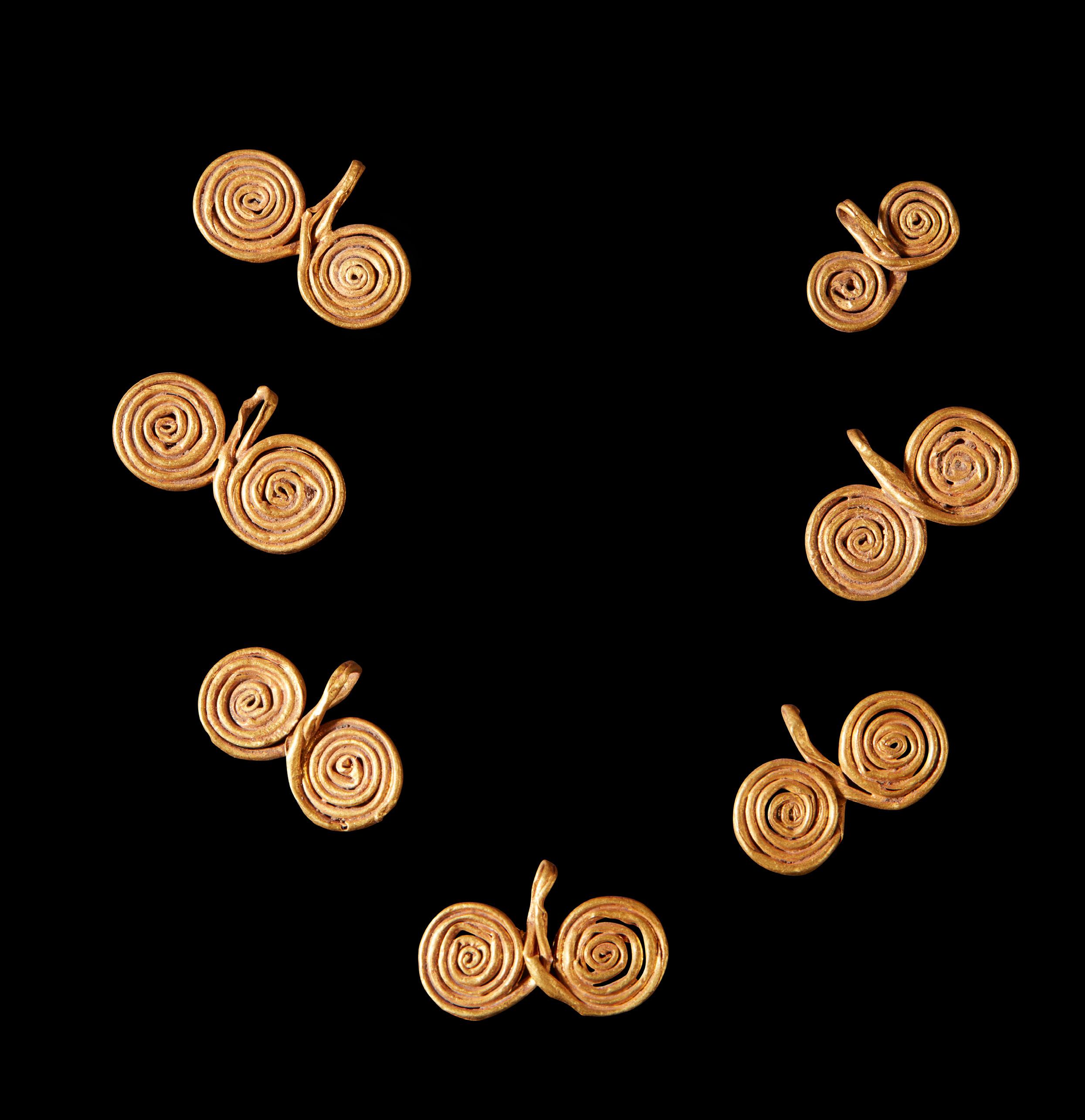
WESTERN EUROPE, C. 1600 - 1200 B.C. gold wire, a collection of seven gold double spirals once part of a larger decorative element, possibly a necklace or bracelet, each formed of a single length of hollow gold wire crafted to form the dual spirals and suspension loop (7) largest 2.4cm diameter
Provenance: Private collection, Walton-on-Thames, acquired 1930-1970s Private collection, United Kingdom, acquired from the above 1970s £4,000-6,000
17 Other fees apply in addition to the hammer price: see the ‘Buyer’s Guide’ section on page 2
26
FINE RECTANGULAR AXE
WESTERN EUROPE, LIKELY NORTHERN ITALY, C. 800 B.C.
cast bronze, the base with flanged wings, with the blade a near rectangular shape, displaying a fine emerald green patina

26.2cm long
£400-600
27
BRONZE PALSTAVE AXE
WESTERN EUROPE, C. 1500 B.C.
cast bronze, featuring a recessed butt with dual flanges, the cutting edge of convex form, dark green patina
15.9cm long
Provenance: Private collection, Walton-on-Thames, acquired 1930-1970s
Private collection, United Kingdom, acquired from the above 1970s
£200-300
28
EUROPEAN BRONZE AGE FLAT AXE


WESTERN EUROPE, C. 1500 - 1200 B.C.
cast bronze, the haft recessed with dual flanges meeting at the base of the shaft, the blade tapering at the centre and leading to a convex cutting edge, displaying a dark olive patina
Private collection, Walton-on-Thames, acquired 1930-1970s
Private collection, United Kingdom, acquired from the above 1970s
21cm long
£300-500
18
29
LARGE BRONZE AGE SPIRAL FIBULA CENTRAL EUROPE, C. 900 - 700 B.C. bronze wire, the “spectacle type” fibula formed of two opposing spiralled circular plates joined by a single bow, displaying a fine glassy green patination, raised on a bespoke stand

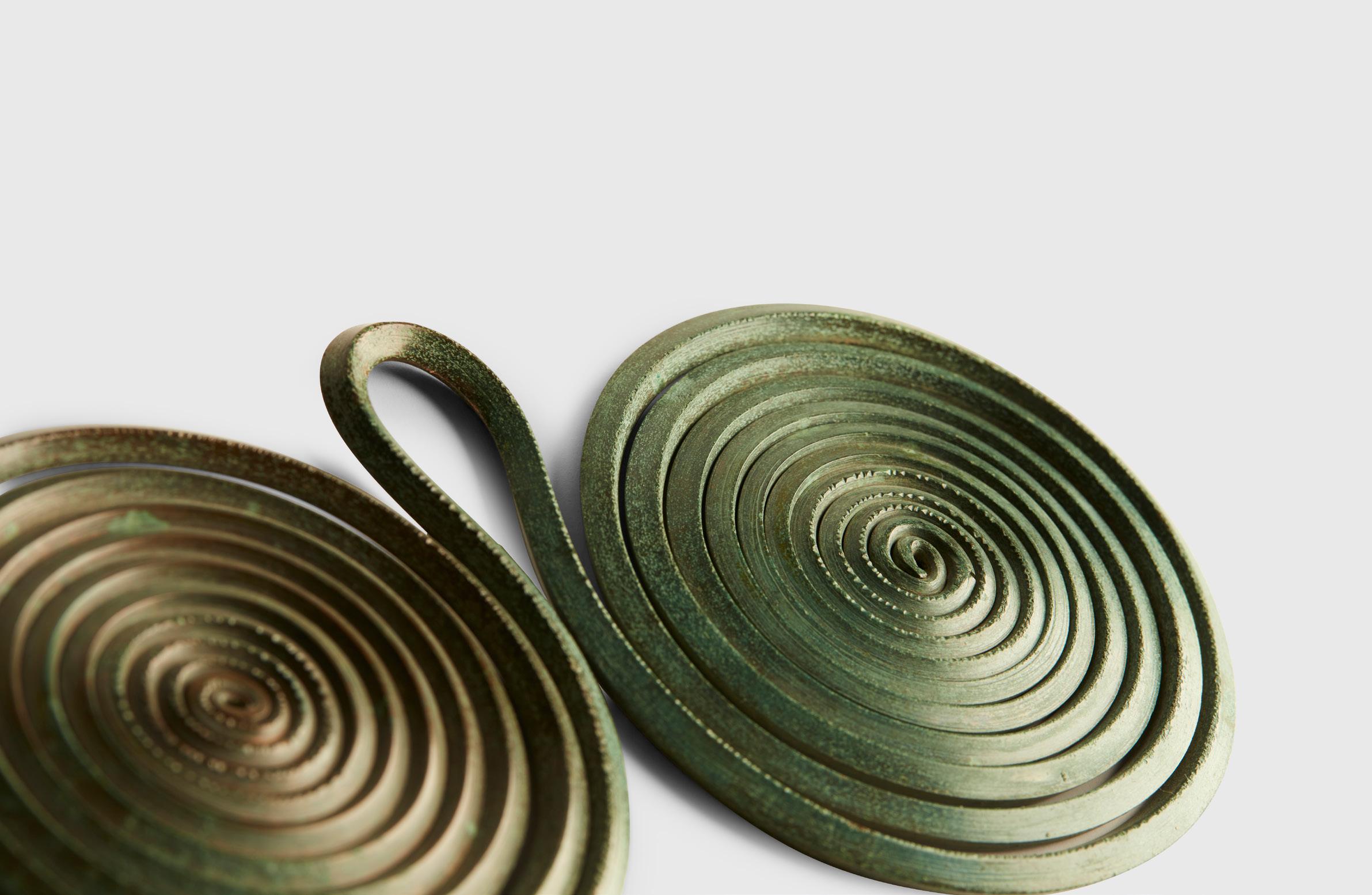
16.7cm diameter
£3,000-5,000
19
30
PALMYRIAN RELIEF OF A LADY
NEAR EAST, 1ST - 3RD CENTURY A.D.
carved limestone, the female figure is shown adorned in a draped attire secured with a fine brooch on her left shoulder, the folds of the garment finely denoted, she is shown facing the viewer with a frontal view, the hair is partially concealed by a headscarf falling across the back, the large almond eyes are marked with incised circles to denote the iris and pupils, the lips slightly pursed, raised on a bespoke mount (1)

50cm high
Provenance: Previously in the Private Collection of an artist (d.2002), Loiret, France, purchased in the 1950 or 60s locally, displayed in the garden where it was kept for decades.
Sold at: Une collection oubliée, et à quelques amateurs (2ème partie), Metayer, 6th February 2022, Lot 522 (accompanied by French cultural passport 234530).
ALR: S00224380, with IADAA Certificate, this item has been checked against the Interpol database.
Note: The present piece is a monument that reflects the cultural and economic prosperity of Palmyra, an ancient caravan city in the Near East, during the first three centuries following the birth of Christ. This type of relief, featuring a representation of the deceased accompanied by a brief identification inscription, was typically used to adorn and seal burial niches in highly decorated communal tombs. The half-length or bust format of such reliefs gained in popularity towards the second half of the first century A.D.
£5,000-8,000
20 Other fees apply in addition to the hammer price: see the ‘Buyer’s Guide’ section on page 2

ANCIENT SABAEAN ARABIAN MALE HEAD
SOUTHERN ARABIA, C. 1ST CENTURY B.C.
carved striped alabaster, the slender neck rising to a rounded chin, the face bearing a compact mouth, the upper lip topped with a small moustache, the ridge nose parting two almond shaped eyes below a sweeping incised brow, raised on a bespoke mount 20.9cm tall (excluding stand)

Provenance: Previously in the Private Collection of Mr François Antonovich (b. 1934), Paris Renowned dealer and expert François Antonovich (b. 1934), who spent much of his childhood in Cairo before setting up his gallery in Paris, assembled, from as early as 1964, a collection of South Arabian artefacts which has been known to scholars in the field for decades.
Published: Treasures from Ancient Yemen: On the Legendary Road of the Kingdom of Sheba, c. 1997, no. 1 (illus. and cover)
Exhibited: Yémen, au pays de la reine de Saba, Institut du Monde Arabe, Paris, 25th October 1997 – 28th February 1998
Kunst und Archäologie im Land der Königin von Saba, Kunsthistorisches Museum, Vienna, 9th November 1998 – 21st February 1999
Yemen Nel paese della regina di Saba, Palazzo Ruspoli, Fondazione Memmo, Rome, 6th April 2000 – 30th June 2000
’La Regina di Saba, Arte e Leggenda Dallo Yemen’ Palazzo Bricherasio, Turin, 26th September 2000 – 30th June 2001
Note: The present piece is a fine example of the distinctive, enigmatic sculpture produced by the wealthy south Arabian kingdoms at the turn of the first millennium B.C. With the facial features stripped to the essence of form, it served as a votive object, and was intended to fit within a small rectangular niche within a ritual site, hence the flattened top of the head.
£4,000-6,000
31
22 Other fees apply in addition to the hammer price: see the ‘Buyer’s Guide’ section on page 2
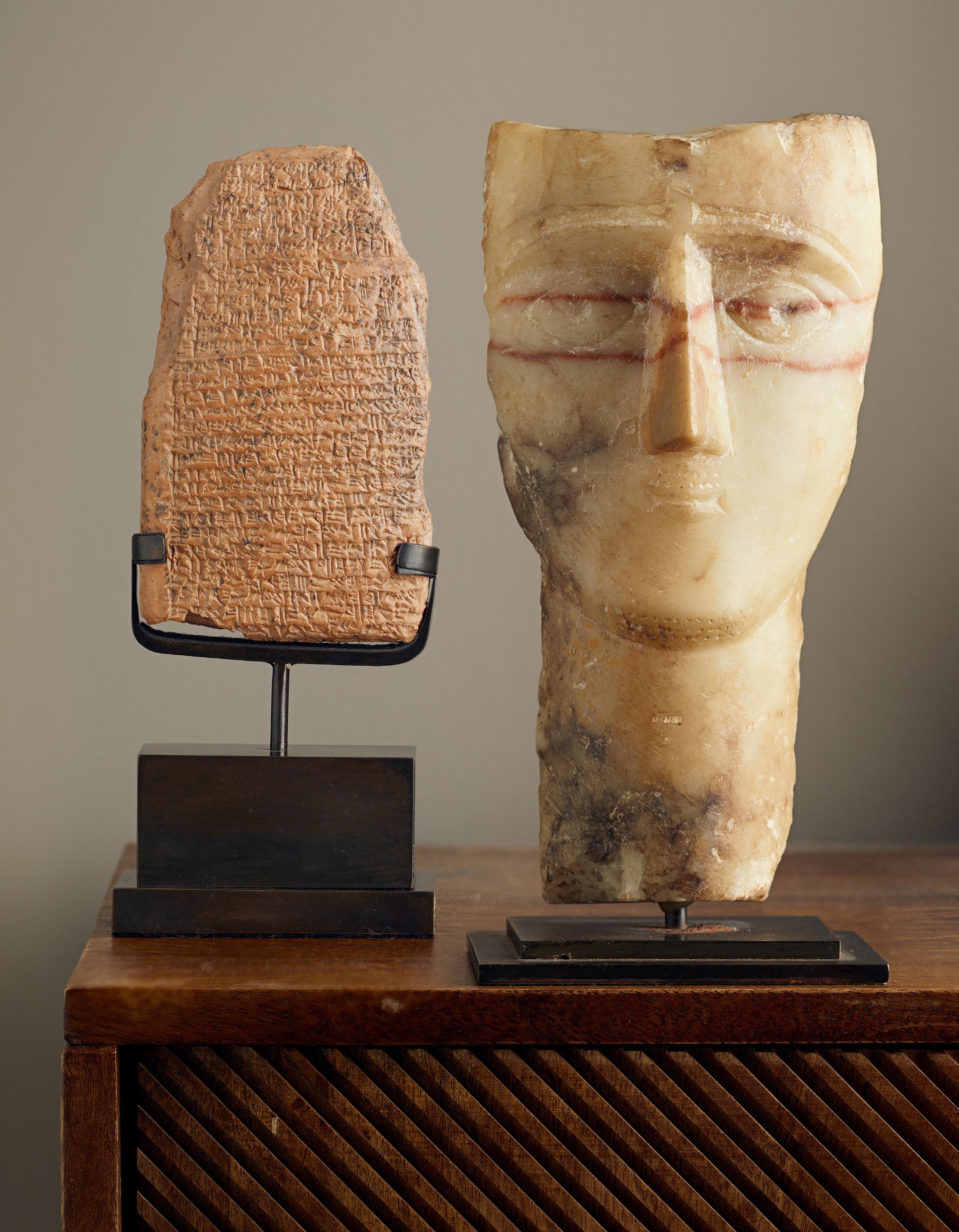
Their original use is a matter of modern debate, though many scholars believe the earliest such “idols” were in fact counterweights used for pounding the agricultural produce that was the backbone of the Oxus economy. Their use may have subsequently developed to the purely ritual, as later examples are found to be less appropriate for practical use.
Regardless of their original purpose, these stone idols have an element quality that speaks to a modern aesthetic.
BACTRIAN ALABASTER DISC IDOL BACTRIA–MARGIANA, C. LATE 3RD/EARLY 2ND MILLENNIUM B.C.
carved and polished alabaster, the banded stone shaped with rounded edges, bisected by a shallow groove 29cm diameter
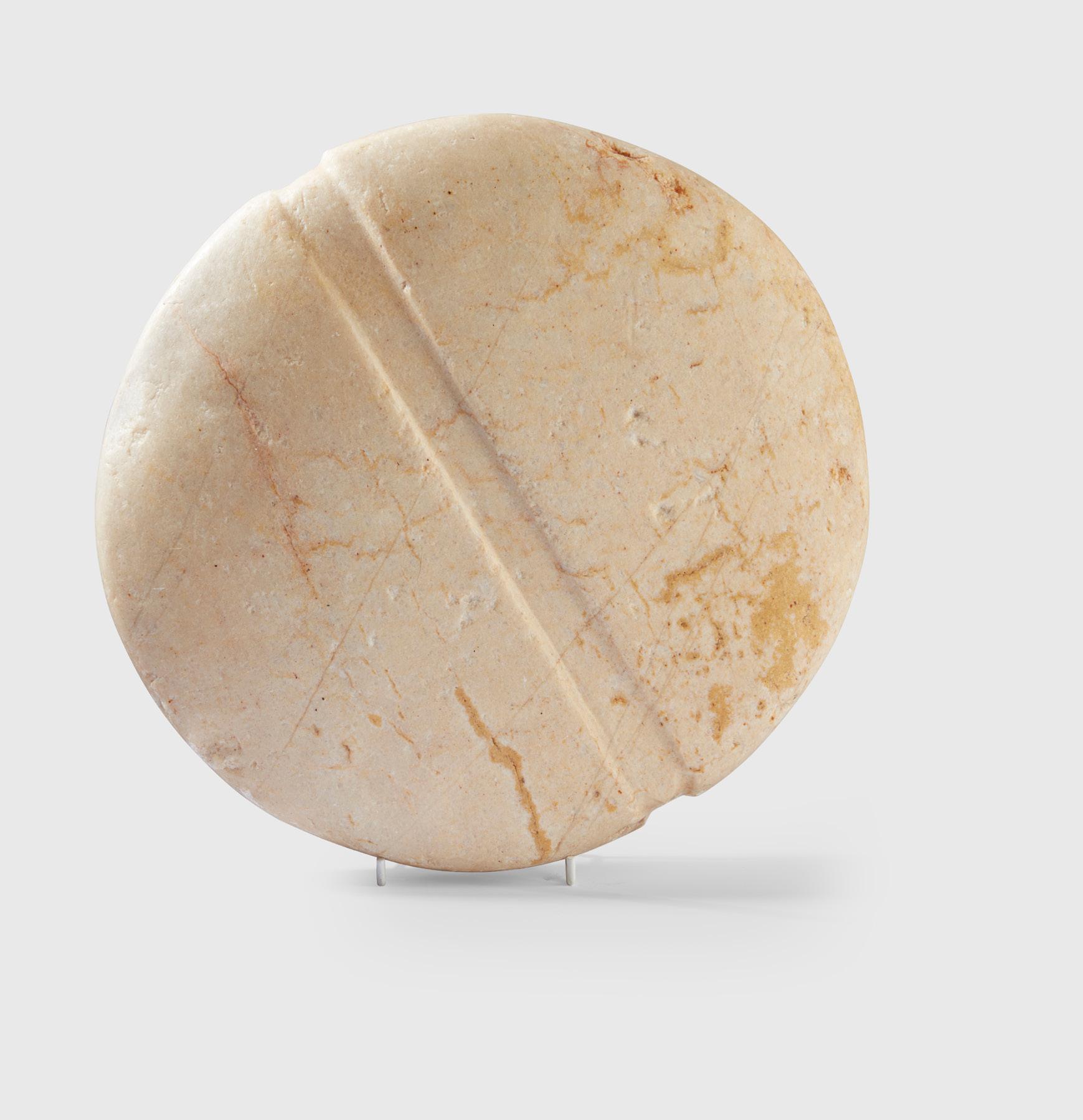
Provenance: Private collection, formed 1960s - 1970s, thence by descent
£1,000-1,500
BACTRIAN ALABASTER DISC IDOL BACTRIA–MARGIANA, C. LATE 3RD/EARLY 2ND MILLENNIUM B.C.
carved and polished alabaster, the cream stone shaped with rounded edges, bisected by a shallow groove 31.2cm diameter

Provenance: Private collection, formed 1960s - 1970s, thence by descent

£2,500-3,500
With a powerful simplicity of form, these enigmatic stone idols were produced by artisans of the Bactrian (or Oxus) culture, an ancient civilization that flourished between the 3rd and 2nd millenniums B.C., occupying a large area between India and Afghanistan.
32
33
24 Other fees apply in addition to the hammer price: see the ‘Buyer’s Guide’ section on page 2
BACTRIAN ALABASTER CHALICE
BACTRIA–MARGIANA, C. LATE 3RD/EARLY 2ND MILLENNIUM B.C.
carved alabaster, standing on a tall stem on a conical foot, the cylindrical bowl tapering subtly and with an out turned rim, the stone with white veining throughout 28.6cm tall
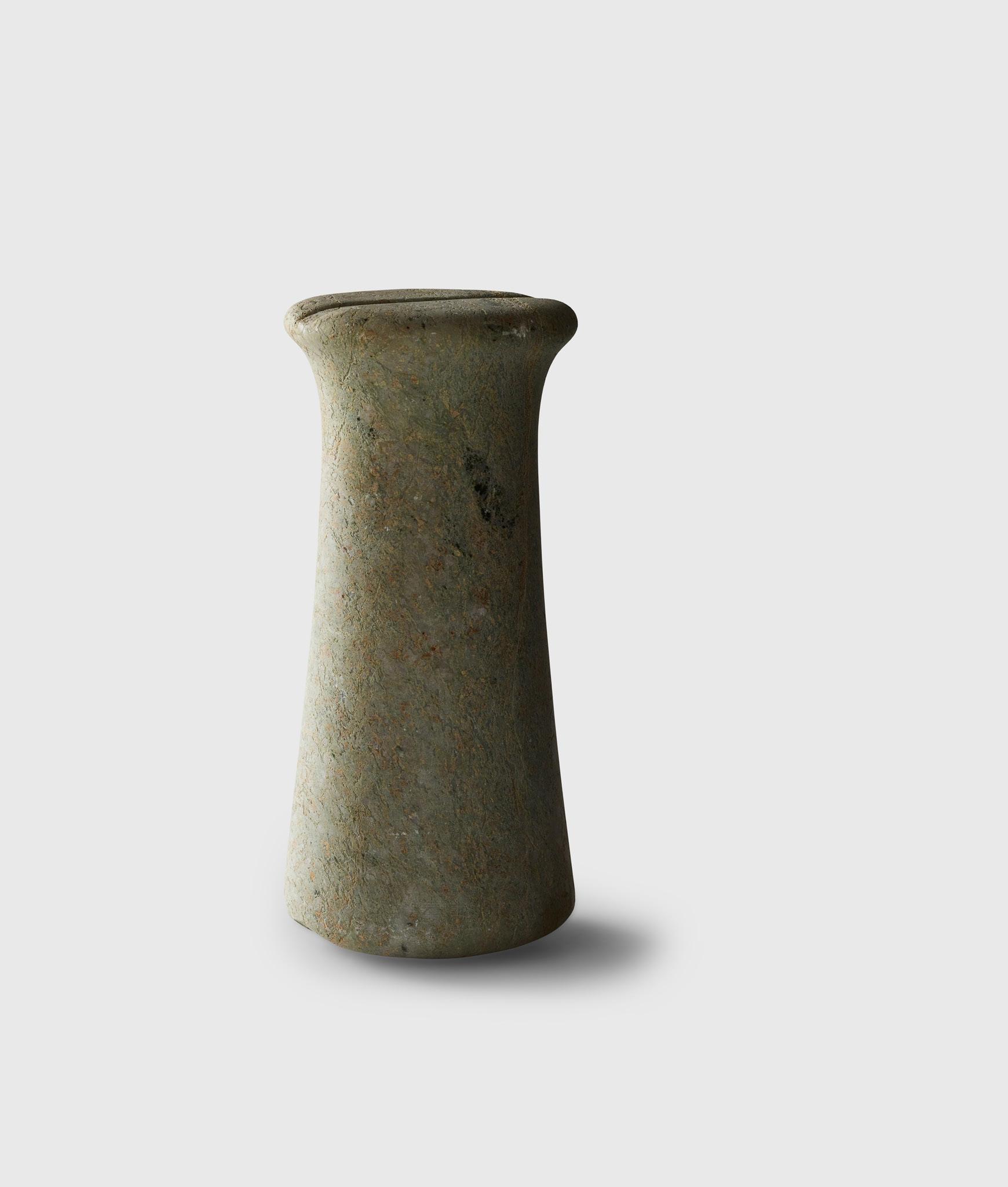
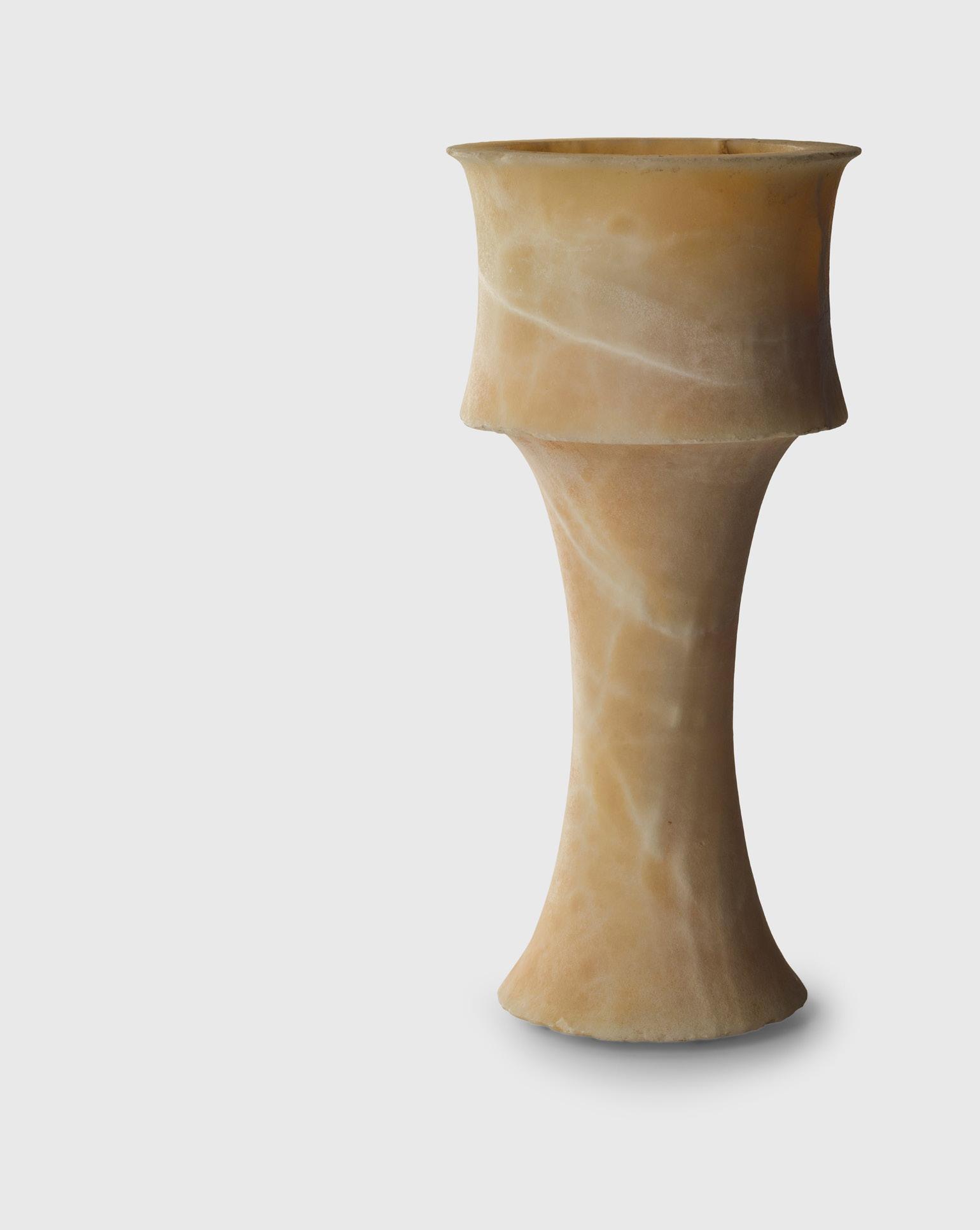
Provenance: Acquired Gallery Rosen, Tel Aviv, 18th June 1969 (copy of the original invoice available). Subsequently in the K.M. Collection, London.
£2,000-3,000 35
BACTRIAN STONE COLUMN IDOL
BACTRIA–MARGIANA, C. LATE 3RD/EARLY 2ND MILLENNIUM B.C.
carved green marble, standing on a rounded base, cylindrical form, gently tapering at the neck, with a shallow groove at the top
23.1cm tall
Provenance: Acquired Gallery Rosen, Tel Aviv, 1960. Subsequently in the K.M. Collection, London.
£600-900
EGYPTIAN ALABASTER VESSEL
EGYPT, EARLY DYNASTIC PERIOD OR LATER
carved and polished alabaster, standing on a flat base, the tall cylindrical vessel slightly waisted and with an out-turned lip
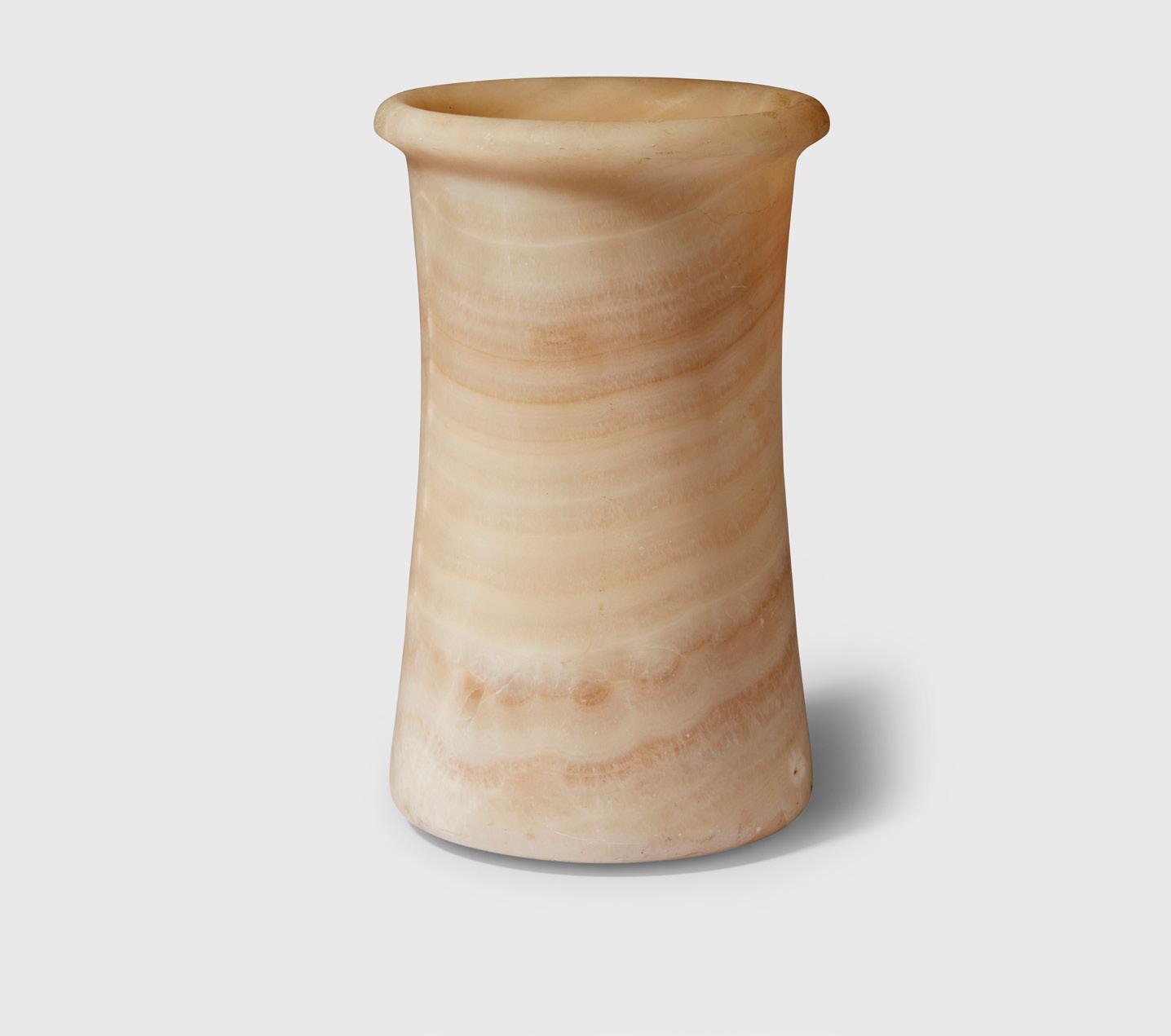
24cm tall
Provenance: Private collection, London, United Kingdom, formed 1965 - 2020
£500-800
ACHAEMENID PERSIAN STONE FOOTED DISH

WESTERN ASIA, 5TH CENTURY B.C.
carved and polished stone, standing on a tapering cylindrical foot, the shallow walls with ridged lip
12cm diameter
Provenance: Private collection, London, United Kingdom, formed 1965 - 2020
£200-300
37
34
36
25
SABAEAN ALABASTER BULL STELE
SOUTHERN ARABIA, C. 3RD CENTURY B.C. - 1ST CENTURY A.D. carved alabaster, of trapezoidal form, carved in high relief with a central head of a bull with incised features, raised on a bespoke mount (1) 27cm high

Provenance: Hirsch Auction, 23rd September 2008, lot 257 Private Collection of Mr. L.
Note: For a similar example please see: The British Museum, London, accession number 130884.
The bull was an important symbol in the ancient Kingdom of Saba, located in modern-day Yemen. The Sabaean people believed that bulls represented strength, fertility, and prosperity, and they incorporated this powerful animal into their art and culture. Sabaean bull sculptures were often placed in prominent locations such as temples and public spaces, and they were believed to bring good fortune and protection to the community. The bull was also associated with the Sabaean deity Almakah, who was believed to be the goddess of agriculture and fertility.
£4,000-6,000
38
26 Other fees apply in addition to the hammer price: see the ‘Buyer’s Guide’ section on page 2
39
BABYLONIAN CLAY CUNEIFORM TABLET
SOUTHERN MESOPOTAMIA, C. 1303 - 1282 B.C.
baked and impressed terracotta, the Middle Babylonian legal document with 31 lines divided into three section by rulings, reading as follows: raised on a bespoke mount

14cm high unmounted
Provenance: Private “L” collection, North London, previously with an international collection prior to 1992
£3,000-5,000
40
NABATEAN DISH
NEAR EAST, 1ST CENTURY B.C. - 1ST CENTURY A.D.
painted terracotta, standing on a rounded base, the shallow walls leading to an inverted rim, of dark red-orange colour and with umber painted vegetal decoration
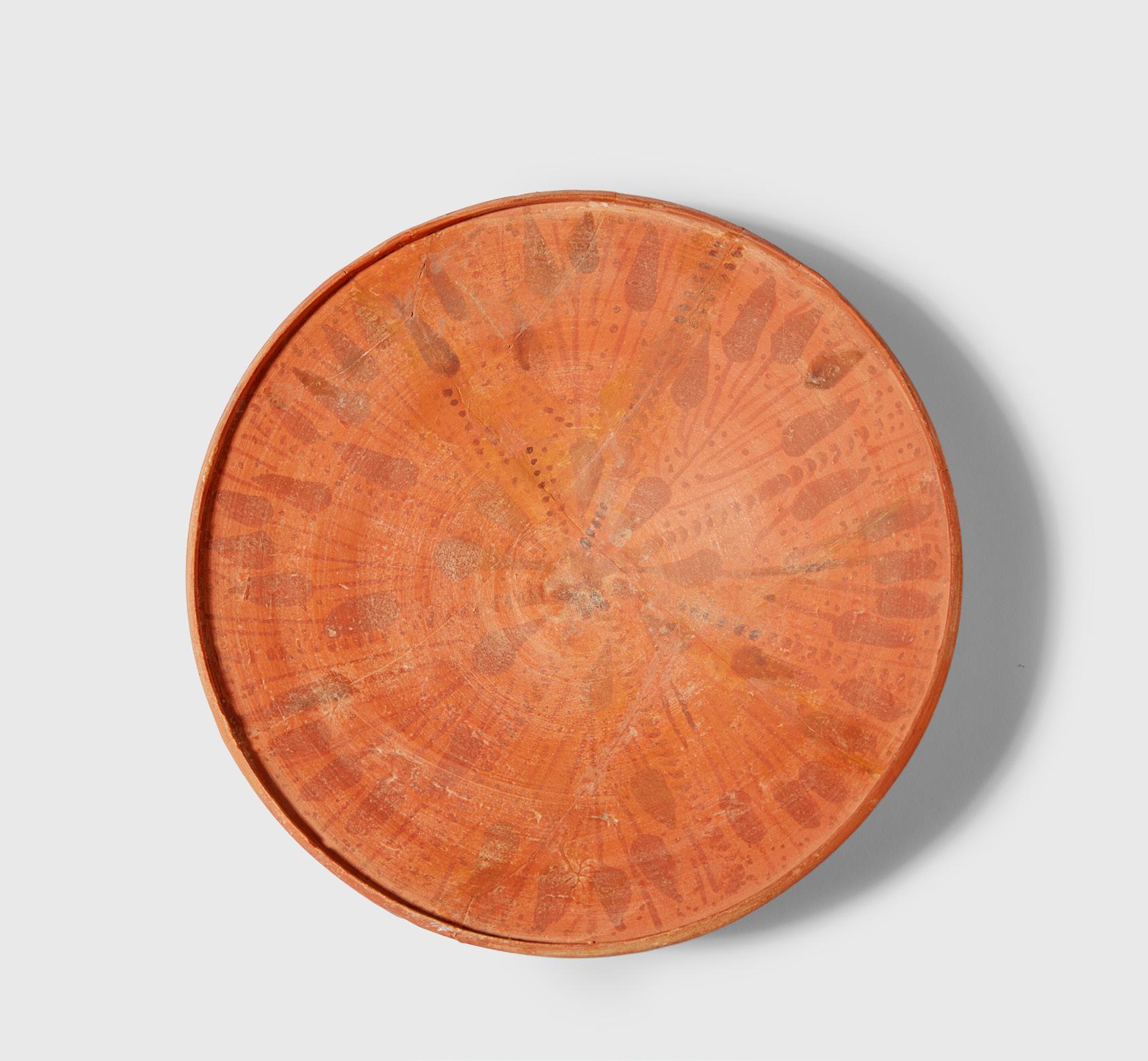
18.9cm diameter
Provenance: From an important collection of Nabatean pottery formed over a number of decades, Geneva
Private collection, United Kingdom, acquired from the above
Note: For a similar example, please see: The Metropolitan Museum of Art, New York, accession number 1977.234.12
£600-900
In discussing the piece referenced above, The Metropolitan Museum (2023) writes:
”The very thin painted ware so closely identified with Nabataean culture began to appear in the first century B.C. It reflects the influence of Hellenistic wares, but because its shapes, colors, and decoration are unique, it forms a distinct type and was recognized early on as an accurate indication of Nabataean presence. Found primarily in southern Nabataea, the pottery has also turned up in the ports of Oman and Yemen, along the eastern coast of the Arabian Peninsula, and along the Incense Route. Nabataean painted ware is usually decorated with floral motifs. It has been suggested that Nabataean painted ware was deliberately broken after use in religious ceremonies; the ware has also been connected with cultic meals for the deceased.”
27 Other fees apply in addition to the hammer price: see the ‘Buyer’s Guide’ section on page 2
INUIT THULE FIGURE

ALASKA, 1ST MILLENNIUM A.D. carved marine ivory, with a rectangular body and a disproportionally large head, heavily weathered, raised on a bespoke mount 18cm tall
Private collection, United States, acquired 1970s Private collection, London, United Kingdom, acquired from the above £2,000-2,500

41
28
ANCIENT BACTRIAN FIGURAL IDOL

BACTRIA-MARGIANA, C. LATE 3RD - EARLY 2ND MILLENNIUM B.C. carved chlorite and limestone, an abstract depiction, the figure shown standing, the body of broad proportions, wearing a thick garment obscuring the legs, the arms outstretched, the neck and head formed of a cylinder of white limestone, the eyes and nose denoted 8.2cm high £3,000-4,000
LARGE NOK FIGURE
NIGERIA, 500 B.C. - 200 A.D.
terracotta, the male figure shown bearded, with elaborate coiffure, the right arm (now lost) is raised, with the left arm placed on the bent knee 61cm tall

Provenance: Cannes Encheres February 2012, lot 474
Private United Kingdom collection, acquired at the above
Note: Accompanied by a thermoluminescence test report conducted by Oxford Authentication
The Nok culture was one of the earliest developed civilizations to arise in West Africa. It existed in modern-day Nigeria from around 500 B.C. to 200 A.D. It appears to have been agrarian in nature and is today best known for the high quality terracotta sculpture it produced, of which the present piece is a fine example.
Nok sculptures have been found across a vast area covering over 30,000 square miles, suggesting this civilisation, or at least the material culture it produced, was exceedingly large.
£2,000-3,000
42
43
29 Other fees apply in addition to the hammer price: see the ‘Buyer’s Guide’ section on page 2
The city of Sais and the rulers of Dynasty 26 revered Neith as their patron goddess, who possessed attributes of both a war deity and a powerful creator goddess. As expected, there was a surge in the production of copper statues depicting the goddess during this period. The particular piece in question showcases the facial features typical of mid-Dynasty 26, as well as the Saite female figurative style which emphasized a robust bosom and slender hips.

44
ANCIENT EGYPTIAN BRONZE STATUE OF THE GODDESS NEITH
EGYPT, LATE PERIOD, C. 664 – 525 B.C.
cast bronze, figure of Neith depicted wearing the red crown, the left arm lost above the elbow, right arm down, the hand originally holding an ankh-sign, the eyes recessed for inlay, standing upon a base with a partially eroded hieroglyphic inscription, raised on antique base reading 26cm tall

Provenance: Private collection, northeast England, acquired 1920’s - 1940’s, thence by descent. A short letter detailing the provenance will be provided to the successful bidder
Note: For a similar example please see: The British Museum, London, accession number EA64496. £10,000-15,000
45
ANCIENT EGYPTIAN SHABTI FOR KHAEMWASET, SON OF RAMESES II
EGYPT, NEW KINGDOM DYNASTY XIX, CIRCA 1250 - 1230 BC
the blue faience ushabti mummiform figure wears a broad collar, a short wig with a side lock of hair, typical for a Sem Priest, his crossed hands hold hoes and a seed bag hangs from the back, a vertical inscription is painted on the front reading, “The illuminated one, the Osiris, Sem Priest of Ptah, Son of the King (Prince), Khaemwaset”

15cm high (excl. stand)
Provenance: Bertolami Sale 66 Lot 158
Previously with Hixenbaugh Ancient Art (New York, 2014)
Formerly in the collection of Leopoldo Benguerel y Godo, Barcelona, acquired in London in the 1960’s. Note: The shabti has been dated by means of a Thermoluminescence analysis carried out in May 2014 by Ralf Kotalla, an independent German Laboratory. The TL certificate with its full report will accompany this lot. In addition a more recent analysis was carried out by Oxford Authentication in 2022 (with accompanying certificate).
£1,500-2,500
31 Other fees apply in addition to the hammer price: see the ‘Buyer’s Guide’ section on page 2

BACTRIAN STONE FEMALE “PRINCESS” IDOL
BACTRIA-MARGIANA, C. LATE 3RDEARLY 2ND MILLENNIUM B.C.
carved chlorite and limestone, the figure formed of two parts, shown seated, the voluminous dress enveloped with layered kaunakes, the arms and hands hidden within the folds, the entire garment is covered with hatching, tufts can be seen at the shoulders, the head formed of carved limestone, the figure wears a serene expression with a subtle smile 10cm tall

Private collection, Mr. D.S., United Kingdom, originally acquired between 1985 - 1990 Private collection, London, United Kingdom, acquired from the above 2014 £12,000-18,000
Amongst the most striking examples of figural sculpture surviving from the Oxus (Bactrian-Margiana) Civilisation of ancient Central Asia, these enigmatic figures known as “Princess Idols” were clearly of significance, yet their exact purpose remains unclear.
Seals found further to the southwest engraved with similar likenesses confirm the clear relationship between these Bactrian statuettes and Elamite art. One such seal even depicts a queen wearing the same characteristic kaunakes garment. The elaborate dress and grandeur of the Bactrian statues have long led scholars to believe they may depict women from the aristocracy. However, there is no conclusive
evidence to support this theory. Another possibility is that these figures represent goddesses who maintained the balance of natural forces. Despite the enigmatic nature of their meaning, these statues are considered among the most aesthetically pleasing remains of the Oxus civilisation.
Muscarella (2003:368) writes, “attempts have been made to interpret these figures as deities or prominent humans, but insufficient information exists to permit a satisfactory conclusion. There is no doubt, however, that they are charged beings, physically massive but projecting a calm power and authority.”
46
33 Other fees apply in addition to the hammer price: see the ‘Buyer’s Guide’ section on page 2
LURISTAN BRONZE DEER FIGURE
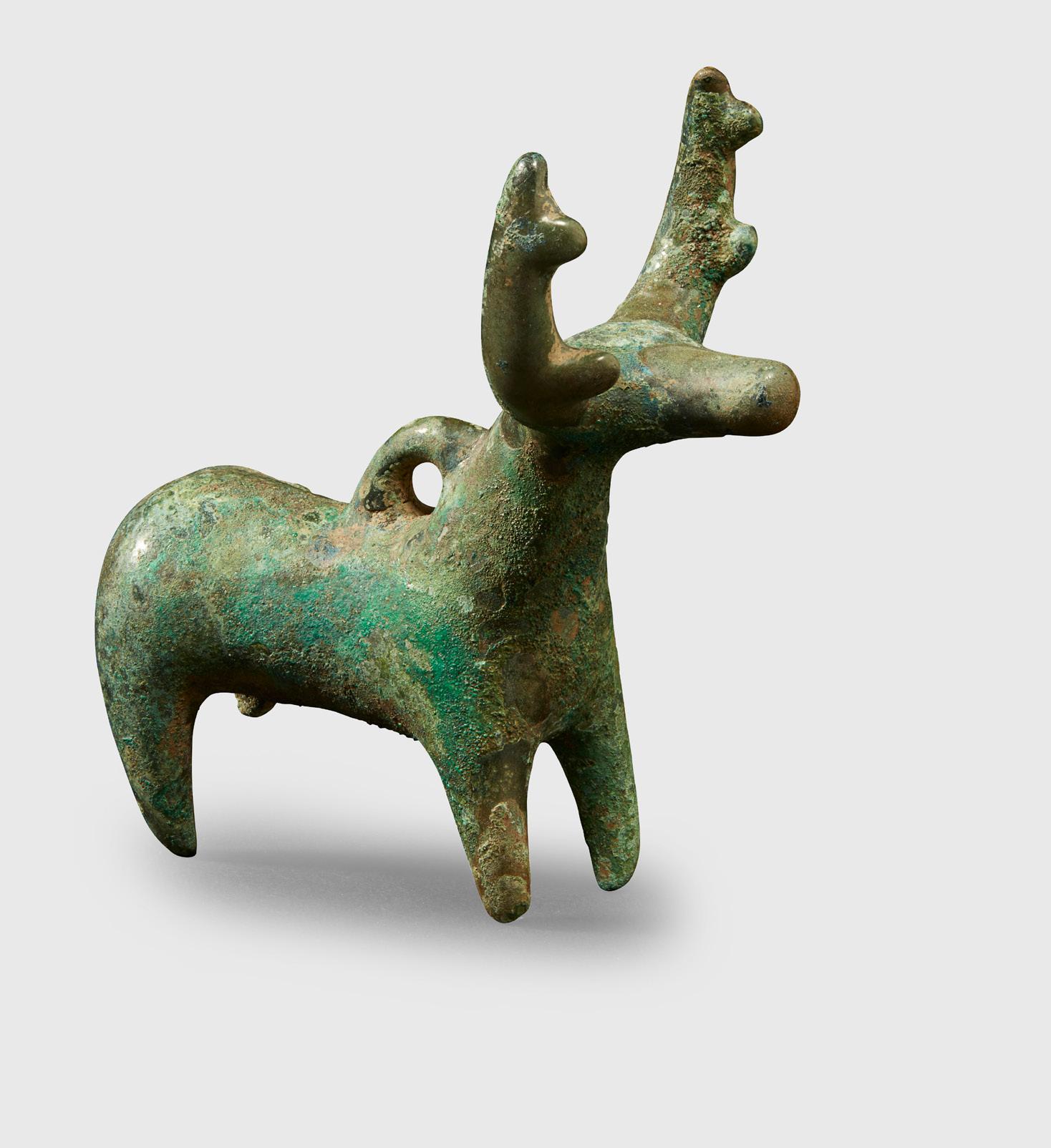
NEAR EAST, C. EARLY 1ST MILLENNIUM B.C. cast bronze, the standing animal reduced to the essence of form, the head subtly upturned with broad antlers curling upwards, the back and neck joined by an integral loop 6.9cm long
Provenance: Private collection, Belgium
Ralph I. Chait Gallery, Los Angeles
£1,000-1,500
ANCIENT ARABIAN BRONZE IBEX SOUTHWESTERN ARABIA, C.

500 B.C.
cast bronze, the animal shown standing in a state of alertness, with it’s elegant curled horns reaching back to the upright ears, the tail raised, accompanied by a bespoke mount
7.5cm high, 4.3cm long (excluding stand)
Provenance: Property of a London collector, acquired 1990s-2000s Timeline Auctions, London, 3rd September 2019, lot 108
Note: For a similar example please see: The Metropolitan Museum, New York, accession number 53.47.2
The Metropolitan Museum (2023) describes a similar piece in their collection as follows:

”The ibex was the most widely represented animal in southwestern Arabian art. Ritual ibex hunts were an important feature of the cult practices of the southwestern Arabian kingdoms. Successfully capturing and killing these elusive creatures was believed to secure favors from the gods.
This sculpture may have served as a handle for an incense burner similar to one in the Museum’s collection (MMA 49.71.2). From the middle of the first millennium B.C. until the sixth century A.D., the kingdoms of southwestern Arabia gained considerable wealth and power through their control of the trade in incense between Arabia and the lands of the Mediterranean seacoast. Frankincense and myrrh, gum resins that are native to southern Arabia, were widely valued in the ancient world for the preparation of incense, perfumes, cosmetics, and medicines, as well as for use in religious and funerary ceremonies.”
£1,000-1,500
48
47
34 Other fees apply in addition to the hammer price: see the ‘Buyer’s Guide’ section on page 2
49
LARGE ELAMITE COPPER EAGLE
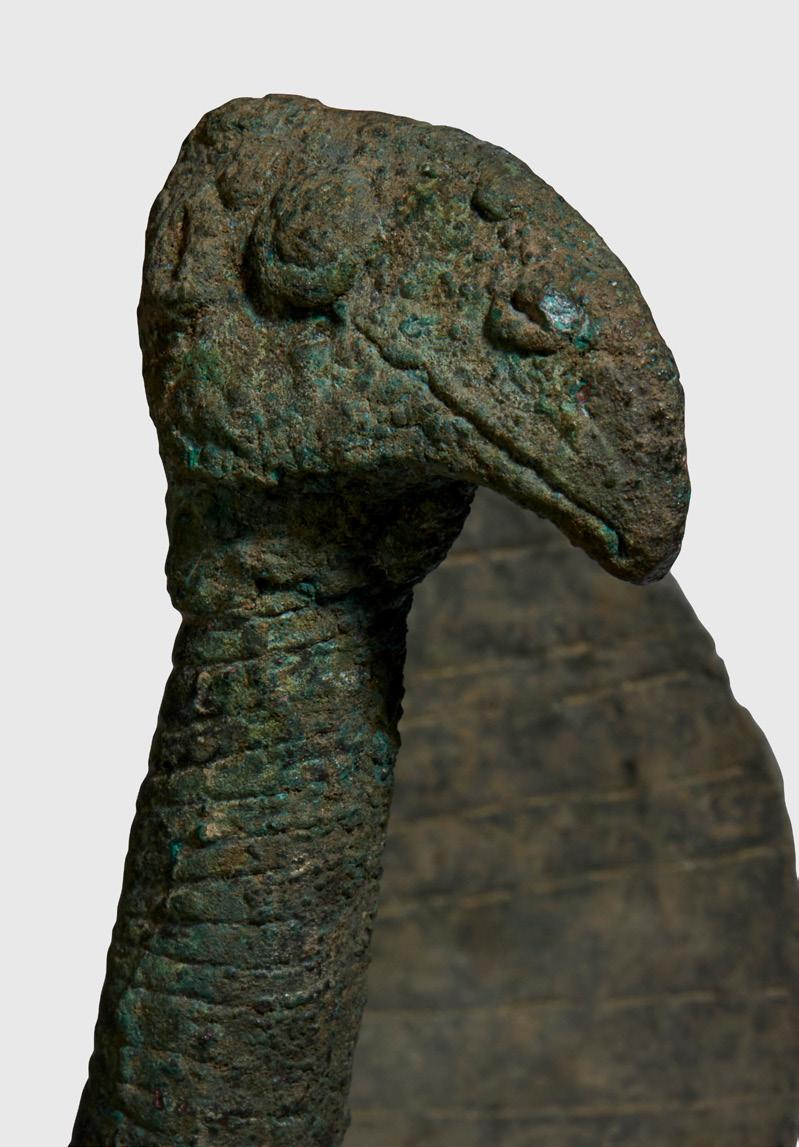
NEAR EAST, C. LATE 3RD MILLENNIUM B.C. statuette of an eagle with slender tubular legs equipped with four claws, a long cylindrical neck, round eyes in relief, engraved plumage and whose tail and outstretched wings are formed of thin bronze plates
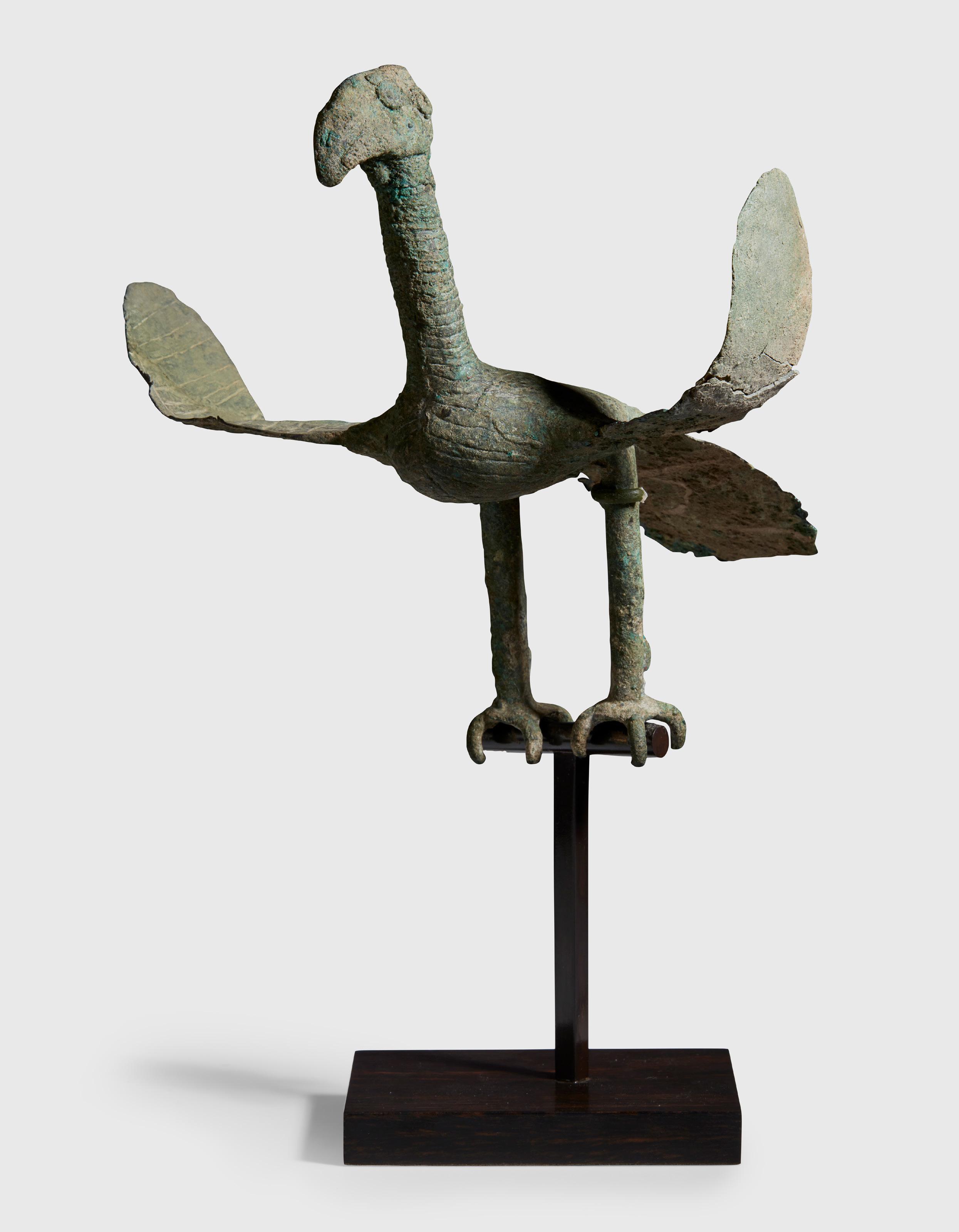
21cm high
Provenance: Private collection, United Kingdom, acquired 1970s
£7,000-9,000
35

36 Other fees apply in addition to the hammer price: see the ‘Buyer’s Guide’ section on page 2
LARGE WOOLLY MAMMOTH TUSK, MAMMUTHUS PRIMIGENIUS

SIBERIA, PLEISTOCENE C. 80,000 - 10,000 YEARS B.P. a large and fine mammoth tusk, polished and raised on a bespoke mount
124cm long
£7,000-9,000
50
37
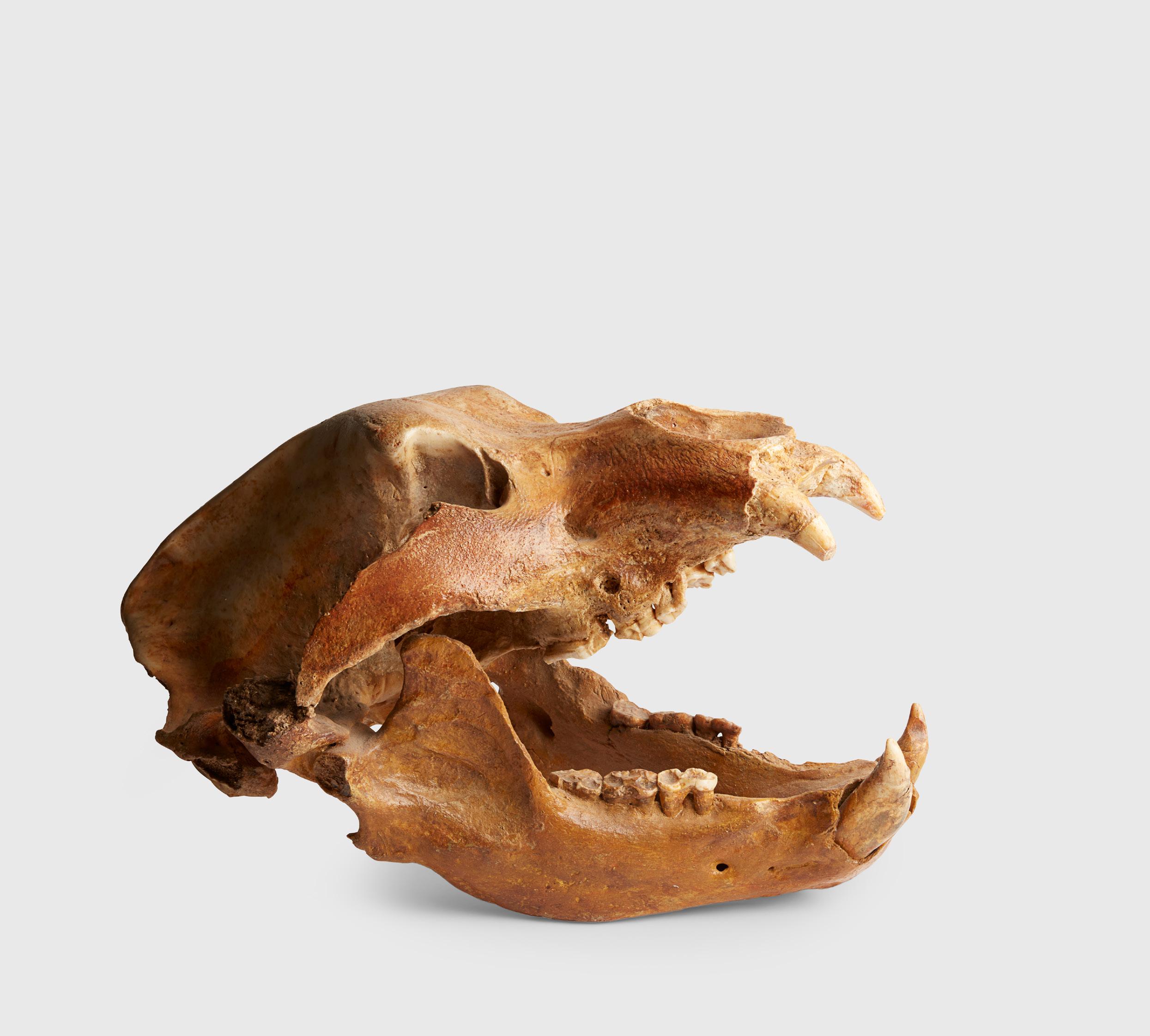

38 Other fees apply in addition to the hammer price: see the ‘Buyer’s Guide’ section on page 2
51
EXCEPTIONALLY LARGE PARTIAL MAMMOTH TUSK NORTH SEA, PLEISTOCENE PERIOD, 50,000 YEARS BP
a central portion of very large woolly mammoth Mammuthus primigenius tusk, displaying a rich caramel colour and marbled appearance, raised on a bespoke mount
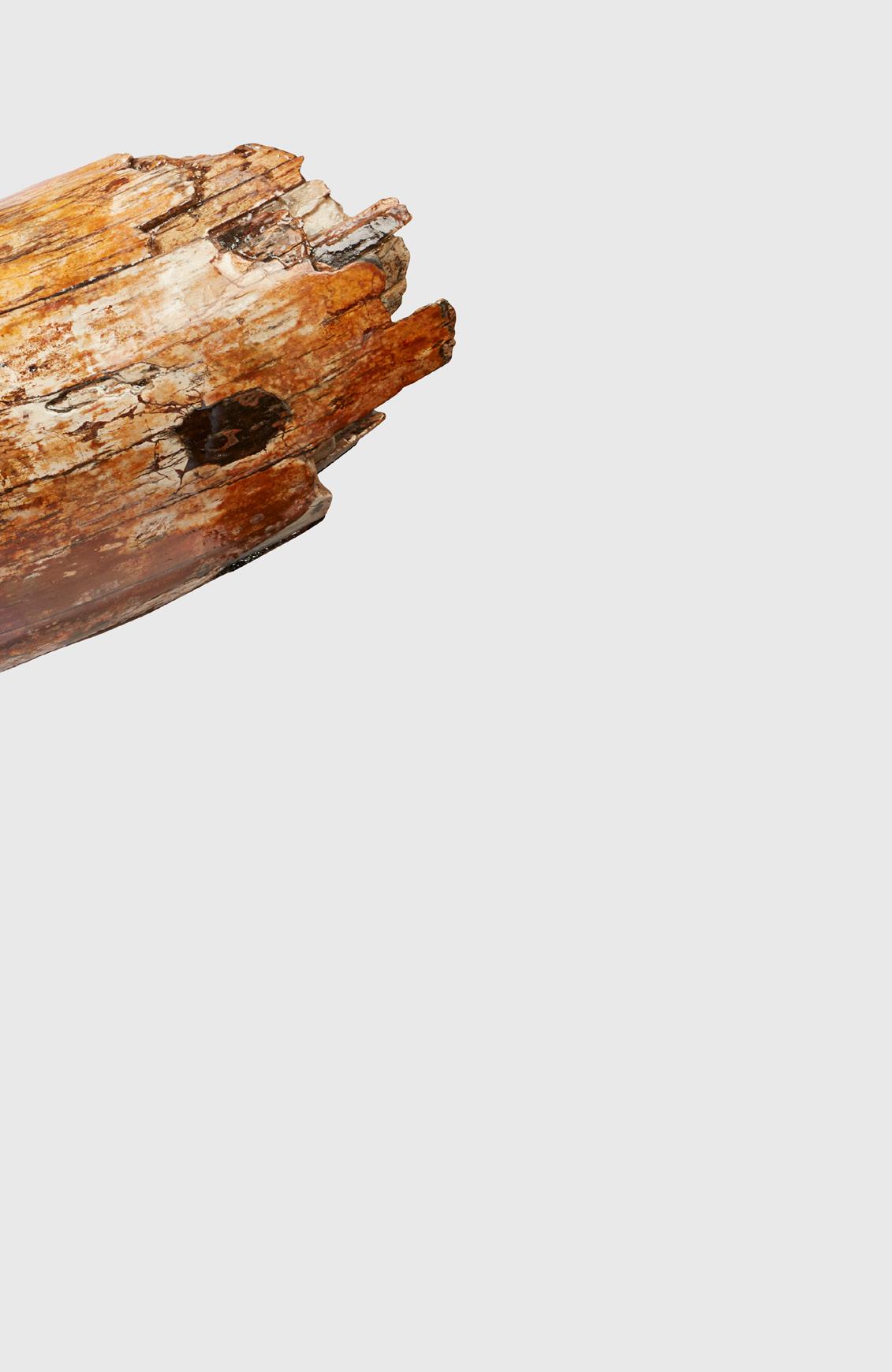

WOOLLY MAMMOTH TIBIA NORTH SEA, PLEISTOCENE, C. 100,000 B.P
a large and impressive woolly mammoth (mammuthus primogenus) tibia dredged from the North Sea, raised on a bespoke wooden mount
77.6cm high
94cm long
£4,000-6,000
£3,000-5,000 53
SKULL OF A EUROPEAN CAVE BEAR EUROPE, 100,000 - 20,000 YEARS B.P. skull with adjoining mandible and a well preserved set of teeth from an adult cave bear (Ursus spelaeus)
47.5cm long
£2,000-2,500
52
39
54
LARGE MEGALODON TOOTH INDONESIA, MIOCENE PERIOD, 15 MILLION YEARS B.P.

a tooth from Otodus megalodon with intact serrations throughout 13.8cm long £2,000-2,500
55
PETRIFIED WOOD TRUNK SECTION, DIPTEROCARPUS SP. WEST JAVA, INDONESIA, MIOCENE, 20 MILLION YEARS B.P. cut and polished, displaying warm and rich colouration, the ring system visible
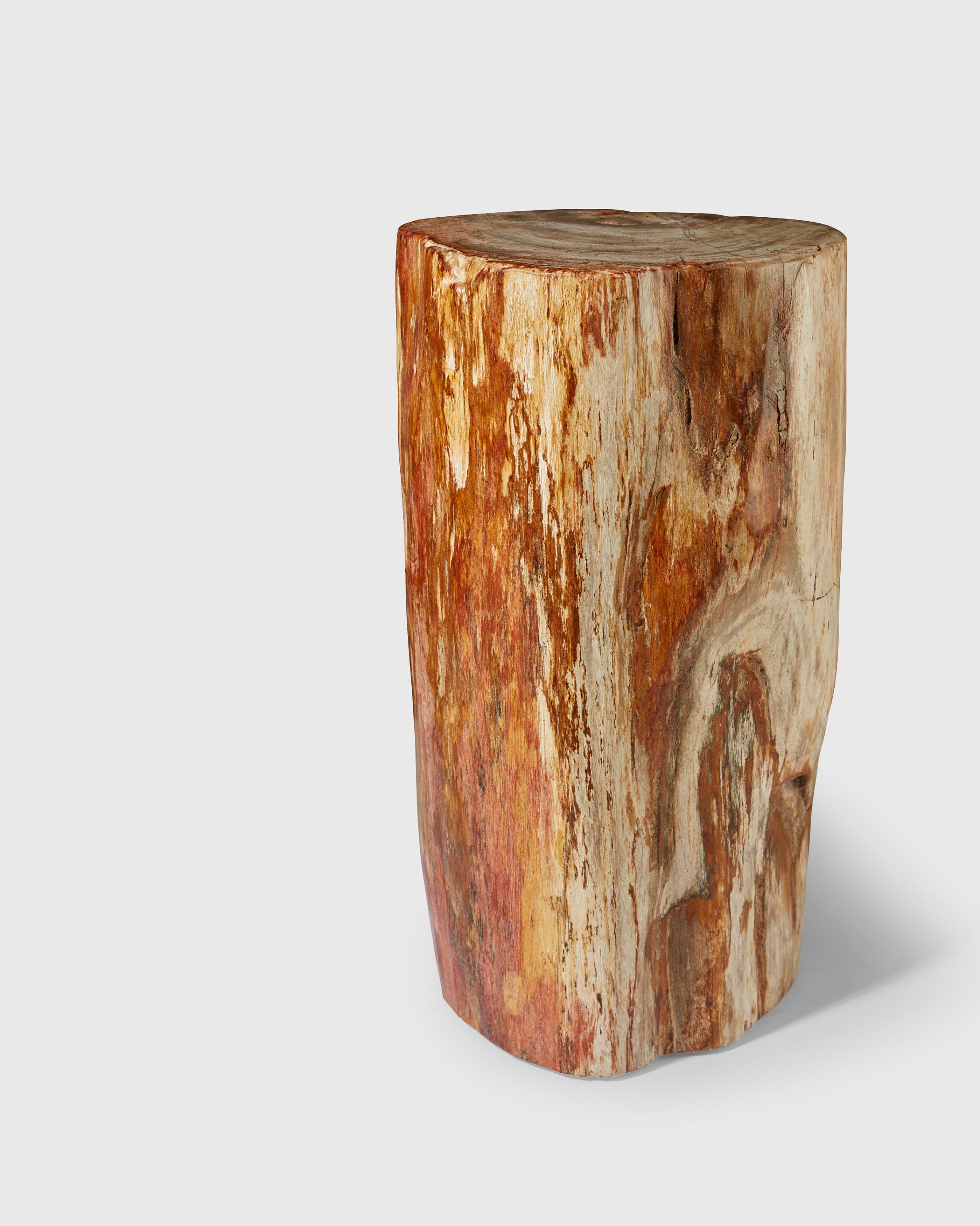
41.5cm high £600-900
56
FINE PARAREPTILE FOSSIL, BARASAURUS BESAIRIEI MADAGASCAR, LATE PERMIAN - EARLY TRIASSIC, 257250 MILLION YEARS B.P.
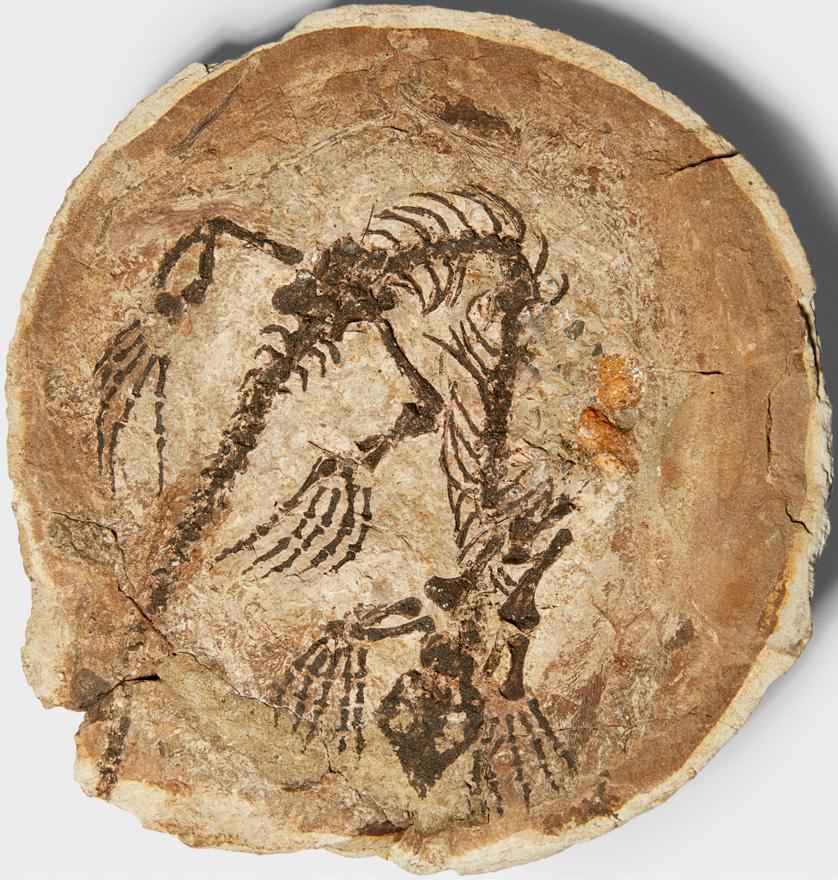
a particularly fine barasaurus besairei specimen, with both halves showing excellent detail
18cm diameter
Note: See right for detail of reverse side £2,000-3,000
40 Other fees apply in addition to the hammer price: see the ‘Buyer’s Guide’ section on page 2

58
LARGE CRINOID SEA-BED PLAQUE MOROCCO, UPPER SILURIAN, C. 420 MILLION YEARS B.P.

the plaque displaying a large number of Scyphocrinus elegans in their original matrix in an impressive state of preservation
1.3m x 78cm
£2,000-2,500
57
JURASSIC FOSSIL DRAGONFLY SOLNHOFEN, GERMANY, JURASSIC PERIOD, C. 150 MILLION YEARS B.P. from the Jurassic (circa 150 million years ago) the finely preserved 6-inch specimen of Urogomphus eximus in original limestone matrix
£1,000-1,500

42 Other fees apply in addition to the hammer price: see the ‘Buyer’s Guide’ section on page 2
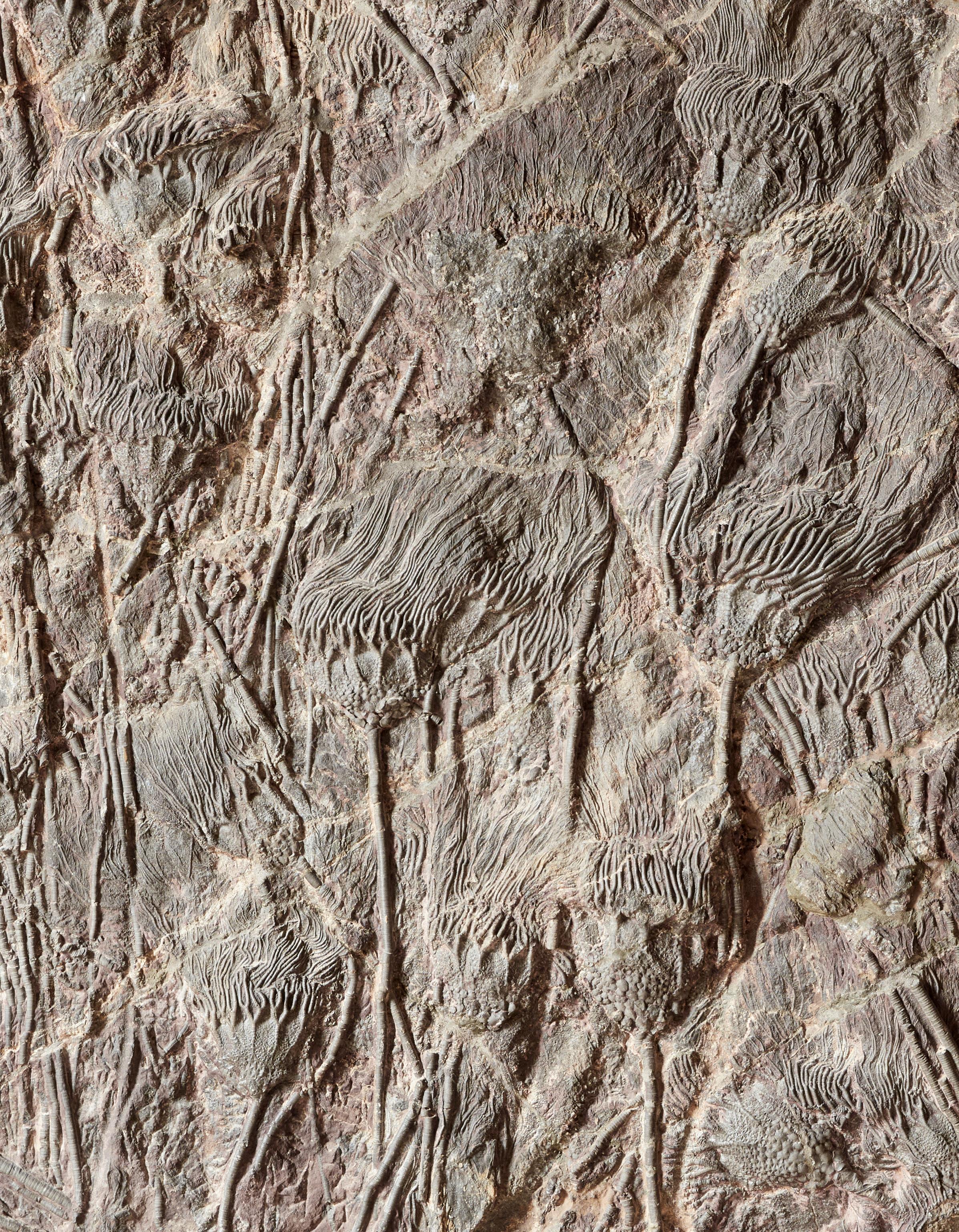
60

A NEAR COMPLETE ELEPHANT BIRD EGG MADAGASCAR, PLEISTOCENE PERIOD
a near complete specimen with all pieces from the same original egg, presented within a bespoke case

34cm high (excluding dome)
Note: The Elephant Bird, Aepyornis maximus, produced the largest egg of any animal that has ever lived, including the dinosaurs. Standing around ten feet tall and weighing half a tonne, the volume of an average Elephant Bird egg is equivalent to 160 modern chicken eggs. Native to Madagascar, the animal lived to well within human memory, only becoming extinct around 1200 AD. Indeed, during his travels to the east Marco Polo wrote of hearing tales from sailors about huge birds, these accounts are likely to describe the Elephant Bird.
£10,000-15,000
59
COCO DE MER
SEYCHELLES, INDIAN OCEAN, 19TH CENTURY (Lodoicia Maldivica), original bi-lobed coconut sculpted into a prestige handled container
25.5cm high, 24cm wide £600-800

44 Other fees apply in addition to the hammer price: see the ‘Buyer’s Guide’ section on page 2
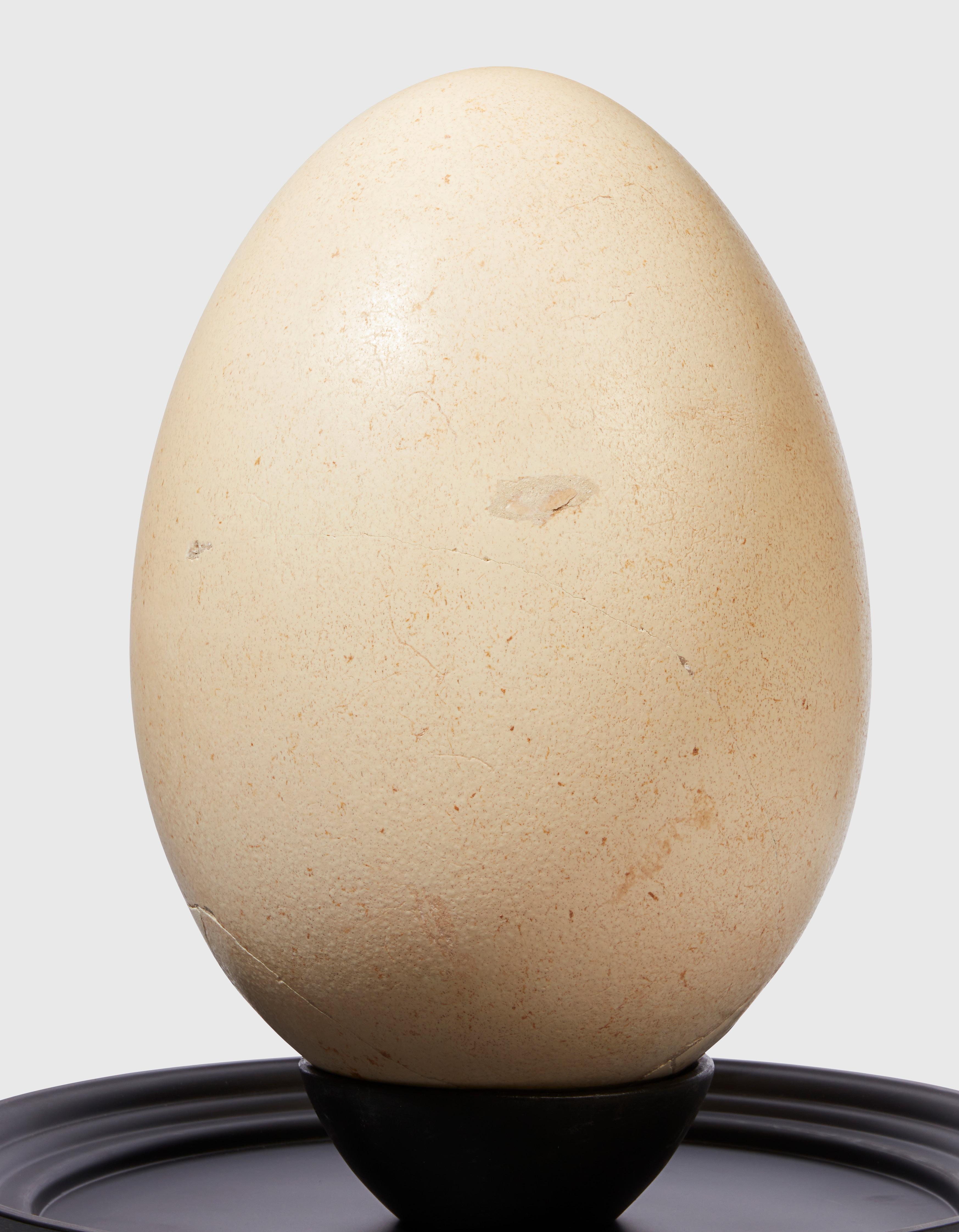
45
GURO ZAMBLE MASK
CÔTE D’IVOIRE
carved wood, the animal head with an open mouth showing teeth and tongue, pierced semi-circular eyes, all set under a high pair of horns, scarification on the forehead and various sculpted geometric patterns adorning the entire surface, black, white and dark red pigments, raised on a bespoke mount

37cm tall
Provenance: Zemanek-Munster, Wurzburg, 10th March 2018, lot 210 Andrew Berz, United States Private Collection, Australia, acquired from the above
Note: The Metropolitan Museum (2023) describes a similar Guro Zamble mask as follows: “In Guro culture, distinctions are made between masquerades that are the focus of cults and those that are more secular in nature. A sequence of three sacred masks centers around Zamble, a mythical male being whose form fuses antelope and leopard features. He is in turn complemented by his beautiful wife, Gu, and his wild, grotesque brother, Zuali. Such representations are owned by certain families that use them as the loci of sacrificial offerings proposed by diviners to improve their well-being. In contrast, other Guro mask forms, which serve only as sources of entertainment, are designed by individual performers.”
£800-1,200
62
PERSIAN TERRACOTTA BULL RHYTON


WESTERN ASIA, 1ST
MILLENNIUM B.C.
red terracotta, in the form of a naturalistically modelled bull, the horns curving upwards, the up to the sides, the back of the neck formed into a spout 23.5cm long
Provenance: Boisgirard & Associés, 26th February 2003, Paris, Lot 197 (accompanied by French Cultural Passport 060742). Private collection, United Kingdom, acquired from the above sale.
£4,000-6,000
Note: The bull had significant cultural and symbolic value in ancient Persian culture, where it was revered as a symbol of power, strength, and fertility. It appeared in various forms of Persian art, architecture, and literature, and was often associated with the worship of deities.
One of the most prominent examples of the bull’s significance in Persian culture was its association with the god Mithras, who was widely worshipped throughout the Persian Empire. Mithras was often depicted slaying a bull, a scene that represented the triumph of good over evil, and the renewal of life and the universe. This imagery was also incorporated into Persian mythology and folklore, where the bull was often portrayed as a fierce and powerful animal with divine attributes.
In addition to its association with Mithras, the bull was also seen as a symbol of the Persian Empire’s military might and wealth. Persian kings and nobles would often showcase their power and prestige by displaying herds of cattle and bulls, which were considered a sign of prosperity and abundance.
61
46 Other fees apply in addition to the hammer price: see the ‘Buyer’s Guide’ section on page 2
ZOOMORPHIC TERRACOTTA RHYTON
NEAR EAST, 1ST MILLENIUM B. C.
composed of basic geometric forms as a fantastical beast, the cylindrical body with a flat bottom and central opening on top and a spout on the chest, the tail bent up into a handle, with minimal incised linear decoration
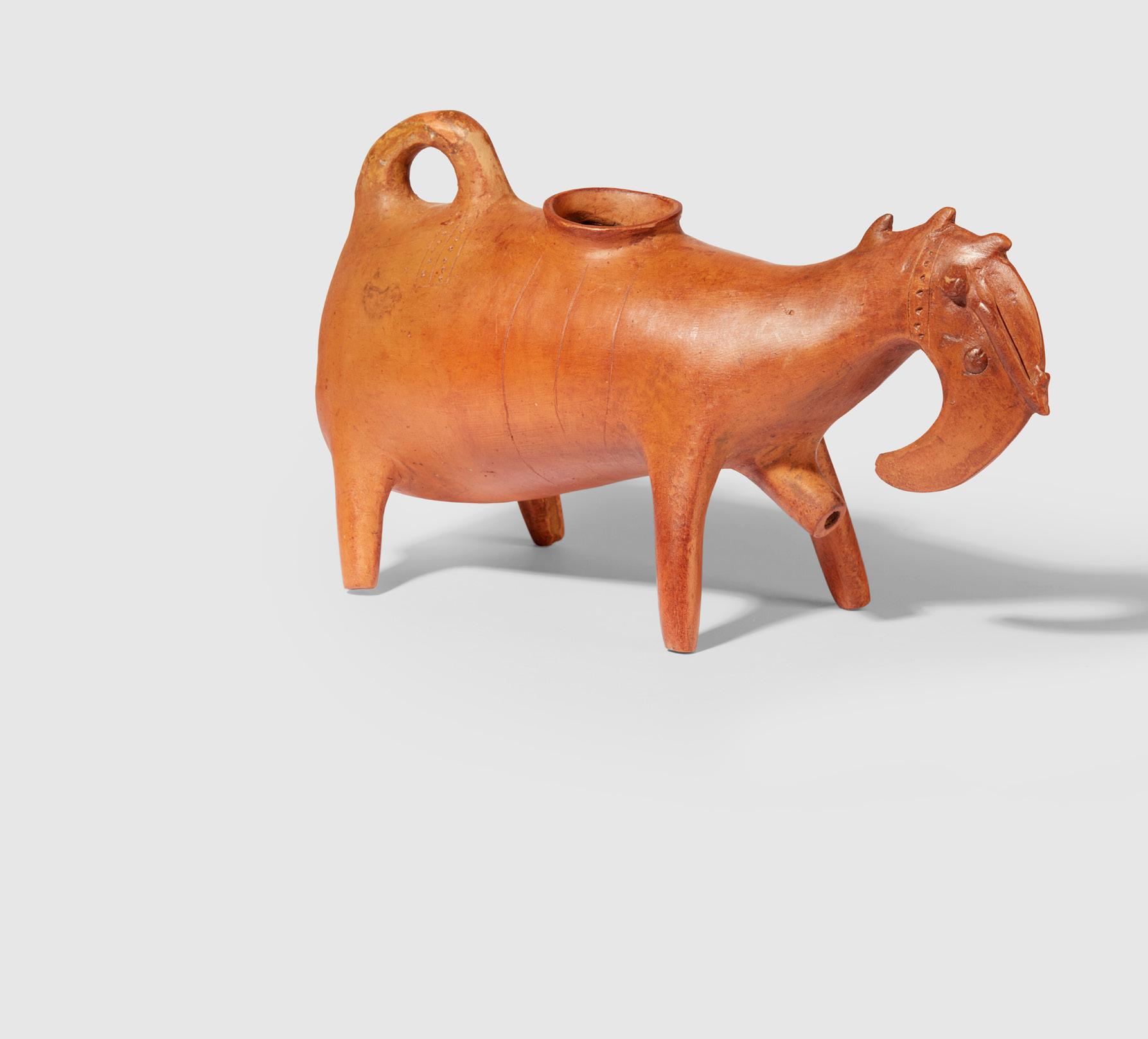
27cm long, 16cm high, 10cm wide
Provenance: Private collection formed between 1965-2022
£1,500-2,500
64 PAIR OF IBIBIO ARTICULATED FIGURES NIGERIA
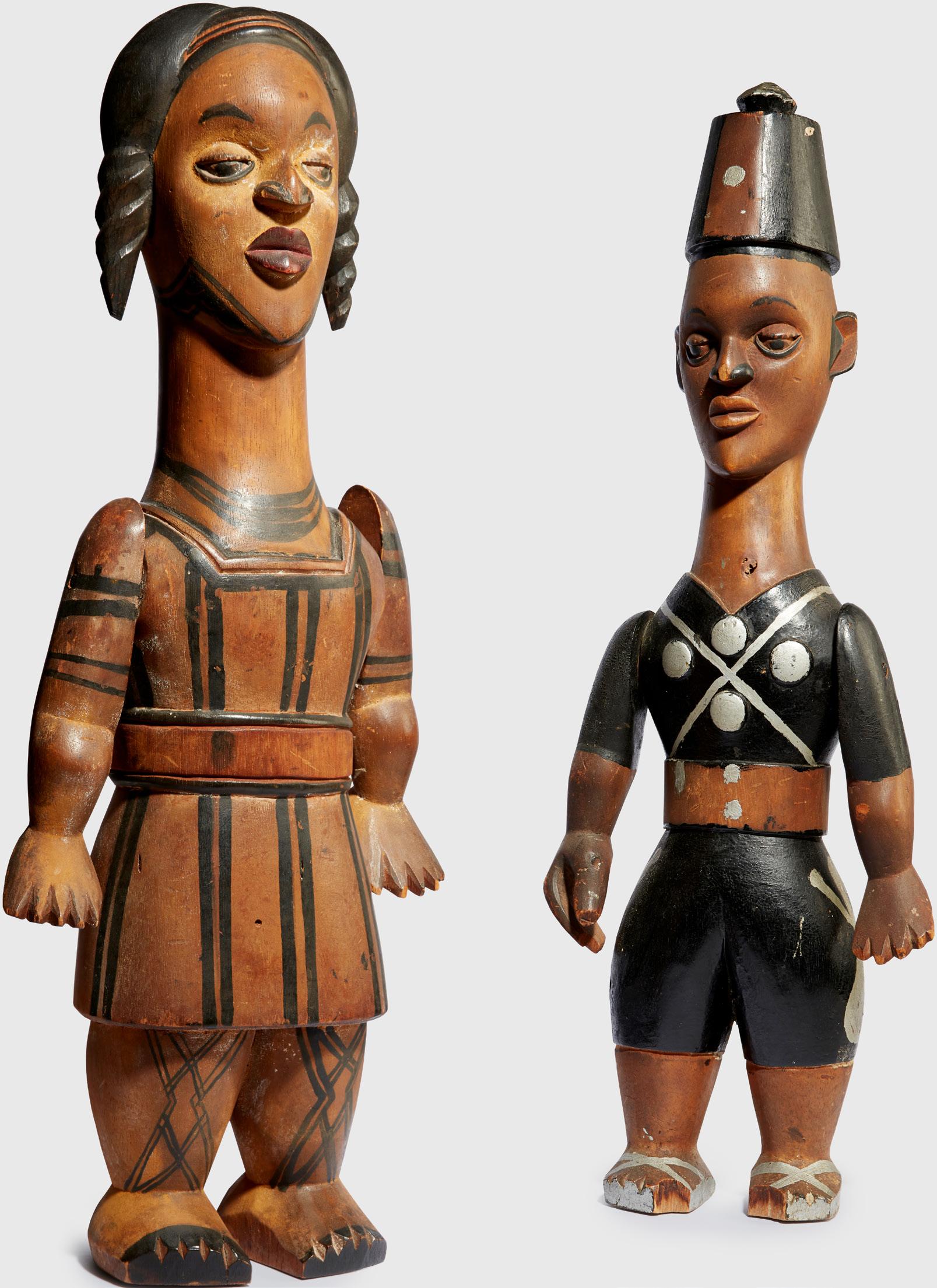

carved wood and pigment, the male figure in the form of a standing policeman with articulated arms and polychrome decoration, the female figure depicting a young lady with deeply-set large eyes, arched brows, prominent nose and an elegant long neck, with a four bunched braid coiffure and wearing a dress that falls below the knees (2) tallest 55.5cm
Female figure:
The Evill/Frost Collection III
Sotheby’s 16 June 2011
The Andrew McIntosh
Patrick collection
Male figure:
The Andrew McIntosh
Patrick collection
£800-1,200
63
47
ANCIENT ROMAN BRONZE HERCULES STATUE
WESTERN EUROPE, C. 1ST CENTURY A.D.
cast bronze, depicting a bearded Hercules with an ivy wreath on his head, holding the apples of the Hesperides and the skin of the Nemean lion, in contrapposto, mounted on a black slate base 28.8cm tall (excluding stand)

Naxus Arts 1984
£25,000-35,000

The present depiction of Hercules holding the golden apples of the Hesperides in his left hand and the skin of the Nemean lion draped over the same arm, while leaning on his club with the other arm, is a common representation of the hero in a relaxed contrapposto stance. Such depictions can be found in marble examples in the MFA Boston and the Museo del Prado Madrid. This pose is derived from a Greek original created by Myron of Eleutherae around 450 B.C., which was placed in the Heraion on Samos. Although none of Myron’s original bronzes survive, Pliny describes them as being more harmonious in their proportions and more realistic in their depictions than those of other famous Greek sculptors.
Bronze sculptures such as the present example offer valuable insights into the ancient world, as figured bronze objects were commonplace in Mediterranean cultures of that time. Such bronze statuettes were frequently reproduced from Greek originals and used as decorative pieces or conversation starters in the rooms of educated Romans. They could also serve as dedicatory offerings or cult statues.
In Pompeii, for example, many statuettes were found in niches in private houses and street shrines and were often associated with household or other divinities. Some marble and bronze figures were also linked to specific parts of the dwelling-house, particularly fountains. While some bronze statuettes were undoubtedly copies of famous originals, others were likely original creations, resulting in variations between statuettes of a similar type.
65
48 Other fees apply in addition to the hammer price: see the ‘Buyer’s Guide’ section on page 2
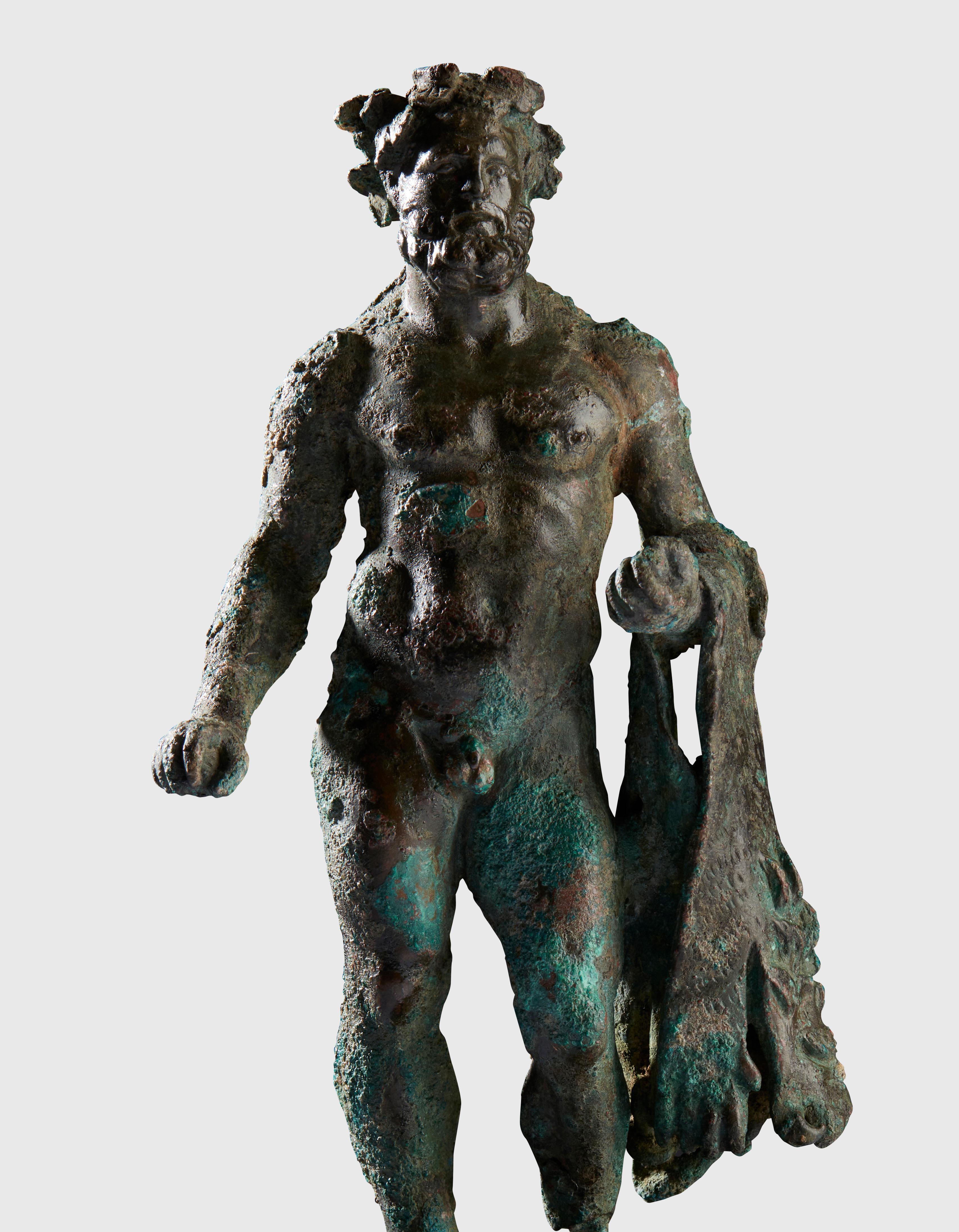
49
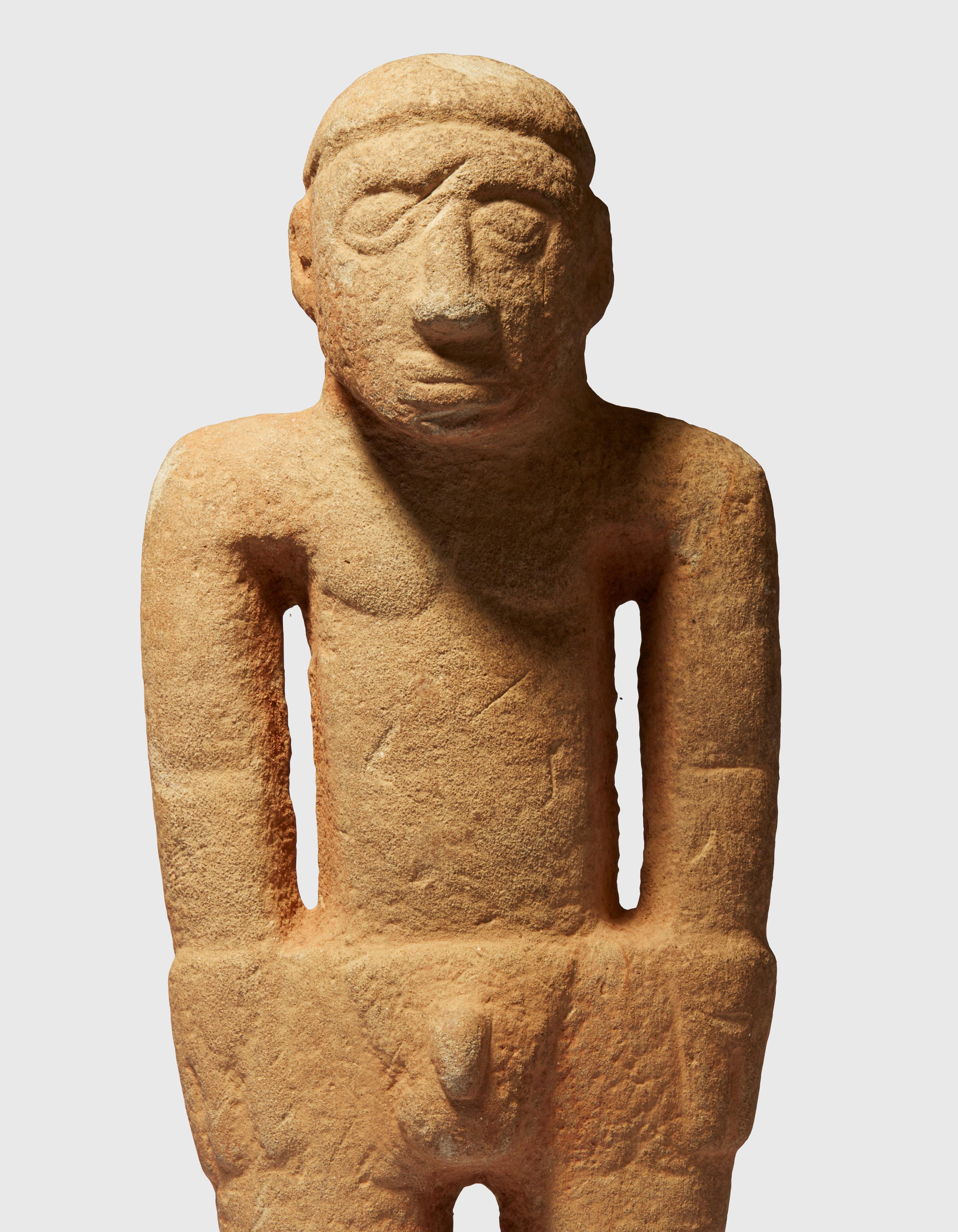
50
DIQUIS STANDING FIGURE
COSTA RICA, 600-900 A.D.
carved volcanic stone, the standing figure depicted nude, with arms held to the sides, muscular limbs and broad squared shoulders, the neck angled slightly forwards, the back with a central ridge denoting the spine, raised on a bespoke mount
36cm tall
Provenance: Dominique Rabier Collection, Brussels
£4,000-6,000
Note: The Diquis culture developed between 800 and 1500 A.D.in Southern Costa Rica; the word diquís meaning Great Waters or Great River in the Boruca language, and the delta of the great Diquís River is a major feature of that region’s geography. They may have arisen from local groups that were influenced by more southerly groups, particularly those that inhabited the territories of modern day Colombia. This impact would explain the intensified use of agriculture and the typically South American cultural elements especially prevalent in their artistic output, like their metalsmithing and ceramics. However, the Diquis have a very unique style in stone sculpture. They are famous for the big stone spheres they produced, still in situ in some instances, and the geometric and minimalistic way they depicted human and animalistic figures, of which this figure is a great example.
67
ZANDE FIGURE
DEMOCRATIC REPUBLIC OF CONGO
carved wood, the figure depicted standing, with coffee bean eyes, long ridged nose and etched coiffure, the arms reduced to small nubs, scarification to the legs and penis, raised on a bespoke mount
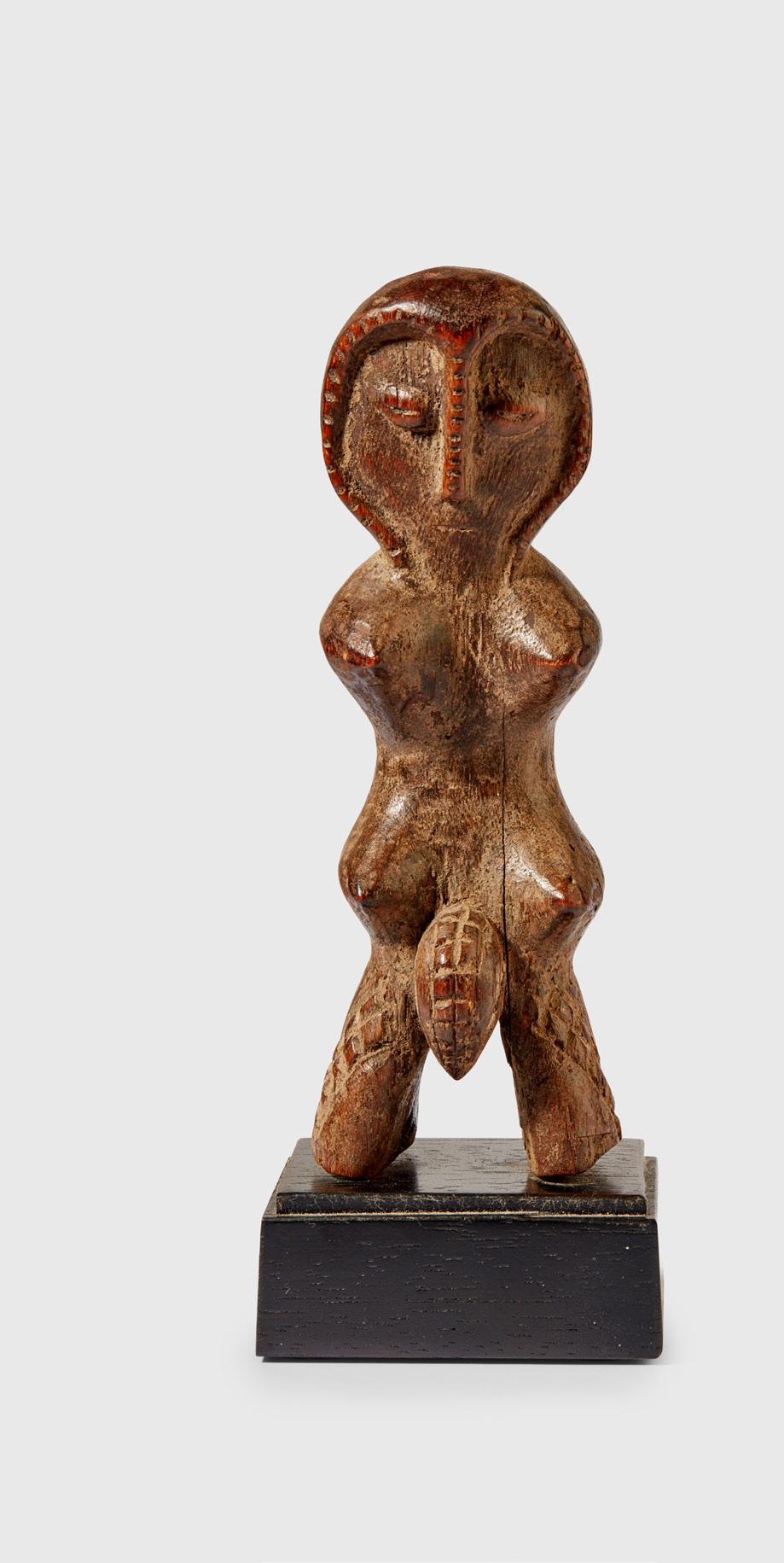
15.7cm high
Provenance: Sam Hill Collection, United States Mark Eglington, New York
Private collection, Australia, acquired from the above
£400-600
68
ANCIENT SOUTH ARABIAN TERRACOTTA FIGURE
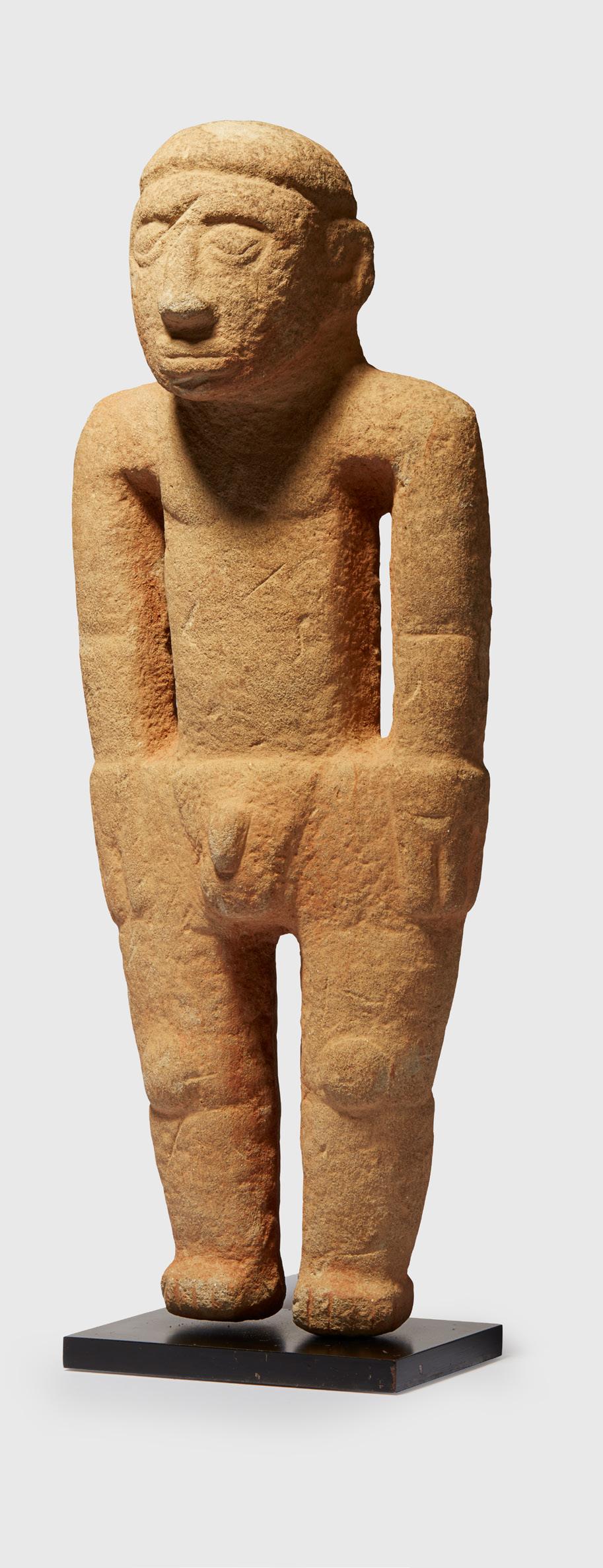
SOUTHERN ARABIA, 300 B.C. - 300 A.D. painted terracotta, shown seated, the broad legs outstretched, the arms reaching out in front of the body, with red and white pigment denoting facial details, a necklace and arm bangles
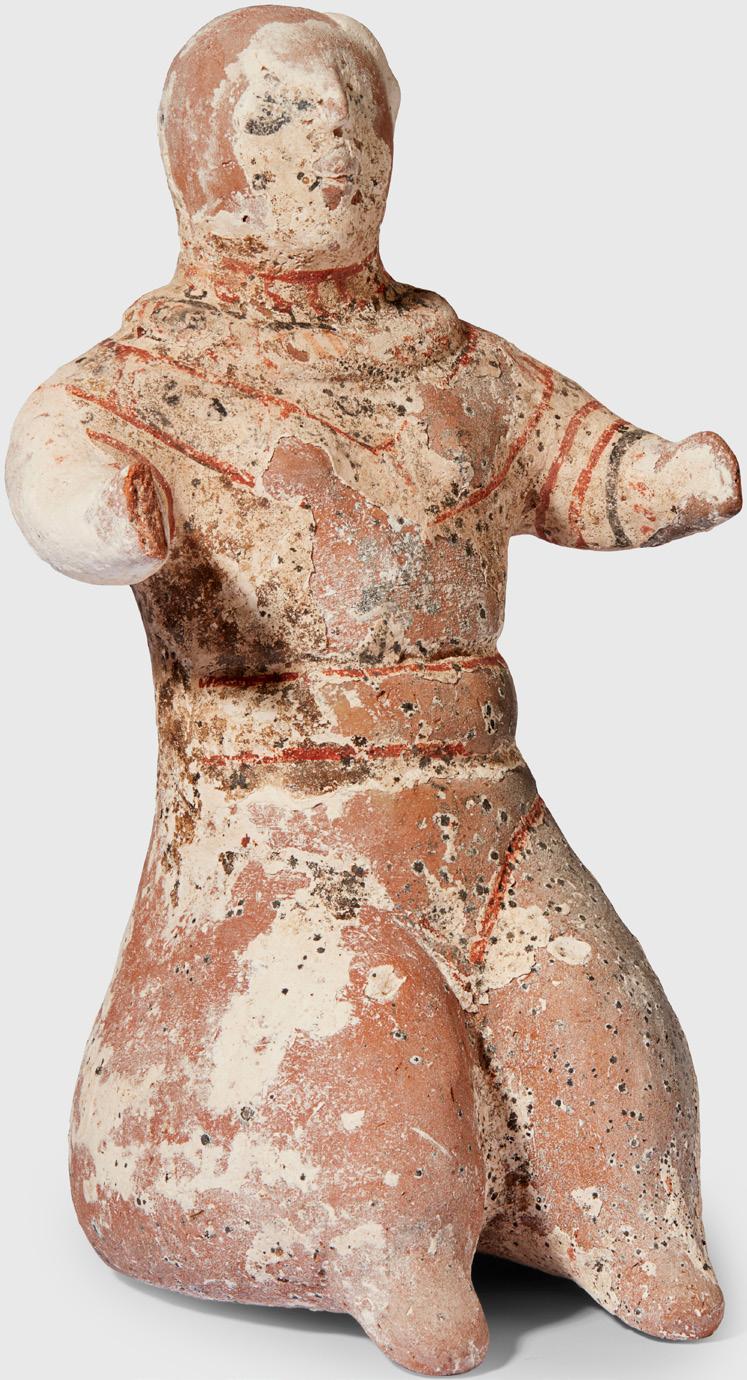

20.8cm high
£600-900
66
51 Other fees apply in addition to the hammer price: see the ‘Buyer’s Guide’ section on page 2
MAKONDE BODY MASK, NDIMU MOZAMBIQUE
carved wood, modelled in the form of a pregnant woman, incisions for attachment running along the edges, raised on a bespoke mount

47.9cm high
Provenance: Bryan Reeves, Tribal Gathering, London, United Kingdom
Private collection, London, acquired from the above, a copy of the original invoice will be provided to the buyer
Note: In Makonde initiation rituals, it was customary to use body masks such as the present example that depicted young women. These masks were an integral part of the “coming-out” ceremonies, which included male circumcision and education on gender norms, adult behaviour, sexual practices, and the responsibilities and rights of marriage. Festivities such as feasts, dances, and masquerades were also part of the celebration. A male masked dancer would wear the female body mask to represent a young woman during these ceremonies.
£1,500-2,500 70
COLLECTION OF LEGA MASQUETTES DEMOCRATIC REPUBLIC OF CONGO
carved wood, each with perforated eyes and mouth slit, the central faces coloured white with kaolin, raised on a bespoke mount (5) largest 14cm tall (excluding stand)

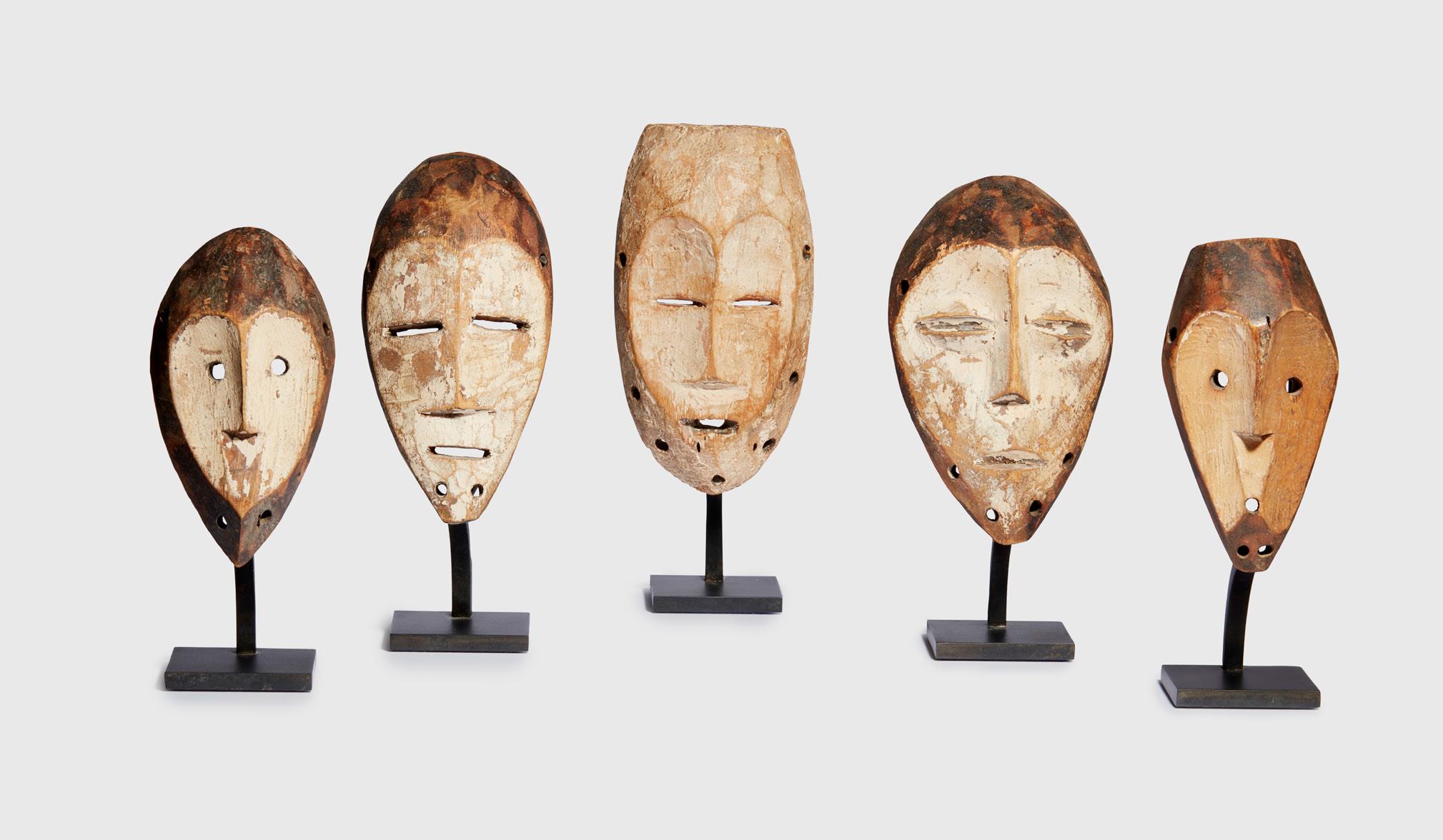
Provenance: Private collection, Minnesota, USA Private collection, London, United Kingdom
£1,500-2,500
69
52 Other fees apply in addition to the hammer price: see the ‘Buyer’s Guide’ section on page 2
ANCIENT EGYPTIAN WOODEN HANDS FROM AN ANTHROPOID SARCOPHAGUS

EGYPT, LATE PERIOD, 664 - 332 B.C.
carved and with traces of gesso and paint, raised on a bespoke mount 20cm high (excl. stand)
Provenance: Private collection, France
Royal Athena Galleries, number “PPG120”, sold for $2,500 to the below November 18th 2004 (with accompanying original invoice) Private collection, United Kingdom
£1,000-1,500
72
DAN MASK
COTE D’IVOIRE
carved wood, oval face with prominent domed forehead, wide circular eyes, triangular pointed nose and pursed lips, raised on a bespoke mount 25cm tall

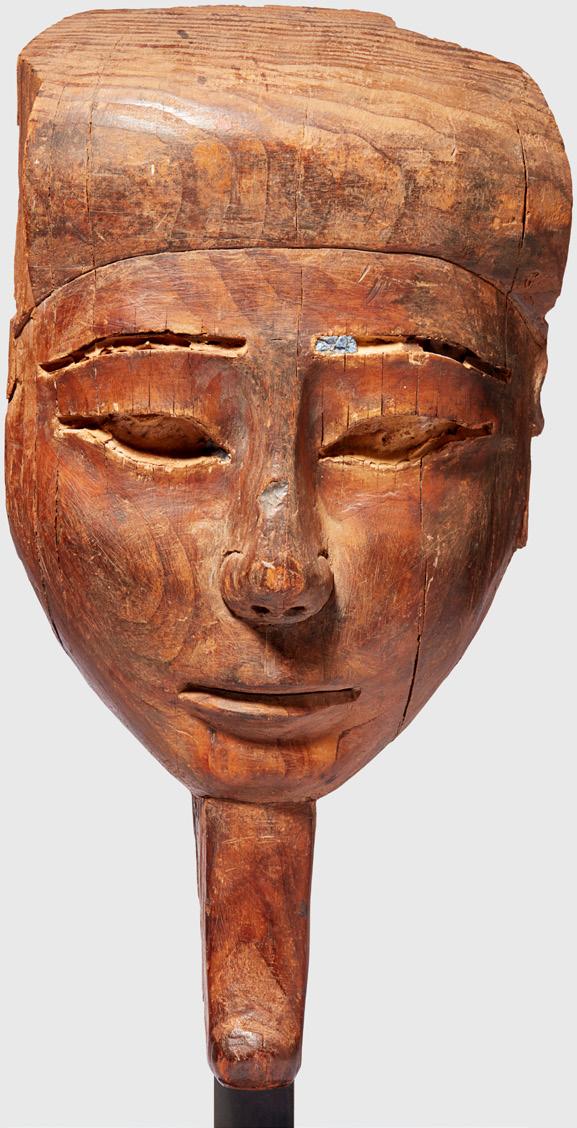

Provenance: Mme Murielle Nicolas, Villeurbanne, France Paul Crépet, France
Frameless Gallery, London, United Kingdom
£2,000-4,000
73
EGYPTIAN WOODEN MUMMY MASK
EGYPT, LATE PERIOD OR LATER
carved cedar wood, displaying a serene countenance, with large rounded eyes reccessed for original inlay beneath arched brows, broad nose, full lips displaying a subtle smile and beard wig, raised on a bespoke mount
31.5cm tall (unmounted)
Provenance: With Sayed Molattam (fl.1917-1977), Egyptian Museum Cairo Licence No.58, Luxor, Egypt, from at least the early 1970s.
Private Collection, France, acquired from the above in the early 1970s (accompanied by old signed undated document from the early 1970s and French cultural passport 228758).
Sold at: De Baecque, Drouot, Paris, 19th March 2021, Lot 106.
£600-900
71
53
SOLOMON ISLANDS CANOE PROW, NGUZU NGUZU
NEW GEORGIA ISLAND
carved wood, red and white polychrome and mother-of-pearl, the figure is depicted clasping a bird in both hands beneath the chin, the face and arms are symmetrically adorned with lines of nautilus mother-of-pearl inlay simulating war paint, the largely distended ears and the eyes bear the same, the nose is elongated, the half-open mouth revealing the teeth, raised on a bespoke wooden mount, the reverse of the mount bearing an ink collection number reading “RH990”

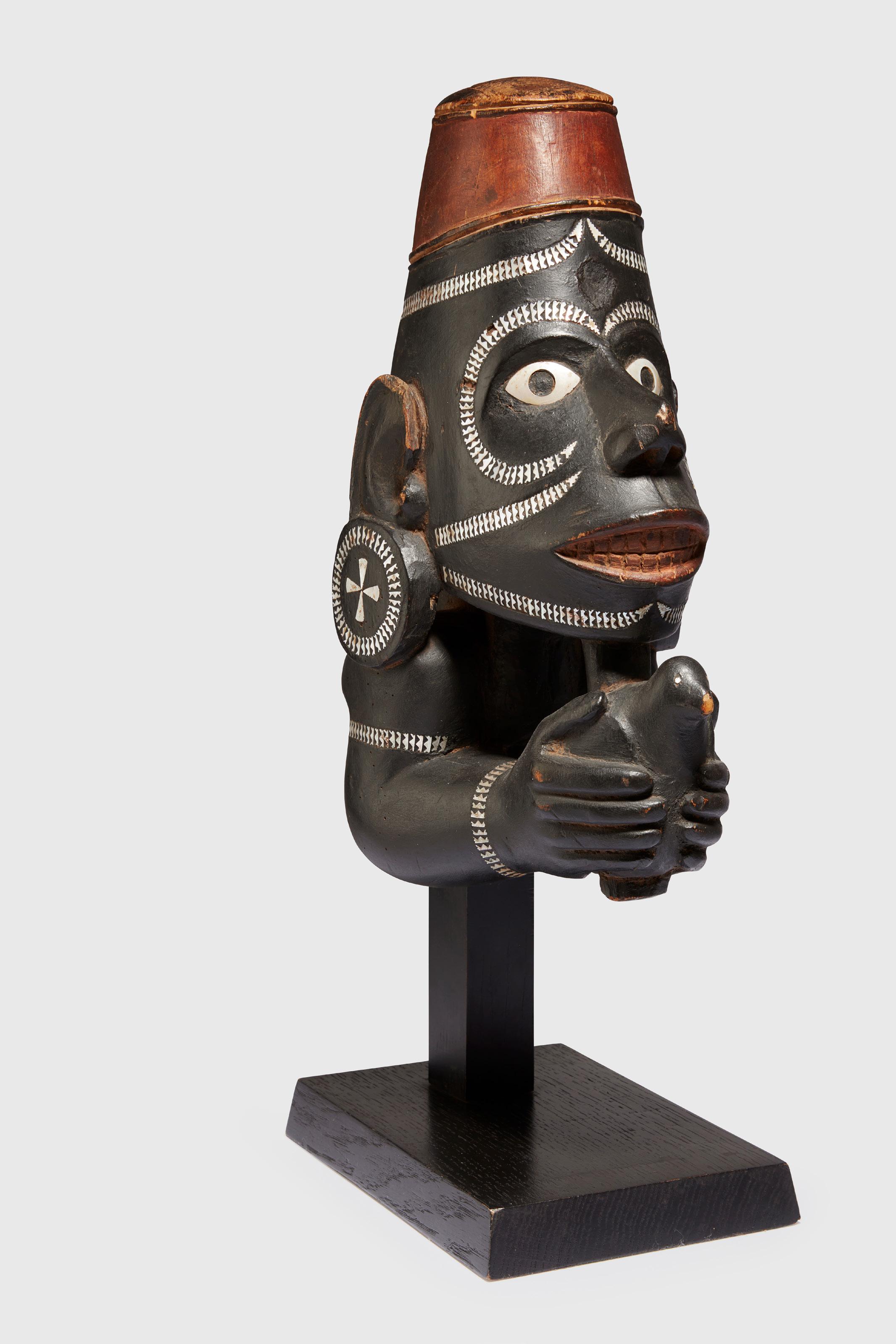
32cm high excl. stand
Provenance: William Jamieson, Canada, acquired Paris 1960
Philippe Ratton, Paris
Private collection, London, United Kingdom, acquired from the above in 2003 (accompanied by a scan of the original invoice)
Note: The people of the Solomon Islands hold great respect for the long, plank-built war canoes, which are known for their impressive size, speed, and beauty. These canoes are stained black and adorned with white nautilus shell inlays. The outer length of the raised prow is decorated with large cowrie shells, and at the bow, there are carved anthropomorphic figureheads such as the present example, that are secured just above the waterline. The construction and decoration of these canoes are accompanied by appropriate rituals, and they are still crafted today.
£5,000-8,000
74
54 Other fees apply in addition to the hammer price: see the ‘Buyer’s Guide’ section on page 2

75
ANCIENT CELTIBERIAN GLADIUS SWORD WITH TRISKELE IBERIA, LATE 2ND - 1ST CENTURY B.C.

piled iron, elegant fish-shaped blade with a square shoulder and flat-section tang, incised triskele motif to the handle end of the blade on one face, with each arm terminating in a birds head 63cm long

Provenance: Private collection, London, United Kingdom, acquired 1900s, accompanied by a report of metallurgic analytical results, written by Dr. Brian Gilmour of the Research Laboratory for Archaeology and the History of Art, University of Oxford.
£5,000-8,000


56 Other fees apply in addition to the hammer price: see the ‘Buyer’s Guide’ section on page 2
LURISTAN BRONZE SWORD
NEAR EAST, 1ST MILLENIUM B.C. cast bronze, the cotton reel pommel with a flaring base over the tapering rectangular guard with circular and linear stamped decoration, ending in a long blade with dual ridges
51cm long, 4cm wide
Provenance: Previously in a private collection, acquired between 1965 – 2020 £1,000-1,500
LURISTAN BRONZE SWORD
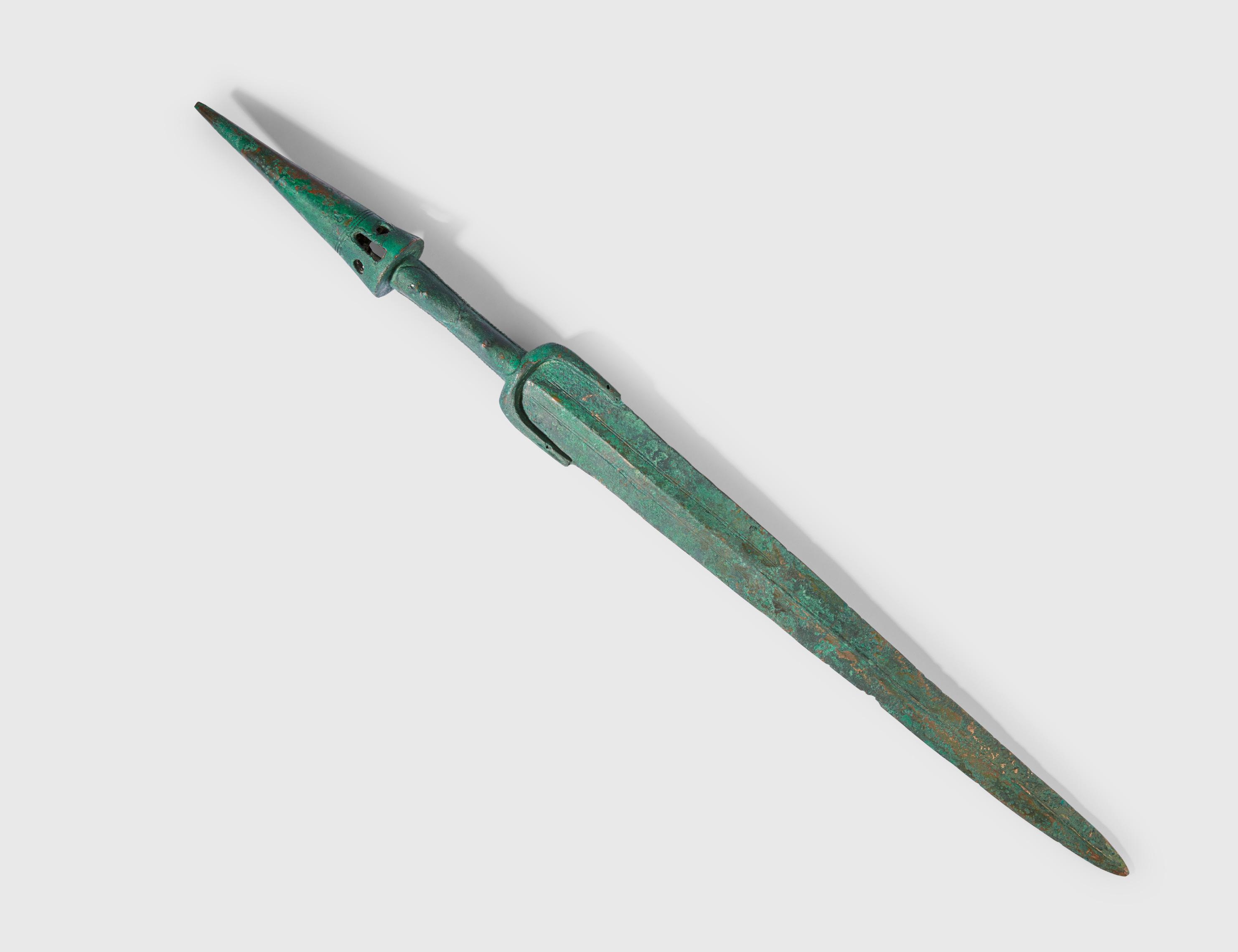
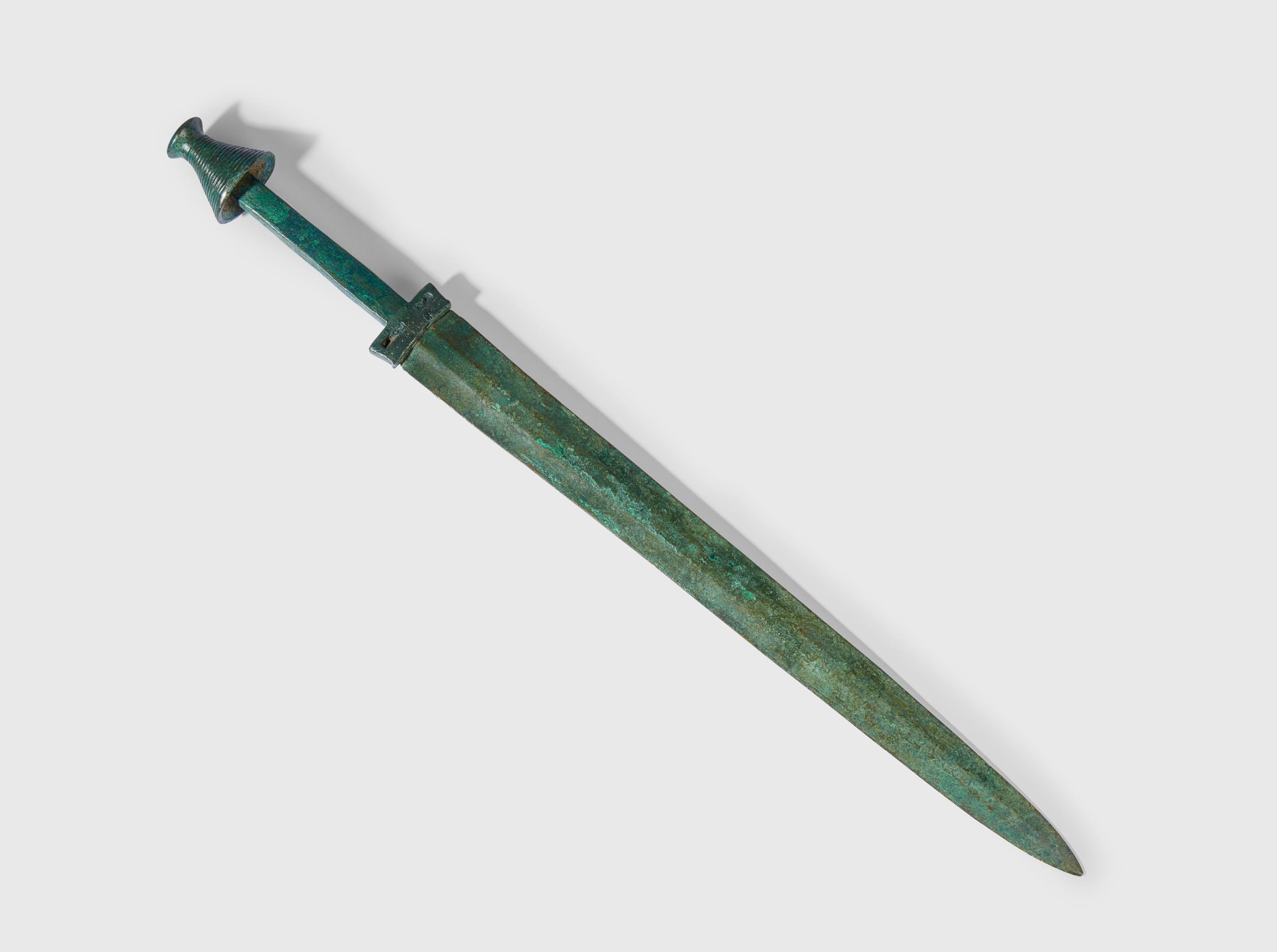
NEAR EAST, 1ST MILLENIUM B. C. cast bronze, the unusual spike pommel hollow at the base with alternating circular and rectangular cut-outs, the grip with two spikes on each side, ending in a rounded rectangular guard over a slender blade with pronounced central ridge and linear engraving to both sides of it
66.5cm long, 5.5cm wide
Provenance: Previously in a private collection, formed between 1965 – 2020 £2,000-3,000
76
77
57
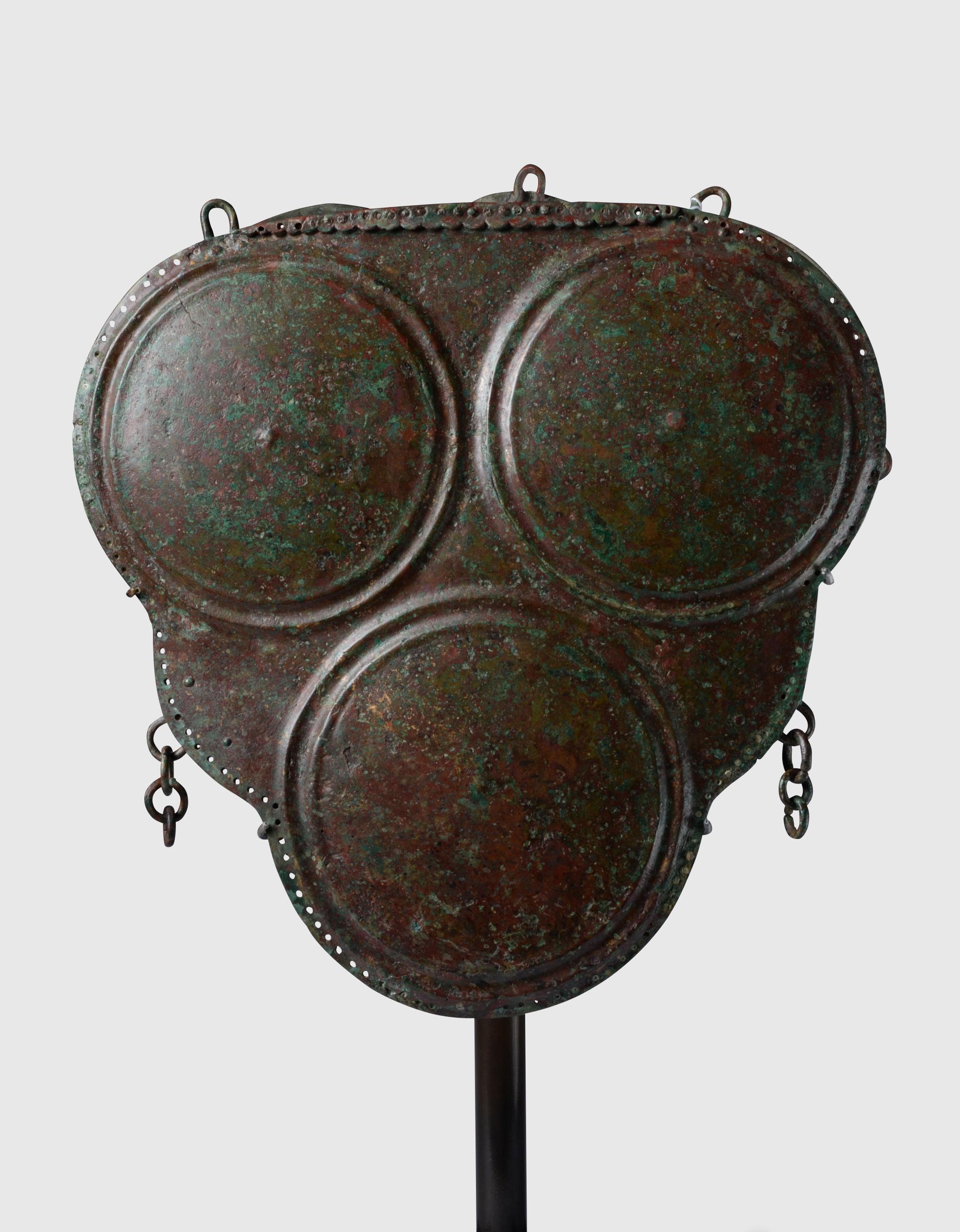
58
78
SAMNITE BRONZE CUIRASS
SOUTH-CENTRAL ITALY, 4TH - 3RD CENTURY B.C. hammered bronze, set composed of a front and back plate, both with three discs set in a bronze sheet forming a triangular shape, with links and perforations to the perimeter for attachment (2)

27.5cm tall
Provenance: Axel Guttman (1944-2001), Berlin
Hermann Historica, Munich
Art Ancient, London, 2019 acquired by the present owner from the above
For a similar example please see:
The J. Paul Getty Museum, Los Angeles, California, accession no. 96.AC.232.

£8,000-12,000
79
ANCIENT ITALIC SHIELD BOSS
NORTH-CENTRAL ITALY, C. 650 B.C. sheet bronze, circular in shape, with punched and incised ornament, with an outer border of applied bronze discs, within which sits a depiction of a mythical beast with clawed paws and a bulls head, raised on a bespoke mount

25.4cm diameter
Collection of Jacques and Henriette Schumann, formed between 1950 and 1970. The Schumanns inherited part of their collection from Henriette’s parents, Alice and Fernand Halphen, andjacques’ maternal grandfather, Albert Lehmann. Christie’s, Paris, Collection of Jacques and Henriette Schumann, 20th September 2003, lot 85
Note: Convex bronze discs, often with punched or incised ornament, were frequently attached to wooden, leather, or bronze shields. Many of the shields found in seventh century B.C. Italic and Etruscan chamber tombs were made for ceremonial or funerary purposes; they were too fragile to have had any practical use in combat.
£4,000-6,000
59 Other fees apply in addition to the hammer price: see the ‘Buyer’s Guide’ section on page 2
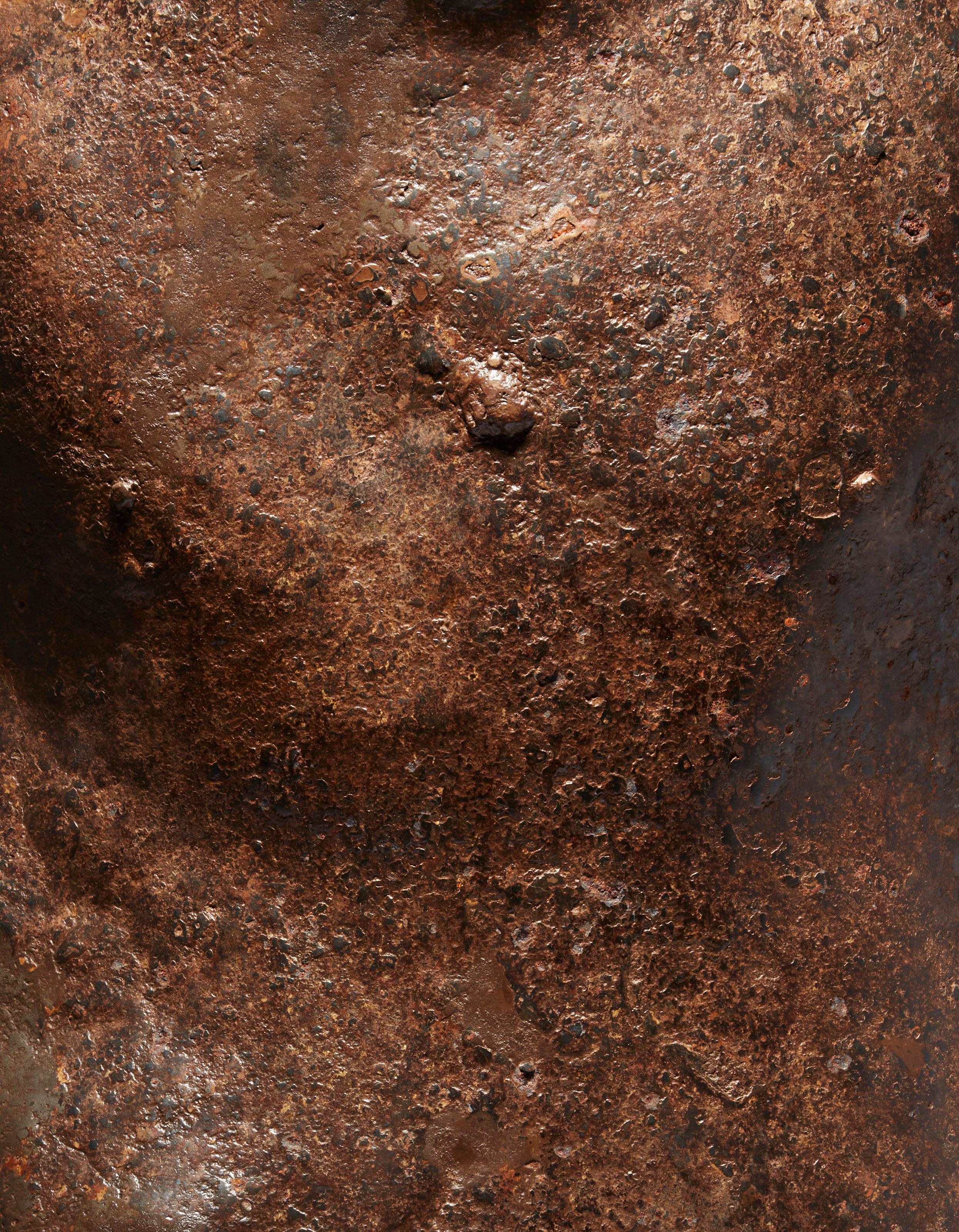
Of exceptional rarity, this iron cuirass is a rare survivor from the ancient world, where the recovery of bronze weaponry and armour is far more common. It would have been expensive to produce, requiring skilled blacksmiths to forge and shape the iron plates. As a result, this cuirass would likely have been worn by a wealthy citizen who could afford to purchase their own armour. Despite its weight and expense, it was highly effective in protecting its wearer. It provided excellent defence against most types of weapons and it was especially effective against thrusting attacks from spears and other polearms.
80
ANCIENT GREEK IRON BREASTPLATE
GREECE, 5TH - 4TH CENTURY B.C.
iron, the front plate muscled cuirass naturalistically modelled with defined nipples, each shoulder with remains of fastenings decorated with wreaths of ivy, raised on a bespoke mount 49cm high (unmounted)

Provenance: Previously in the Private Collection of John Moore (Brigantia Antiquities), York, UK, acquired in the 1990s or before.
UK art market
With ArtAncient, London, acquired from the above in 2017
Private Collection, London, acquired from the above 22nd September 2017.
ALR: S00221912, with IADAA certificate, this item has been checked against the Interpol database. £30,000-50,000
61 Other fees apply in addition to the hammer price: see the ‘Buyer’s Guide’ section on page 2
COLLECTION OF LURISTAN PERSIAN SPEAR HEADS
NEAR EAST, C. 1000 - 750 B.C.
cast bronze, each with leaf-shaped blade and raised central mid-rib, rounded shaft and squared shank below, each raised on a bespoke mount and displaying a beautiful range of deep green and azure blue patination (7)

largest 48cm long
Provenance: Private collection, United Kingdom, acquired on the UK art market 1980s
Private collection, London, United Kingdom 2017 from the above
Note: It is generally believed that the Luristan region was a significant centre for metalworking during the Iron Age in the ancient Near East; producing weapons, ornaments, and other objects of bronze and iron. A large number of these artefacts, especially weaponry, have been found in other neighbouring territories, suggesting that they may have been traded or commissioned, including to the Persian Empire.
£10,000-15,000
81
62 Other fees apply in addition to the hammer price: see the ‘Buyer’s Guide’ section on page 2
ROMAN BRONZE PATERA
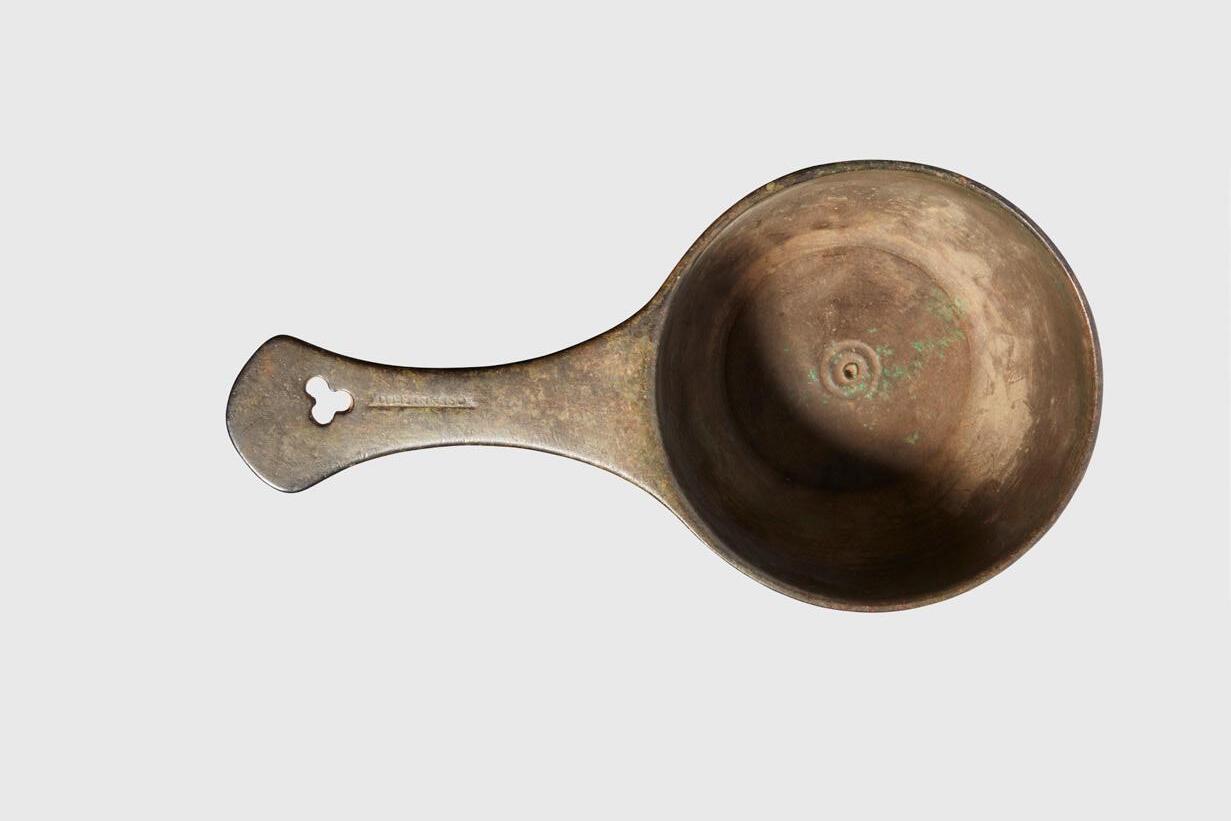
WESTERN EUROPE, 1ST - 3RD CENTURY A.D.
cast bronze, the single long handle with punched makers mark reading “C.SENNI.BELLI”, the steep sides of the deep bowl leading to a rounded rim, standing upon a round foot with multiple rings of concentric circles cast on the underside
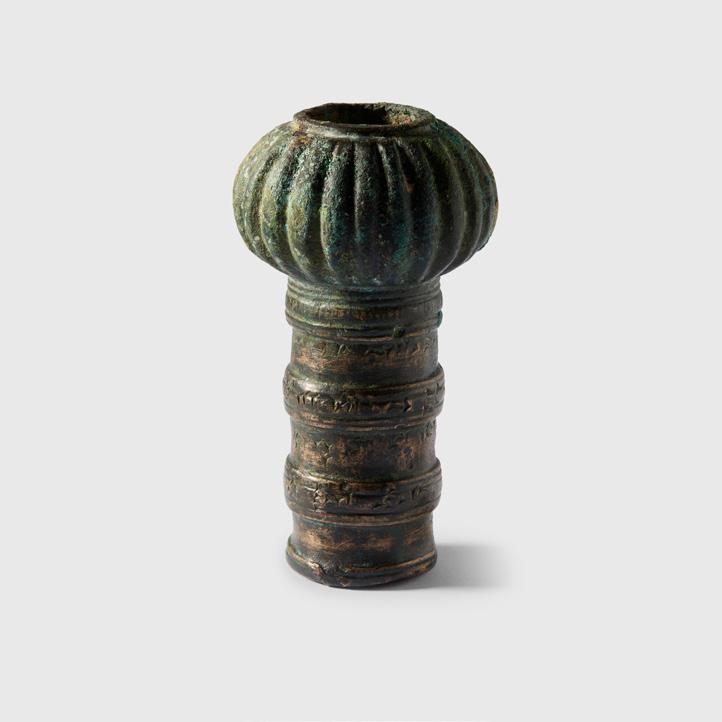
20cm long
Provenance: Gary Edwards Collection, United Kingdom

Richard Cotterill Collection, Wollaton, acquired from the above 1995 Private collection, Nottinghamshire, acquired Mellors & Kirk Auctioneers, 2011
£600-900
83
NEAR EASTERN BRONZE MACEHEAD WITH CUNEIFORM INSCRIPTION
NEAR EAST, LATE 1ST MILLENNIUM B.C. cast bronze, bulbous-shaped head with a decorative, ridged design, the shaft with four ringed collars, the central two with cuneiform inscription, dark patination
8.4cm long
£1,000-1,500
82
63
MAORI HAND CLUB, WAHAIKA NEW ZEALAND, 19TH CENTURY
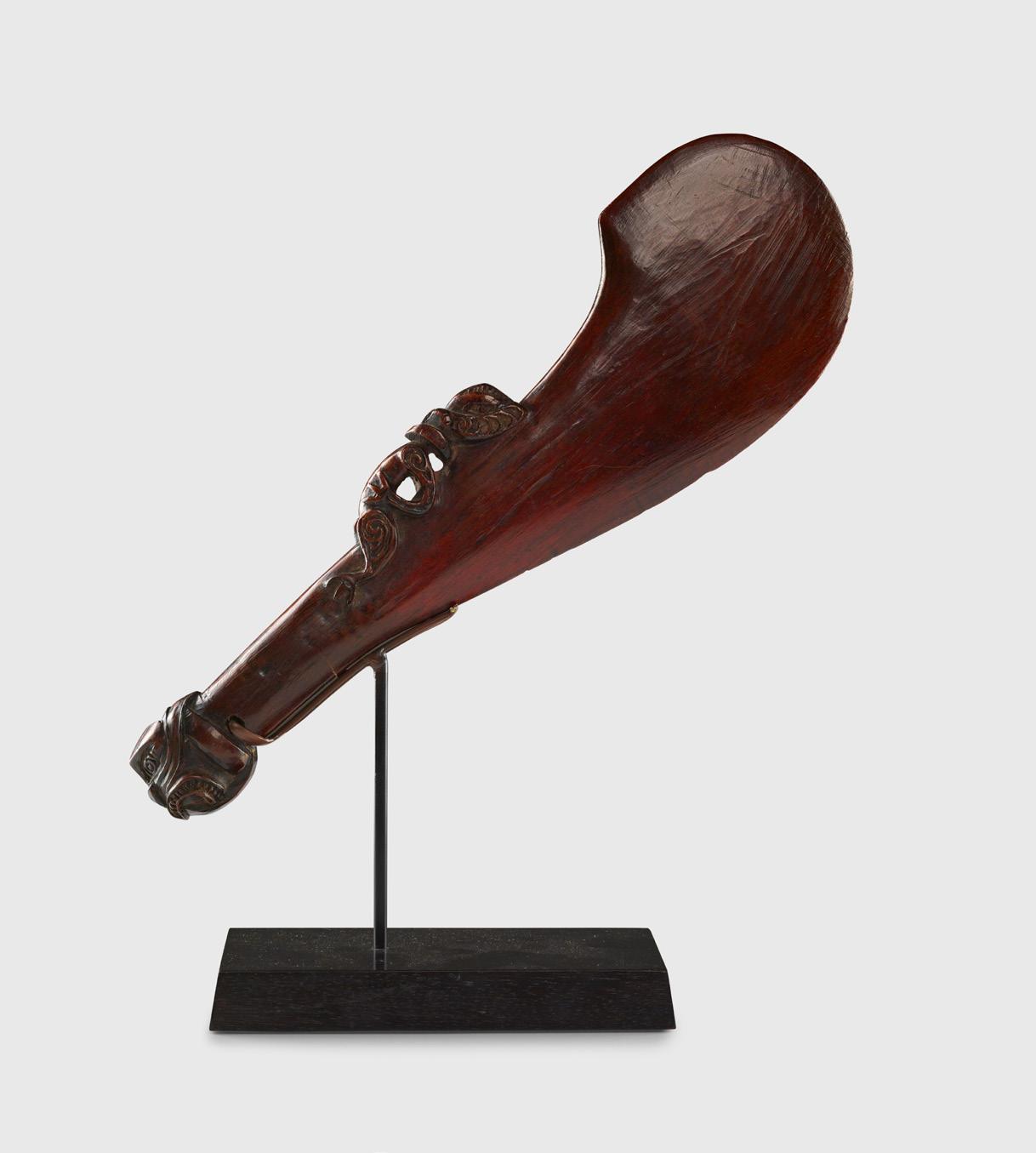

carved wood, the grip terminating in a tiki face, the flat, elegantly curved blade with a central reclining openwork tiki figure 30.5cm long
Provenance: Bonhams, New York, 14th November 2013, lot 75, sold for $10,000 Wayne Heathcote, London Private collection, Chicago £4,000-6,000

84
64
85
CEREMONIAL OR WAR CLUB
MALAITA, SOLOMON ISLES, MELANESIA, 19TH CENTURY
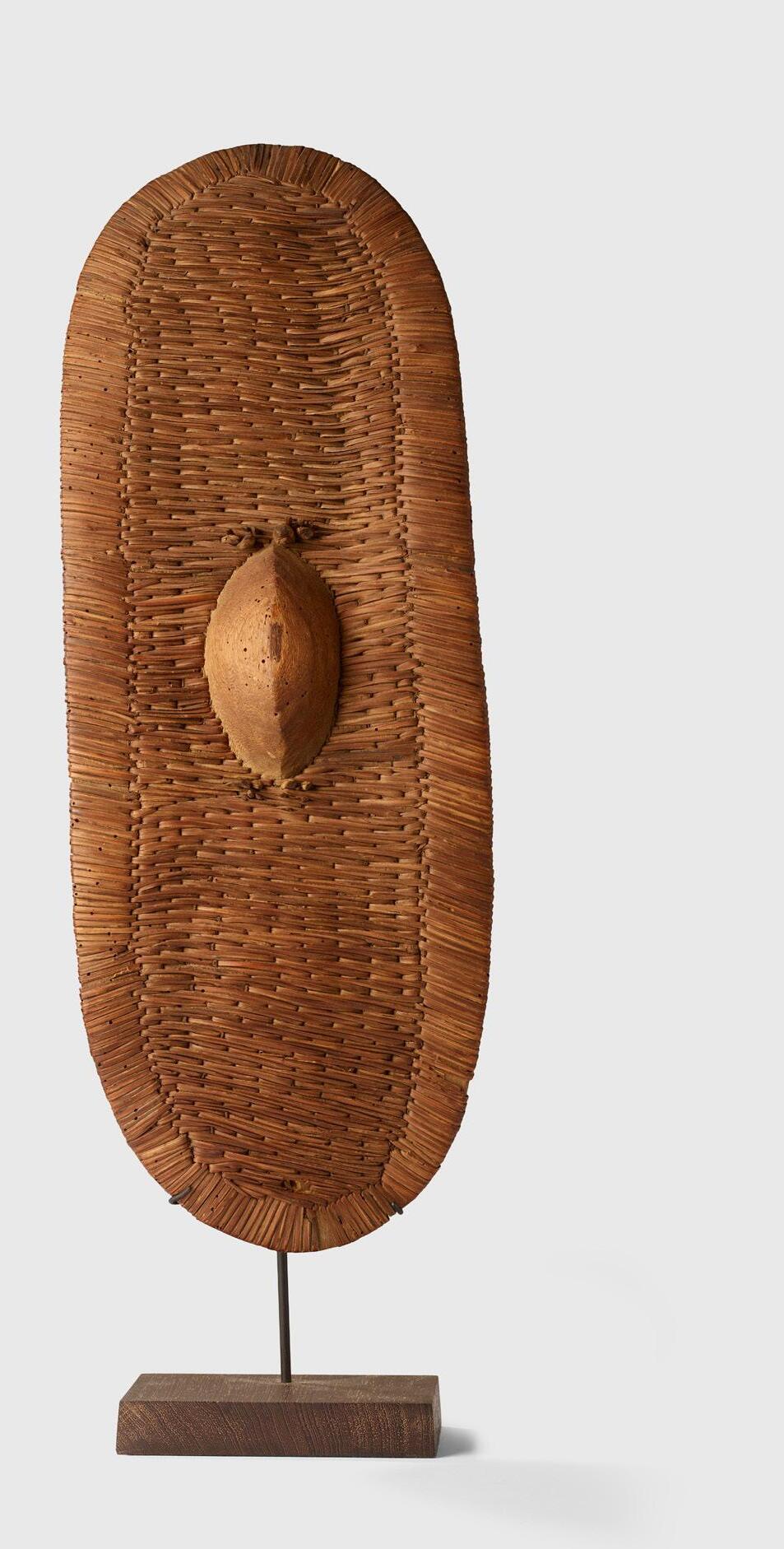
carved & incised wood
69cm high, 15cm wide

£600-800
86
VUNIKAU ANTIQUE ROOTSTOCK CLUB
FIJI, POLYNESIA, EALRY 19TH CENTURY
carved and incised wood
109cm high
£800-1,200
87
DANCE OR WAR SHIELD
GANDA, UGANDA, EAST AFRICA
woven cane fibre & wood boss
56cm high, 20cm wide

Provenance: Private collection, United Kingdom
£400-600
65 Other fees apply in addition to the hammer price: see the ‘Buyer’s Guide’ section on page 2
NAZCA TEXTILE
PERU, C. 400 - 550 A.D. dyed camelid wool, flatweave with upper and lower borders of chequered pattern and a central field of swirling lines (1)
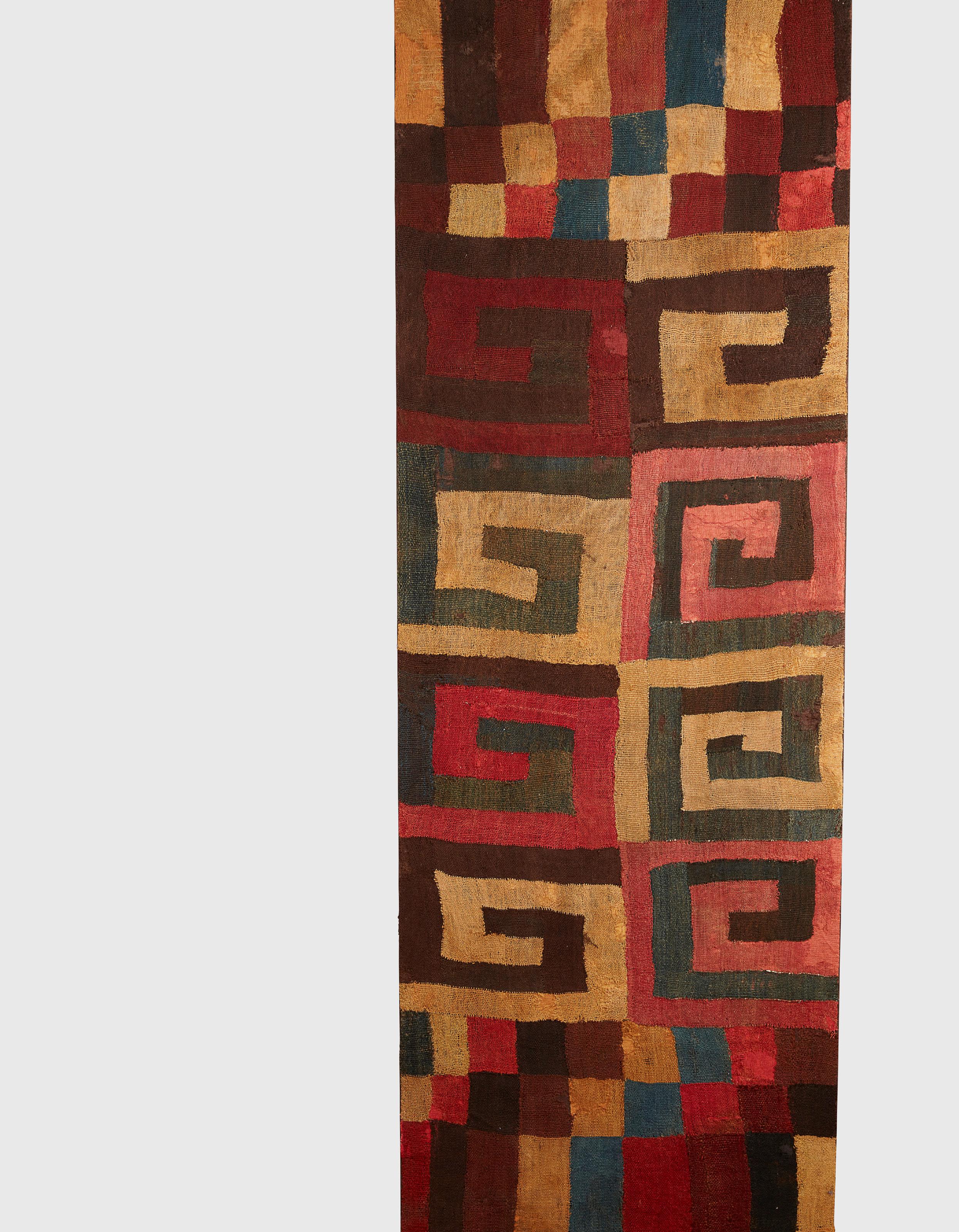
158 x 56cm
Provenance: Gordon Watson Collection, London Sothebys, London, 3rd May 2006, lot 153
£4,000-6,000

88
66
89
ANCIENT CHINESE COCOON JAR
CHINA, HAN DYNASTY, 206 B.C. - 220 A.D. grey earthenware with polychrome decoration, the cocoon-shaped vessel standing on a discoid foot, the body painted with depictions of heavenly swirling clouds 22.3cm high
Provenance: Private collection, United Kingdom £1,000-1,500
BERGAMO MOUNTAINS, ITALY, EARLY 20TH CENTURY carved wood, 74cm high, 23cm wide, 9.5cm deep


From the private collection of Italian artist, Enrico Prometti (1945-2008) £500-700

SCULPTURE
90 SPOON
67 Other fees apply in addition to the hammer price: see the ‘Buyer’s Guide’ section on page 2
MENDE STAFF SIERRA LEONE
carved wood, the shaft carved with a series of raised ribs, terminating in a handle in the form of a young lady with ringed neck and elaborate coiffure, raised on a bespoke mount


86.3cm tall
Provenance: Craig De Lora, New York
Ray Handley, San Francisco (1923 - 2009)
Andrew J. Berz, Sausalito CA / Mexico City
31 juil. 2016, Curator’s Eye - Important African Art Auction
£2,000-3,000
91
68
PAIR OF KAPKAP PENDANTS SOLOMON ISLANDS

tridacna clam and turtle shell, each disc-shaped ornament overlain with an intricately carved filigree of shell with an abstract representation of a frigate bird hunting fish (2) largest 12.2cm diameter
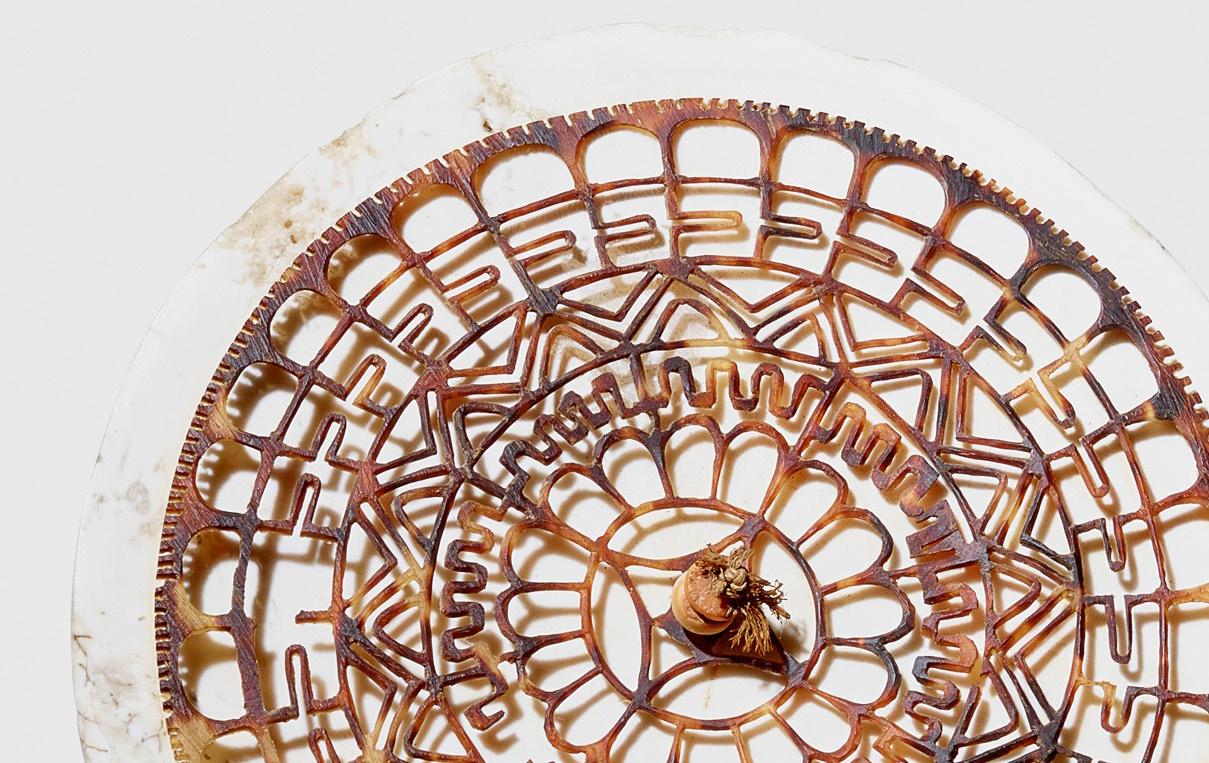

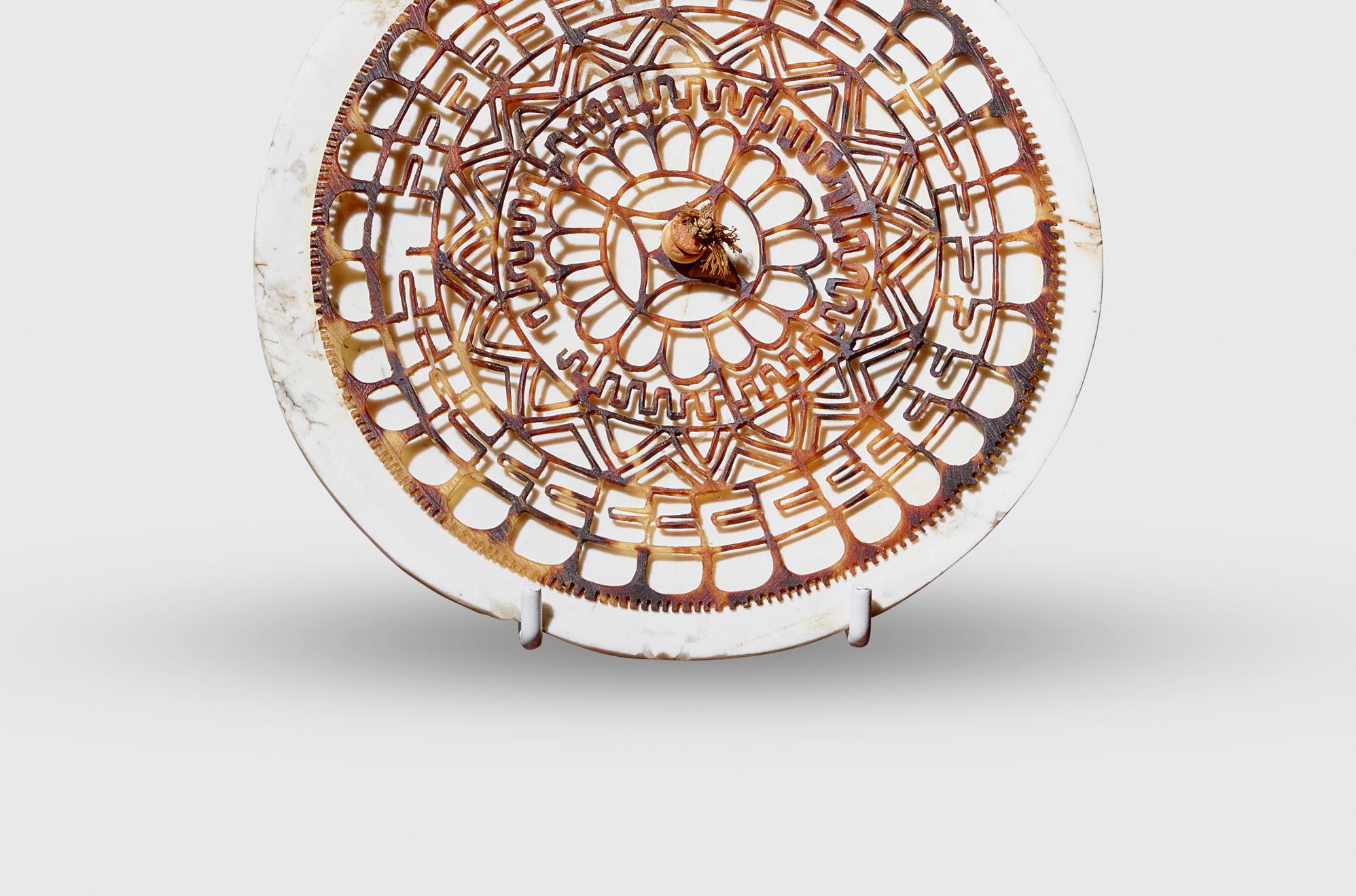
Provenance:
Acquired by Mr Rees in the early 20th century (prior to WWI) whilst undertaking missionary work in the South Pacific, thence by descent and inherited by the present owner in 1960. A letter with further details to accompany the items.
£2,000-3,000
93
BREASTPLATE
ORNAMENT, KAPKAP
NGGELA SULE, SOLOMON ISLANDS
tridacna clam and turtle shell with coconut fibers, the disc-shaped ornament overlain with an intricately carved filigree of shell featuring a series of six allround pattern bands, each with a differing wave motif, with a vegetal string linking the two parts terminating on the reverse with a series of disc shaped shell beads (1)
14.2cm diameter
Provenance: Private collection, United Kingdom, acquired on the French art market in 2007 Private collection, France, reputedly acquired in the Florida Islands, Nggela Sule, in the early 20th century
£1,000-1,500
92
69 Other fees apply in addition to the hammer price: see the ‘Buyer’s Guide’ section on page 2

70 Other fees apply in addition to the hammer price: see the ‘Buyer’s Guide’ section on page 2
ROMANO-EGYPTIAN TERRACOTTA HEAD
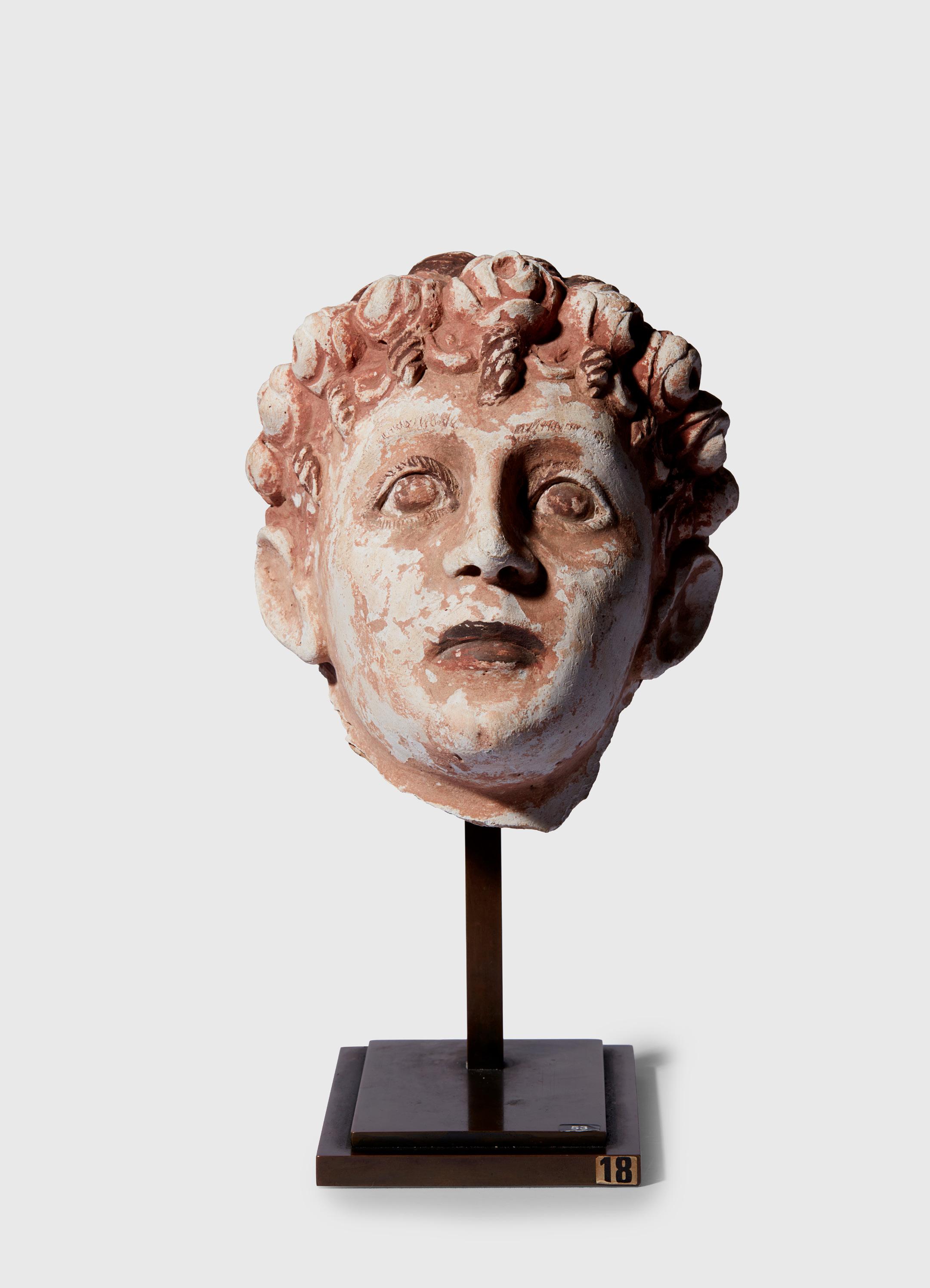
EGPYT, C. 1ST CENTURY B.C.
realistically modelled with expressive almond-shaped eyes, corkscrew locks on the forehead, a flower headband and a hair knot in the back, painted in shades of ochre and brown 20cm high, 15cm wide, 19cm deep £3,000-4,000
94
71 Other fees apply in addition to the hammer price: see the ‘Buyer’s Guide’ section on page 2
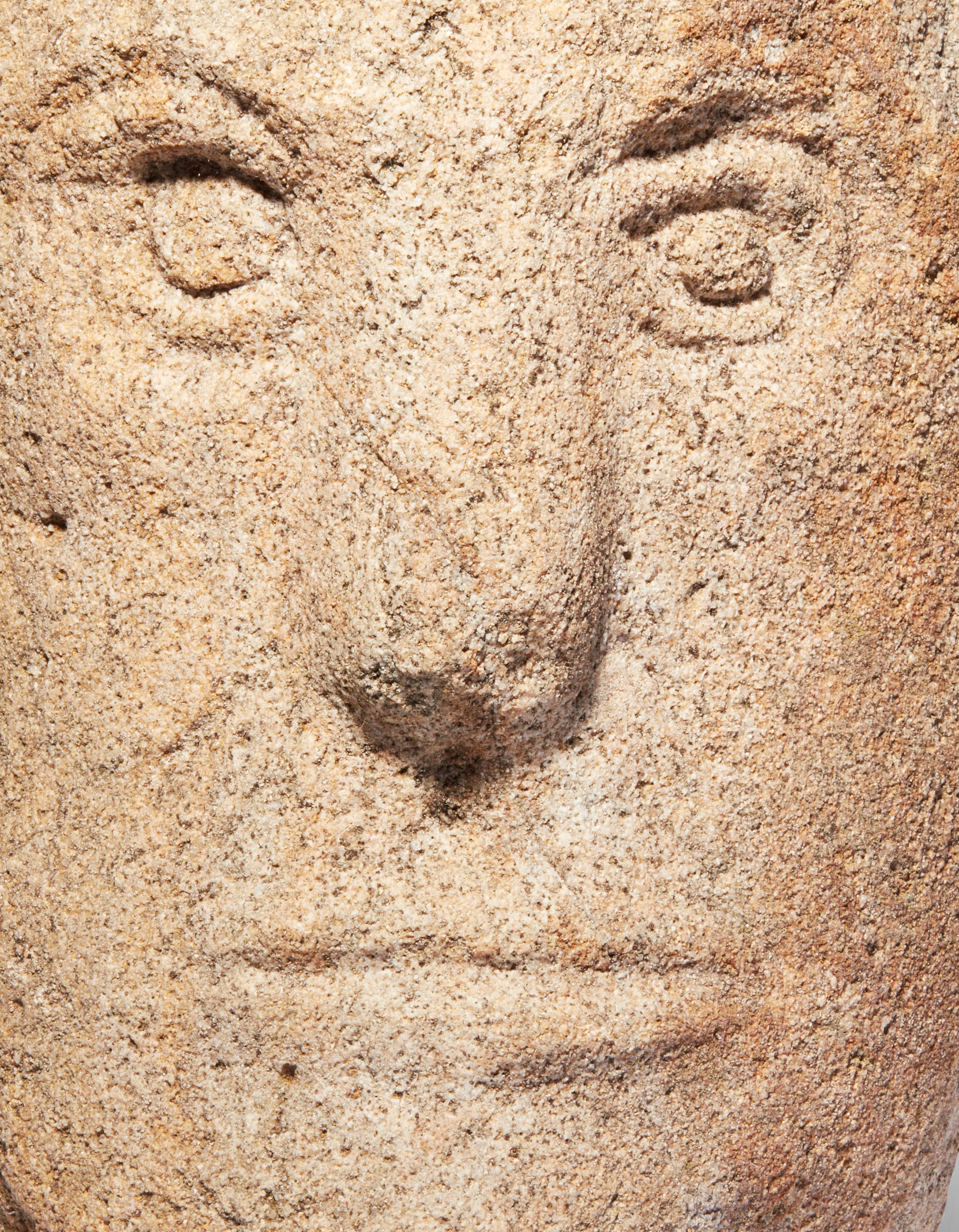
ANCIENT CELTIC STONE HEAD

IRELAND, 300 B.C. - 200 A.D.
carved and weathered granite, of powerful visage, carved with arched brows, concentric circle eyes, with a flaring nose and a horizontal carved groove indicating a mouth
22.5cm high
Stone votive heads are perhaps the most enigmatic of all the art produced by the Iron Age peoples of Britain, Ireland and continental Europe, often termed “Celts”. Frequently found near bodies of water, their function is not clear, suggestions have included their use as surrogates in head hunting societies, cult foci, or as venerated objects of healing. The ubiquity of the head motif sculpted in stone or carved in metal suggests that the ancient Britons held it in special reverence, likely believing it to be the centre of the soul.
£7,000-10,000
GANDHARAN HEAD OF BUDDHA
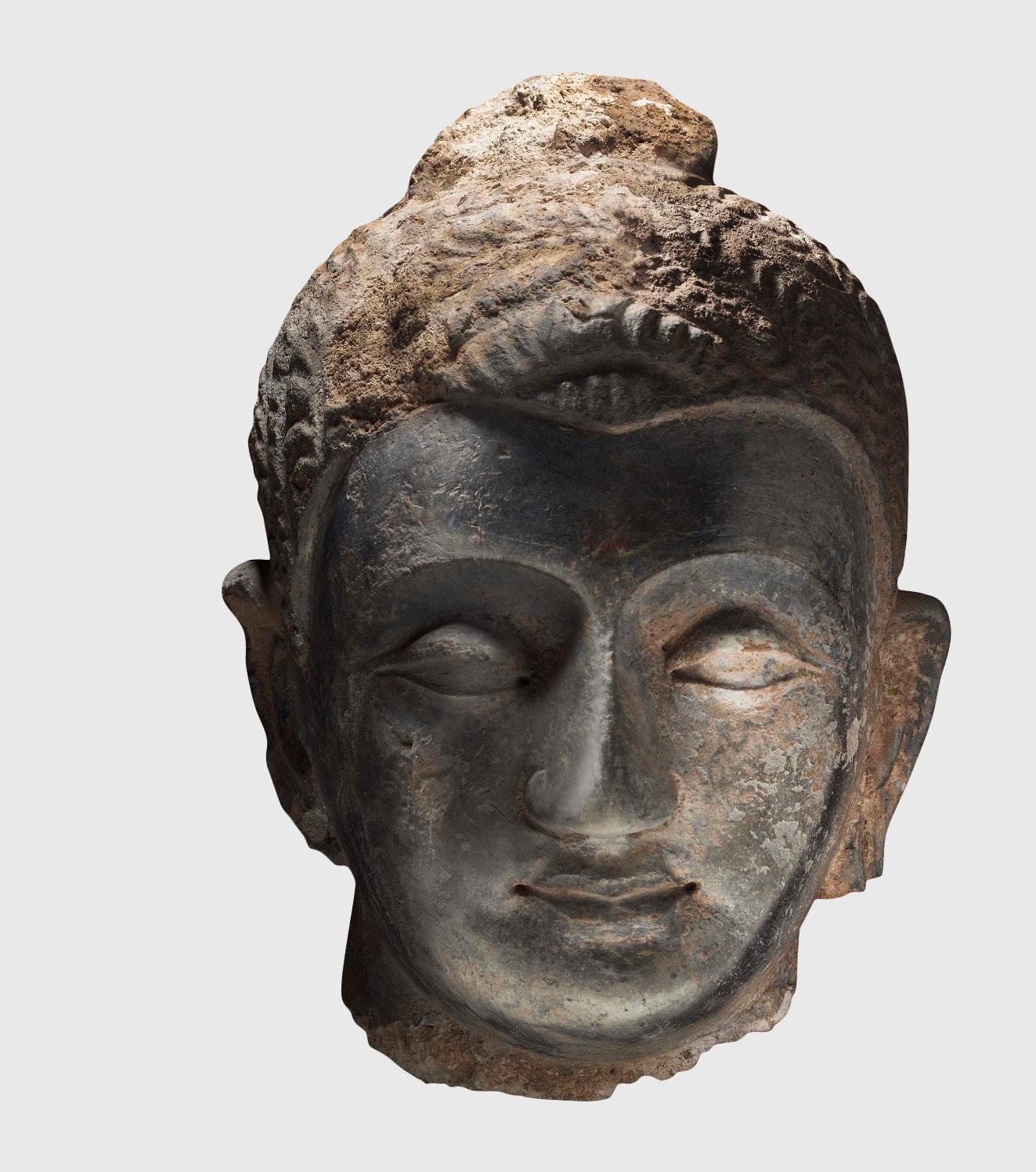
GANDHARA, 4TH - 5TH CENTURY A.D.
dark grey stucco, Buddha is depicted with a serene countenance, his almond-shaped eyes half closed and mouth set with a gentle smile, the hair rises in waves to form a bun-shaped ushnisha, the earlobes characteristically elongated
19.8cm high excl. stand
£3,000-5,000
Provenance: With Spink & Son Ltd. from at least July 1989
Private Japanese Collection, kept in Switzerland, acquired from the above on 27th July 1989
With David Aaron Ltd., London, since 23rd December 2010. Imported from Switzerland to London in February 2011 Private Collection of Mr. L., acquired from the above on 30th August 2017 (D2083)
Note: For a similar example please see Victoria and Albert Museum, London, accession number IM.3-1931
The substitution of stucco and terracotta for the traditional grey schist of earlier Gandharan sculptures allowed for greater artistic innovation and creative freedom. The use of these raw materials allowed for sculptures to be moulded and sculpted while still malleable, rather than requiring intensive chiselling from hard stone, drastically reducing production times. This masterfully crafted sculpture, depicting the Buddha as a young man and originally part of a large-scale figure carved in high-relief, exhibits a wonderfully evocative image. Excavations at various archaeological sites throughout Gandhara have uncovered examples of moulds for similar Buddha heads, suggesting that they were created at the monasteries where they were installed.
The Gandhara kingdom, located in the Peshawar Valley and the Potohar Plateau, was a deeply Buddhist province with strong ties to the teachings of the Buddha since his death in 480 B.C. This ancient province was a melting pot of Greco-Roman, Chinese, Indian, and Central Asian influences, resulting in the evolution of a diverse yet idiosyncratic form of Buddhist art. The Kushan Empire, which ruled Gandhara from 30-375 AD., was skilled at assimilating cultures, ruling trade routes, and maintaining close diplomatic ties with the Roman, Chinese, and Sasanian Empires. This sculpture, along with other opus of Kushan Buddhist art from the area, can be dated to between the 4th and 5th centuries A.D. and depicts a fusion of Hellenistic motifs with Orientalist traditions, resulting in a new form of Buddhist iconography where western stylistic signatures such as curled hair and heavy drapery begin to appear prevalent on eastern-like forms.
96
95
73 Other fees apply in addition to the hammer price: see the ‘Buyer’s Guide’ section on page 2
OLMEC MASQUETTE
MEXICO, 900 - 400 B.C.

carved and polished green serpentine, the distinctive features displaying a subtly downturned mouth, broad nose and narrowed eyes framed by a frowning brow, the ears pierced, raised on a bespoke mount 10.5cm tall (unmounted)
Provenance: Ex Samuel Dubiner Collection, Canada (1960s) Barry Kernerman, Toronto Ortiz Collection, Miami £20,000-30,000
97
74
The Olmec civilization, which thrived in the Gulf Coast region of Mexico from approximately 1400 - 400 BC, is renowned for its remarkable artistic achievements, among which serpentine masks such as the present example are particularly noteworthy. Crafted from the distinctive deep green stone, they were characterised by intricate carvings that depicted human visages with exaggerated features, such as downturned mouths, almond-shaped eyes, and broad noses. The masks also incorporated serpentine imagery in the form of coiled snakes or serpent-like figures that surrounded the faces or extended from the top of the masks. It is believed that serpentine masks were utilised in ceremonial and ritual contexts, likely in conjunction with funerary practices or religious festivals, and were probably worn by priests or other elite members of society during these events. The masks also held symbolic value as status symbols, owing to their valuable materials and the skilled craftsmanship required to create them.

The Olmec civilization has had a profound impact on the development of modern art, particularly during the early 20th century, when Western artists rediscovered the art of ancient cultures, including that of the Olmec. This renewed interest in Olmec art influenced the emergence of modernist art movements such as Cubism and Surrealism. Olmec sculptures’ stylised, geometric forms, such as the iconic “colossal heads,” served as sources of inspiration for artists such as Pablo Picasso and Henry Moore, while the Olmec’s use of negative space and abstraction was influential in the development of modernist sculpture. In addition, the Olmec’s fascination with the natural world, particularly the serpent, inspired Surrealist artists such as Salvador Dali and Max Ernst, who integrated serpent imagery into their works.
The Olmec’s use of jade and other precious materials also influenced modernist jewellery and decorative arts. Today, the Olmec’s legacy remains a significant source of inspiration for contemporary artists who continue to draw on its bold forms and use of negative space.

75 Other fees apply in addition to the hammer price: see the ‘Buyer’s Guide’ section on page 2
MEZCALA CHONTAL MASK
MEXICO, 700-200 B.C.
light green stone carved with minimal, geometric facial features with heavy eyebrows, a long nose and small mouth, a central drill hole on top of the head, encrustations all over, on a bespoke mount 14cm high

Private collection, New Mexico, United States
Private collection, London, United Kingdom, acquired from the above £1,000-1,500

98
76
KRINJABO MEMORIAL HEAD COTE D’IVOIRE
terracotta, the neck ringed, scarification in relief on the cheeks and temples

18.5cm tall
Provenance: Private collection, United Kingdom
Note: ”Krinjabo, now a town in south-eastern Ivory Coast near Ghana, was established as a kingdom in the early eighteenth century when the Anyi peoples migrated there from Ghana. Clay heads and figures commemorating deceased members of the community are characteristic of this area, and were made by skilled women potters. The figures were placed with other funerary statue in special sanctuaries.” (Robbins and Nooter, 2004, p 191)
£500-1,000
100
AFRICAN EBONY BUST WEST AFRICA

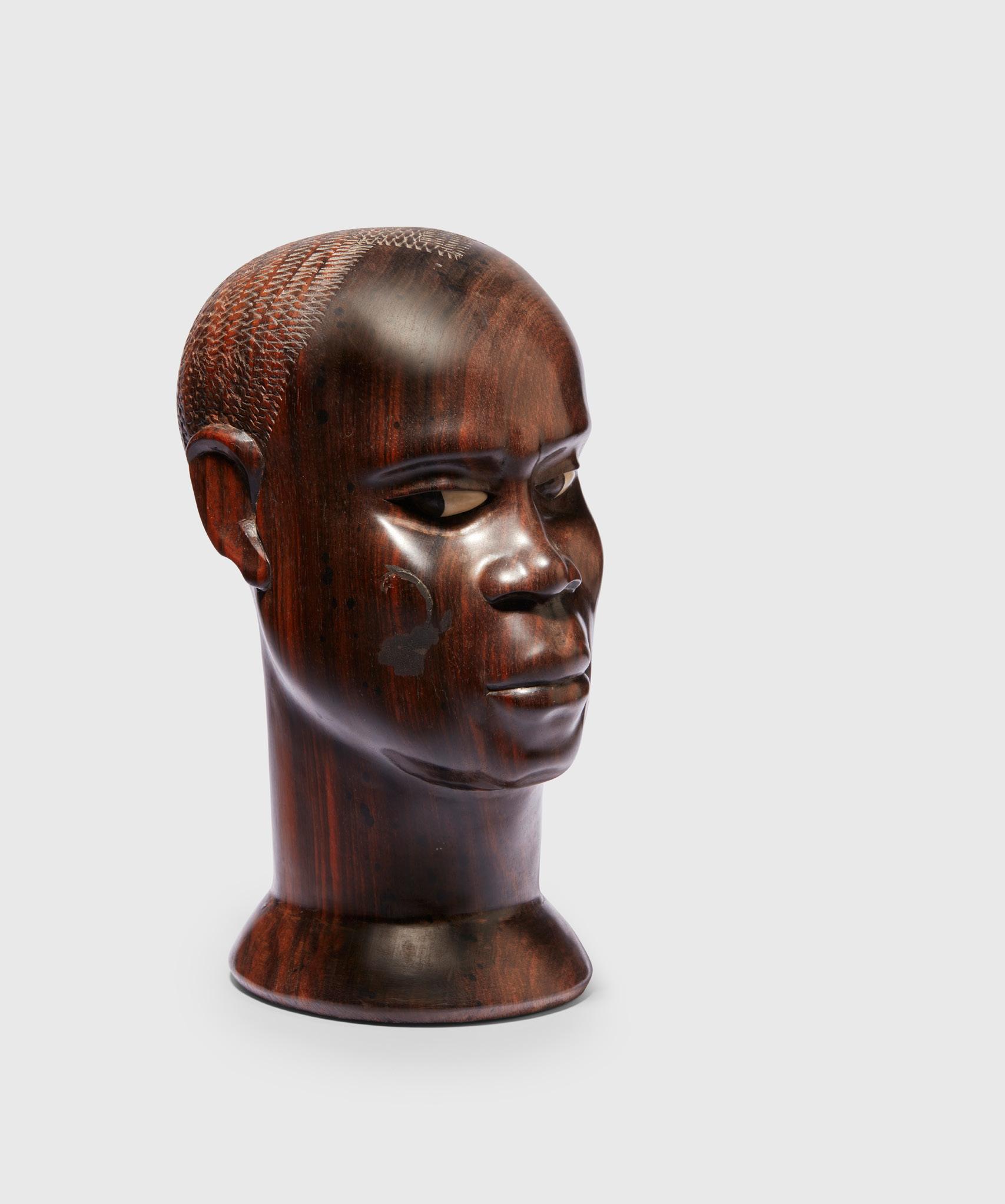
carved ebony and shell inlay, standing on a convex base, the eyes inlaid with the pupils looking over to the right hand side, lending a somewhat whimsical quality
25cm high
Provenance: Michael GrahamStuart, London, United Kingdom Private collection, acquired from the above 13th March 1998, a copy of the original invoice to be provided to the winning bidder
£300-500
AFRICAN BUST FROM THE ALBERTO MORROCCO COLLECTION WEST AFRICA
terracotta, carved wood and pigment, the female bust formed of fired terracotta, the chest and shoulders formed into a cone, the facial features finely detailed, the coiffure held back from the forehead in a headband, raised on a painted mount produced by Morrocco
22cm high
Provenance: Private collection, London, United Kingdom, acquired at Christie’s, South Kensington, 11th July 2012, A Celebration: The Studio of Alberto Morrocco & Binrock House, Dundee
£400-600
99
101
77 Other fees apply in addition to the hammer price: see the ‘Buyer’s Guide’ section on page 2
During the Viking era, both men and women wore jewellery, typically made from bronze or silver, with gold being reserved for the elite. At the onset of the Viking era in 800 A.D., the jewellery was characterized by minimalistic designs. However, as techniques evolved and Vikings encountered new cultures through exploration and raiding, jewellery became increasingly intricate, incorporating designs from these cultures. Certain families of high social standing began to use ornamentation that was exclusive to their clan, and not to be replicated by others.
103
VIKING BRAIDED GOLD PENNANULAR BRACELET
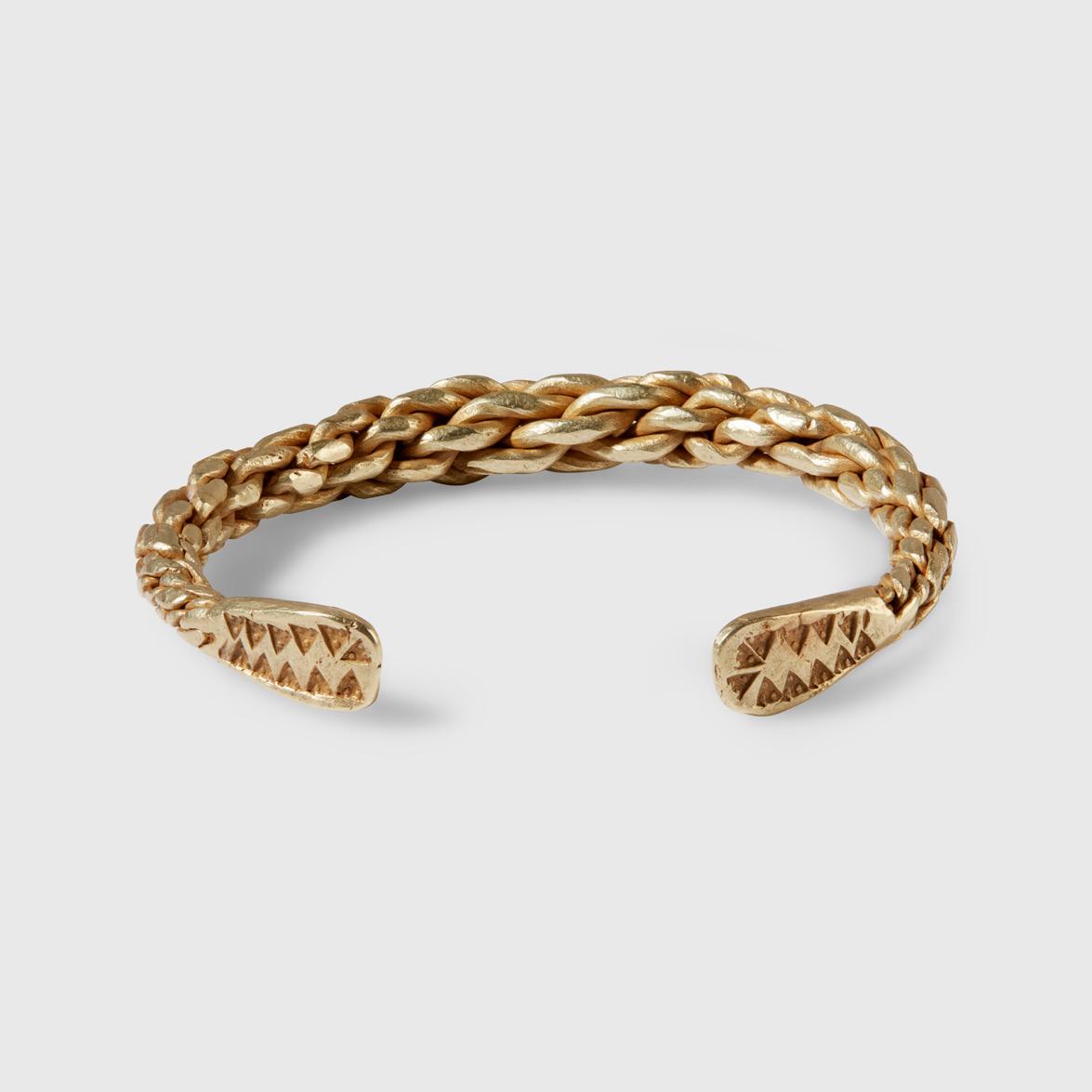

EASTERN SCANDINAVIA OR THE BALTIC, EARLY 2ND MILLENNIUM A.D. gold, formed of a series of interwoven strands combining and tapering at the edges to form solid flat terminals stamped with triangular decorative elements
7.5cm diameter
Provenance: Freeman and Sear, Los Angeles
The Hall Family Collection
Fortuna Fine Arts
Private collection, United Kingdom, acquired from the above, a copy of the original invoice to be included with the item
Note: Please note that this item has been studied and assessed by experts at the Jorvik Viking Museum, York.
£4,000-6,000
102
VIKING GOLD BRACELET
EASTERN SCANDINAVIA OR THE BALTIC, EARLY 2ND MILLENNIUM A.D.
gold, formed from eight braided strands hammered into elegant solid finials with looped ornament
8.6cm diameter
Provenance: Christian Blom, New York
The Hall Family Collection, acquired from the above
Fortuna Fine Arts
Private collection, United Kingdom, acquired from the above, a copy of the original invoice to be included with the item
Note: Please note that this item has been studied and assessed by experts at the Jorvik Viking Museum, York.
£5,000-7,000
Beyond their decorative function and status symbol, jewellery served as a form of currency during this period. Pieces were often broken up into smaller parts to accommodate transactions, resulting in complete pieces becoming rare
78 Other fees apply in addition to the hammer price: see the ‘Buyer’s Guide’ section on page 2
104
EXCEPTIONAL VIKING GOLD TORC

EASTERN SCANDINAVIA OR THE BALTIC, 900 - 1100 A.D.
gold, formed of strands of thick gold braided together and hammered into a single strand at the finials
15cm diameter, 79.32g
Provenance: BA Seaby Ltd, 11 Margaret Street, London, United Kingdom
Private collection, Kansas City, United States, acquired 1981 from the above
The Hall Family Collection
Fortuna Fine Arts
Private collection, United Kingdom, acquired from the above, a copy of the original invoice to be included with the item
Note: Please note that this item has been studied and assessed by experts at the Jorvik Viking Museum, York.
£15,000-25,000
79 Other fees apply in addition to the hammer price: see the ‘Buyer’s Guide’ section on page 2
105
VIKING GOLD TORC

EASTERN SCANDINAVIA OR THE BALTIC, 900 - 1100 A.D. gold, formed of strands of thick gold braided together in the lower half and hammered into a single strand in the top half 14.2cm diameter, 105g
Provenance: BA Seaby Ltd, 11 Margaret Street, London, United Kingdom
Private collection, Kansas City, United States
The Hall Family Collection
Private collection, London, United Kingdom
Note: Please note that this item has been studied and assessed by experts at the Jorvik Viking Museum, York.
£10,000-15,000
80 Other fees apply in addition to the hammer price: see the ‘Buyer’s Guide’ section on page 2
106
VIKING GOLD BRACELET EASTERN SCANDINAVIA OR THE BALTIC, EARLY 2ND MILLENNIUM A.D.
formed of solid gold, the exterior stamped with alternating bands of circular and triangular decoration, terminating in dual loops
8.2cm diameter
Simon Bendall, London, United Kingdom
The Hall Family Collection, acquired from the above Fortuna Fine Arts
Private collection, United Kingdom, acquired from the above, a copy of the original invoice to be included with the item
Note: Please note that this item has been studied and assessed by experts at the Jorvik Viking Museum, York.
£3,000-5,000
107
VIKING GOLD FINGER RING
EASTERN SCANDINAVIA OR THE BALTIC, EARLY 2ND MILLENNIUM A.D.
gold, formed of six interwoven bands tapering into a thinner, solid section
UK size: V, US size: 11
Note: Please note that this item has been studied and assessed by experts at the Jorvik Viking Museum, York.
£1,500-2,000
108
VIKING GOLD FINGER RING
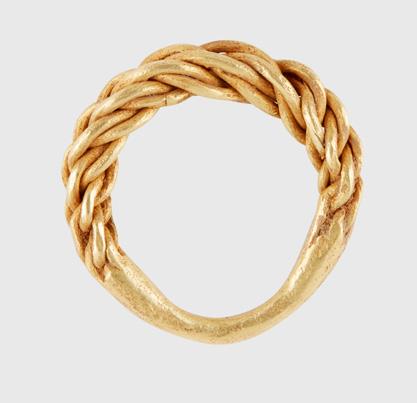

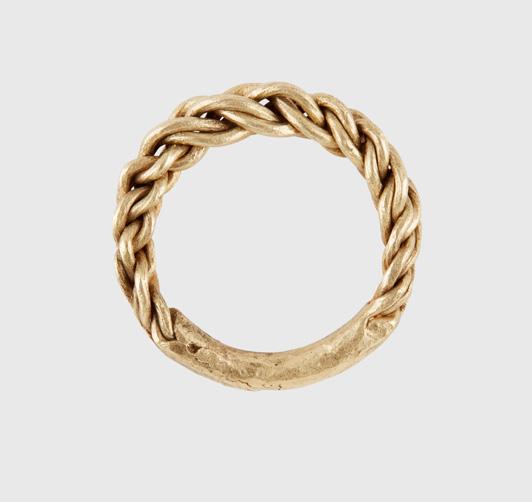
EASTERN SCANDINAVIA OR THE BALTIC, EARLY 2ND MILLENNIUM A.D.
gold, formed of three interwoven bands tapering into a thinner, solid section
UK size: V, US size: 11
Private collection, California
The Hall Family Collection, acquired from the above Fortuna Fine Arts
Private collection, United Kingdom, acquired from the above, a copy of the original invoice to be included with the item
Note: Please note that this item has been studied and assessed by experts at the Jorvik Viking Museum, York. £1,500-2,000
106 108 107 81
109
ANCIENT GREEK GOLD BANGLE
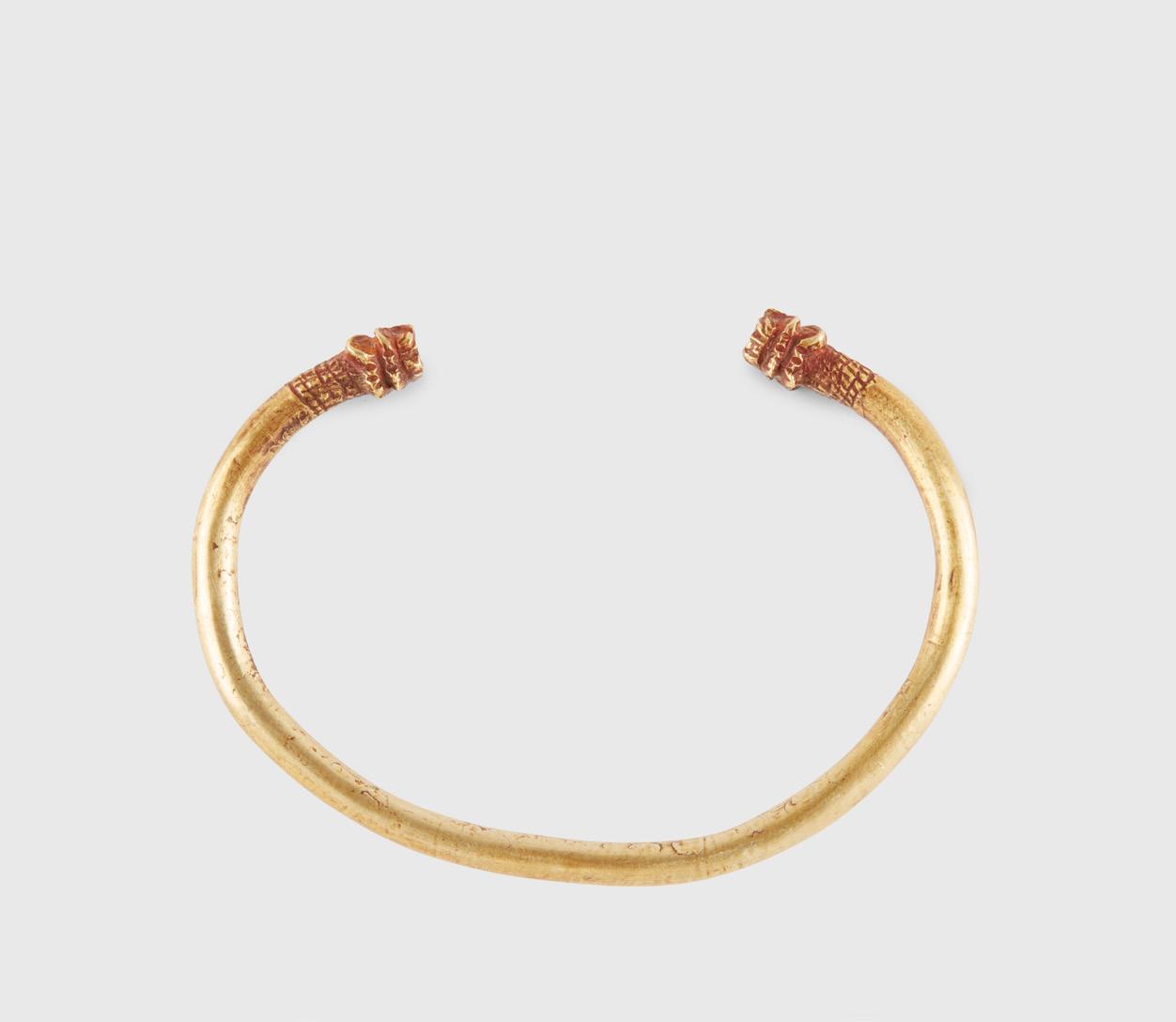
EASTERN MEDITERRANEAN, 5TH - 4TH CENTURY B.C. solid gold bangle with lions head terminals 7cm diameter
Private collection, London, formed 1965 - 2016
£300-500
110
HELLENISTIC GOLD BRACELET WITH INSCRIPTION
NEAR EAST, CLASSICAL PERIOD OR LATER gold, the circular bangle with a stamped inscription reading: Philometor (Greek: Φιλομήτωρ), meaning “mother-loving”, a common royal epithet among the Hellenistic monarchs Antiochus VIII Philometor and Ariarathes VII Philometor, King of Cappadocia

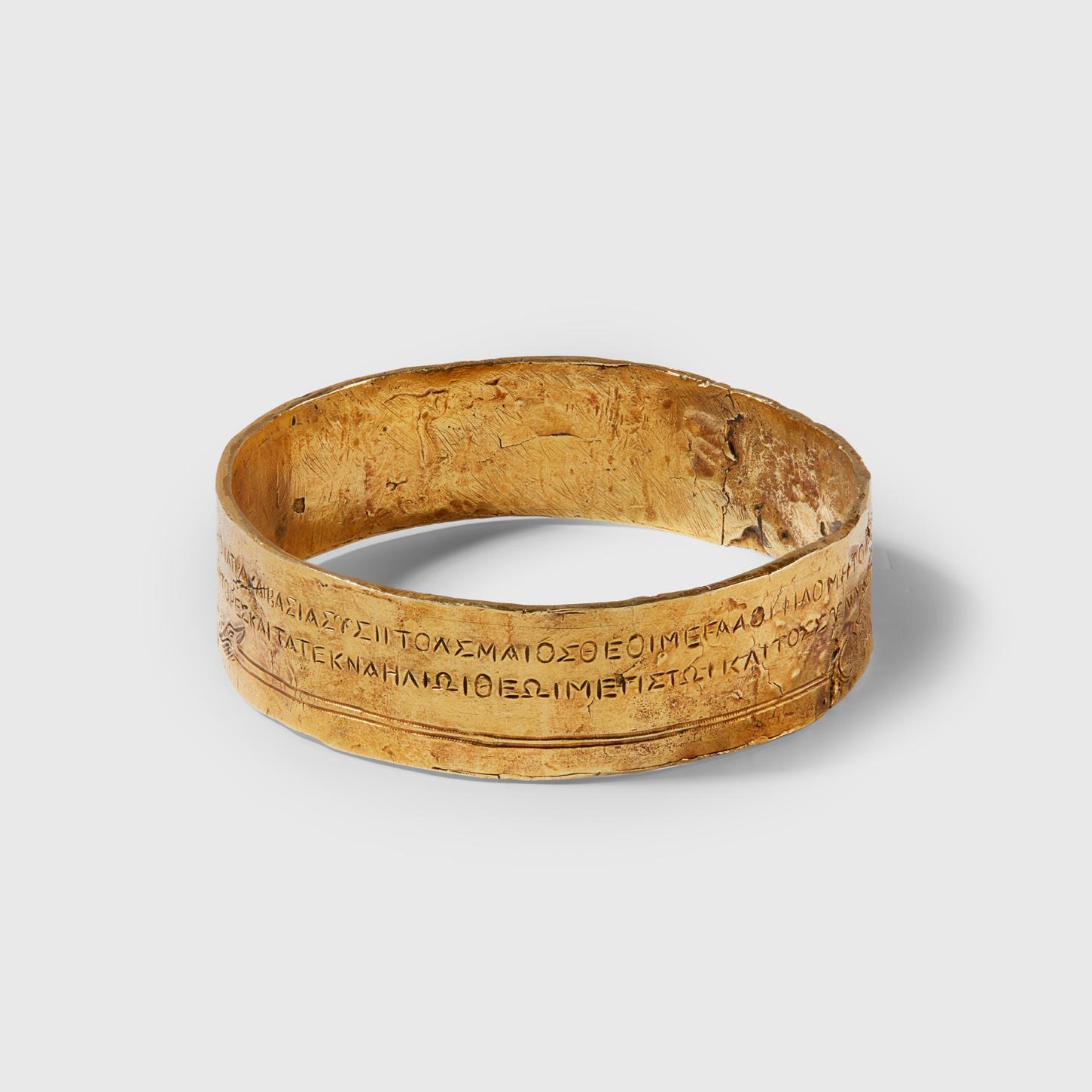
7.4cm diameter, 92.9 grams
Provenance: Formally in the collection of Jeanne Tachard 1870-1930, thence by descent
Note: Please note, whilst the bangle itself has been assessed as ancient, the incription appears to be a later addition.
£600-900
82
111
ANCIENT NEAR EASTERN NECKLACE
NEAR EAST, 2ND CENTURY B.C. - 1ST CENTURY A.D
restrung on a modern string, consisting of ancient carnelian beads and gold spacers, with a central gold pendant 51cm long, medallion 5.1 diameter
Provenance: Previously in a private collection, acquired between 1965 – 2020 £1,200-1,800
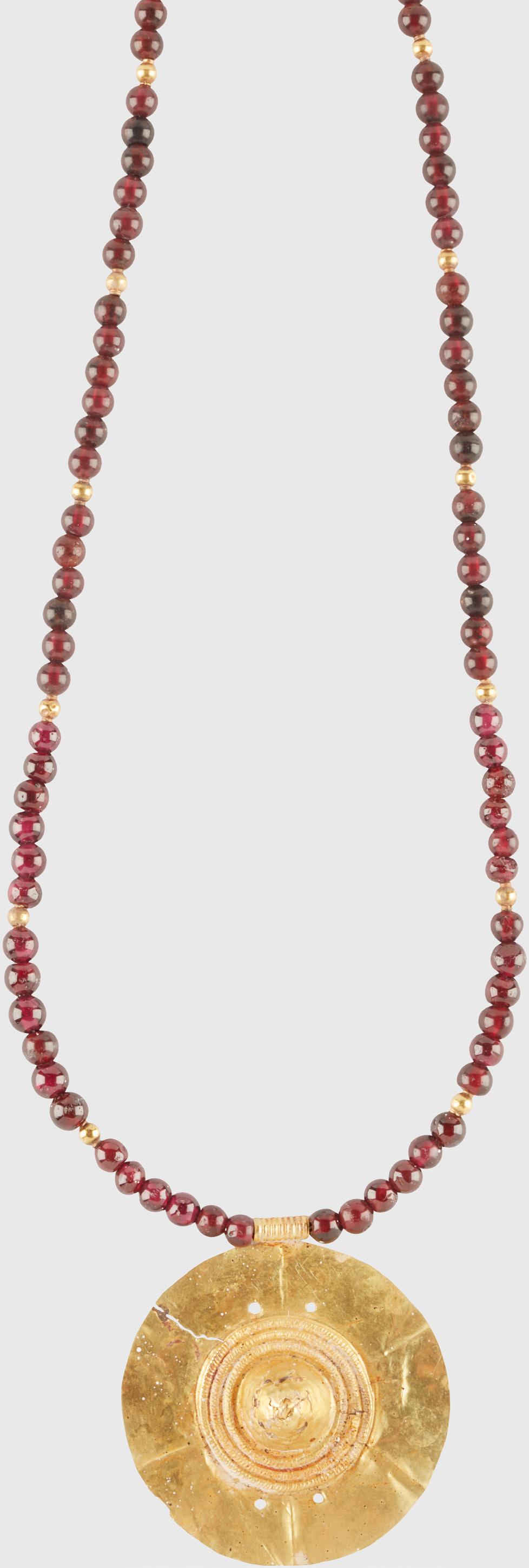
83 Other fees apply in addition to the hammer price: see the ‘Buyer’s Guide’ section on page 2
ANCIENT CARNELIAN AND GOLD NECKLACE
NEAR EAST, 1ST MILLENNIUM B.C.
carnelian and gold necklace, restrung on a modern string, consisting of ancient carnelian beads of varying form interspersed with modern gold spherical spacers
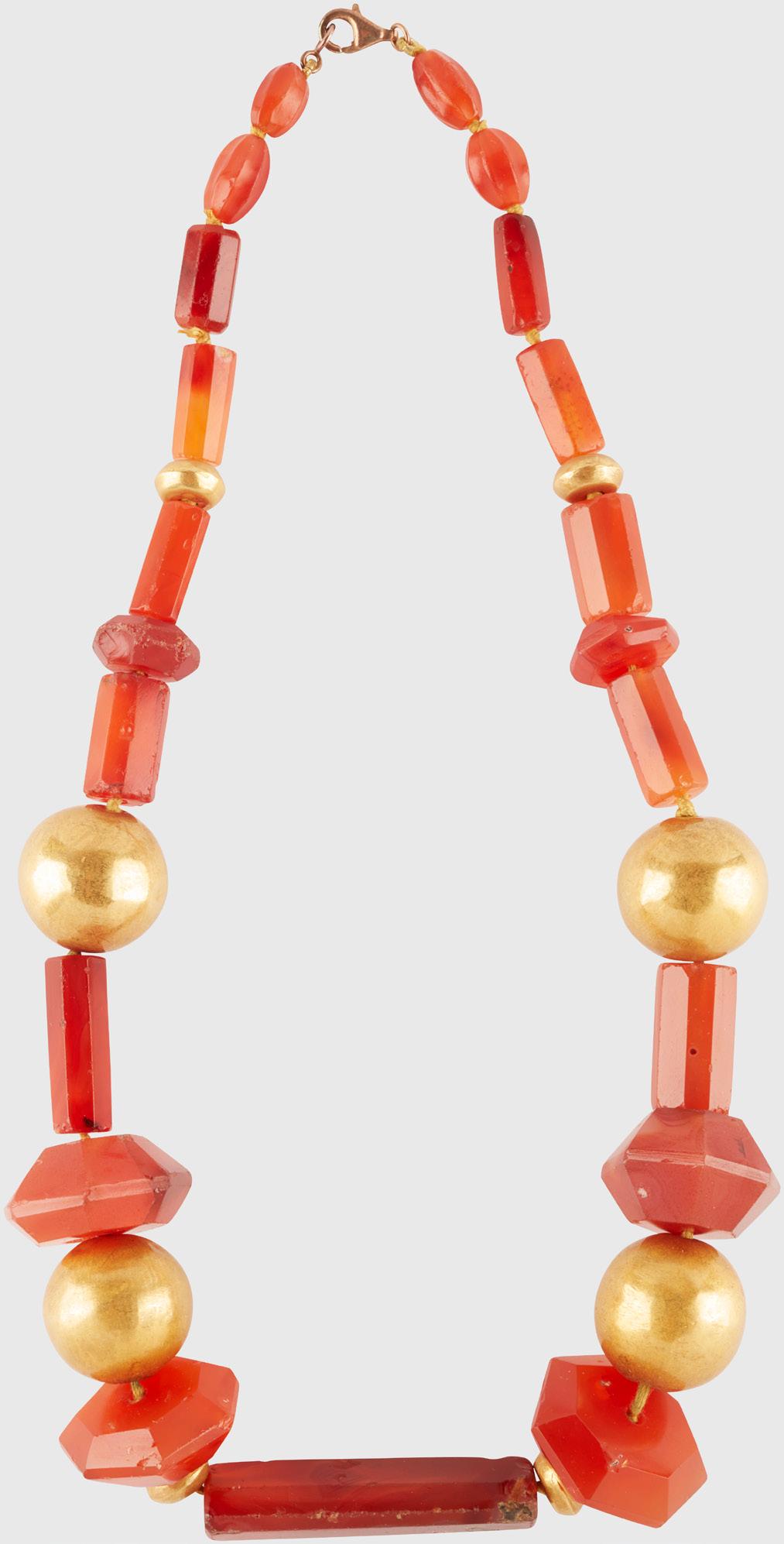

24.2cm long
Provenance: Private collection, London, United Kingdom, formed over the past fifty years
£1,000-1,500
ANCIENT BACTRIAN LAPIS LAZULI BEAD NECKLACE
CENTRAL ASIA, 1ST MILLENNIUM B.C.
gold and lapis necklace, restrung on a modern string, consisting of ancient lapis tube beads and a pair of compressed sphere gold beads

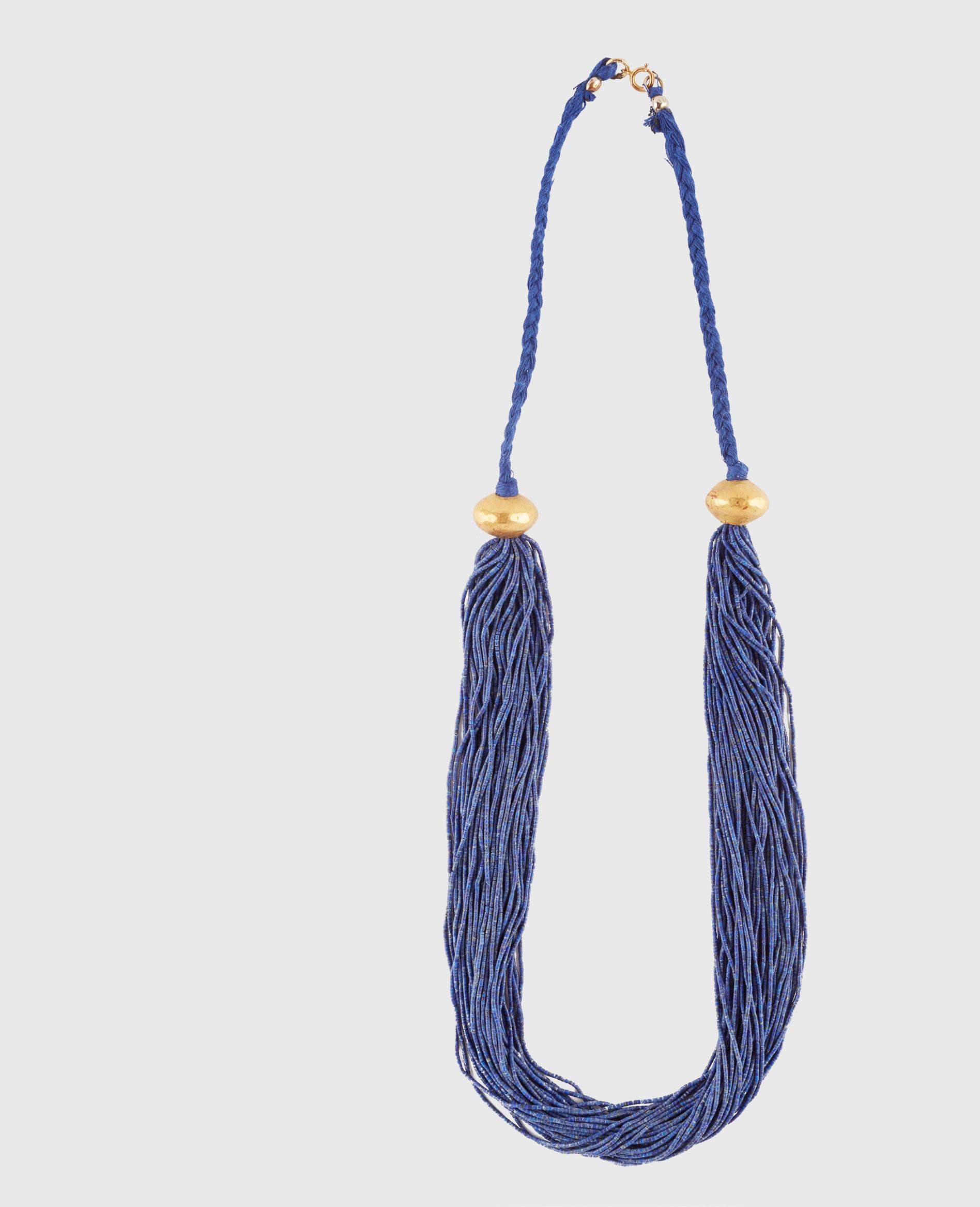
30.8cm long
Provenance: Private collection, London, United Kingdom, formed over the past fifty years
£1,000-1,500
113
84
115
ANCIENT CARNELIAN AND LAPIS LAZULI NECKLACE NEAR EAST
restrung ancient beads, formed of three tubular carnelian beads, a large central oblong bead with gold mounts at either end, two pairs of small lapis beads leading to two thin carnelian tubular beads, above which sit eight small lapis beads interspersed with modern gold spacers


51cm long
Provenance: Private collection, London, United Kingdom, formed 1965 - 2020
£1,500-2,500
114
EARLY ISLAMIC ROCK CRYSTAL BEAD NECKLACE
NEAR EAST, 6TH - 7TH CENTURY A.D. composed of twelve rock crystal beads, interspersed with modern openwork gold beads, strung with a modern gold hook-andloop closure


20.4cm long
Provenance: Private collection, London, United Kingdom, formed over the past fifty years £800-1,200
85 Other fees apply in addition to the hammer price: see the ‘Buyer’s Guide’ section on page 2
ANCIENT NEAR EASTERN NECKLACE

NEAR EAST, 2ND CENTURY B.C. - 1ST CENTURY A.D.
restrung ancient beads, necklace with turquoise tubular beads throughout, the base with two garnet teardrop charms and a central charm of gold and carnelian in the form of a flower
45.9cm long
Provenance: Private collection, London, United Kingdom, formed between 1965 - 2020 £1,200-1,800
116
86 Other fees apply in addition to the hammer price: see the ‘Buyer’s Guide’ section on page 2


AUCTION 16 AUGUST | LIVE IN EDINBURGH & ONLINE | OPEN FOR CONSIGNMENTS For more information please contact Carly Shearer | 0131 557 8844 carly.shearer@lyonandturnbull.com
ANTONY GORMLEY O.B.E., R.A. (BRITISH 1950-)
(MALE FORM) Watercolour 28cm x 36.75cm (11in x 14.5in) £6,000-8,000
SIR
UNTITLED
SAM
(AMERICAN 1984- ) UNTITLED (VENICE RAIN, ROPE 6) 2013 Fabric dye on rope and canvas
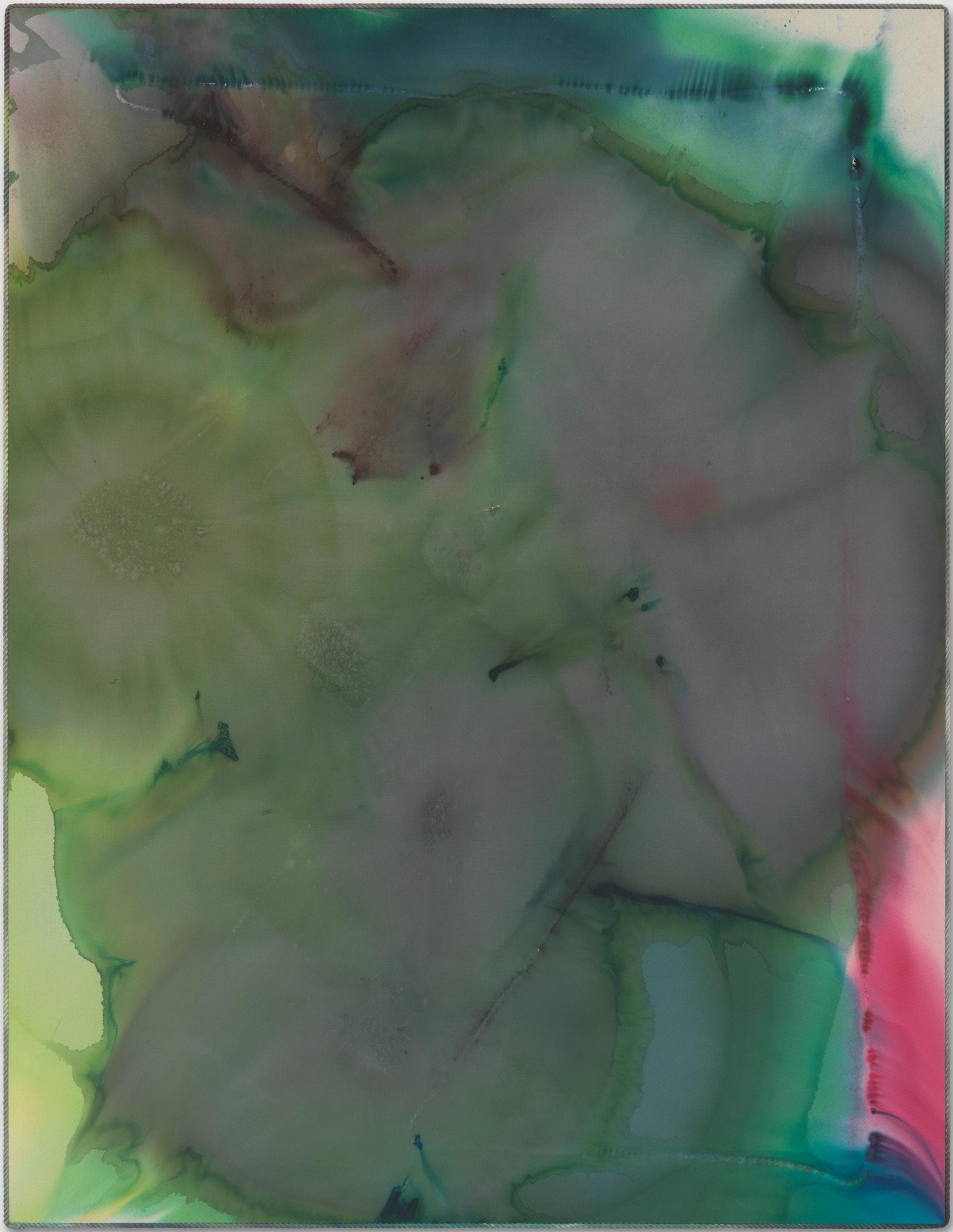

276.9cm x 208.3cm

(109in x 82in)
£7,000-10,000 + fees
ART FROM 1890 TO NOW For more information please contact Simon Hucker | 0207 930 9115 simon.hucker@lyonandturnbull.com AUCTION 26 OCTOBER 2023 MALL GALLERIES, LONDON & LIVE ONLINE OPEN FOR CONSIGNMENTS
FALLS
MODERN & POST-WAR ART, DESIGN & STUDIO CERAMICS
AUCTION 27 OCTOBER 2023
MALL GALLERIES, LONDON & LIVE ONLINE
OPEN FOR CONSIGNMENTS
For more information please contact Philip Smith | 0207 930 9115 philip.smith@lyonandturnbull.com
bronze mounted on a slate base 80.5cm high, 89cm wide (31 3/4in high, 35in wide)
Sold for £22,680 (inc fees) 28 April 2023
 DENIS MITCHELL (BRITISH 1912-1993) PROBUS, 1971
DENIS MITCHELL (BRITISH 1912-1993) PROBUS, 1971
FOR BUYERS (UK)
These Conditions of Sale and the Saleroom Notices as well as specific Catalogue terms, set out the terms on which we offer the Lots listed in this Catalogue for sale. By registering to bid and/or by bidding at auction You agree to these terms, we recommend that You read them carefully before doing so. You will find a list of definitions and a glossary at the end providing explanations for the meanings of the words and expressions used. Special terms may be used in Catalogue descriptions of particular classes of items (Books, Jewellery, Paintings, Guns, Firearms, etc.) in which case the descriptions must be interpreted in accordance with any glossary appearing in the Catalogue. These notices and terms will also form part of our terms and conditions of sales.
In these Conditions the words “Us”, “Our”, “We” etc. refers to Lyon & Turnbull Ltd, the singular includes the plural and vice versa as appropriate. “You”, “Your” means the Buyer. Lyon & Turnbull Ltd. acts as agent for the Seller. Lyon & Turnbull Ltd. acts as agent for the Seller. On occasion where Lyon & Turnbull Ltd. own a lot in part or full the property will be identified in the catalogue with the symbol (��) next to its lot number.
A. BEFORE THE SALE
1. DESCRIPTIONS OF LOTS
Whilst we seek to describe Lots accurately, it may be impractical for us to carry out exhaustive due diligence on each Lot. Prospective Buyers are given ample opportunities to view and inspect before any sale and they (and any independent experts on their behalf) must satisfy themselves as to the accuracy of any description applied to a Lot. Prospective Buyers also bid on the understanding that, inevitably, representations or statements by us as to authorship, genuineness, origin, date, age, provenance, condition or Estimated selling price involve matters of opinion. We undertake that any such opinion shall be honestly and reasonably held and only accept liability for opinions given negligently or fraudulently. Subject to the foregoing neither we the Auctioneer or our employees or agents accept liability for the correctness of such opinions and no warranties, whether relating to description, condition or quality of Lots, express, implied or statutory, are given. Please note that photographs/ images provided may not be fully representative of the condition of the Lot and should not be relied upon as indicative of the overall condition of the Lot. All dimensions and weights are approximate only.
2. OUR RESPONSIBILITY FOR OUR DESCRIPTION OF LOTS
We do not provide any guarantee in relation to the nature of a Lot apart from our authenticity warranty contained in paragraph E.2 and to the extent provided below.
(a) Condition Reports: Condition Reports are provided on our Website or upon request. The absence of a report does not imply that a Lot is without imperfections. Large numbers of such requests are received shortly before each sale and department specialists and administration will endeavour to respond to all requests although we offer no guarantee. Any statement in relation to the Lot is merely an expression of opinion of the Seller or us and should not be relied upon as an inducement to bid on the Lot. Lots are available for inspection prior to the sale and You are strongly advised to examine any Lot in which You are interested prior to the sale. Our Condition Reports are not prepared by professional conservators, restorers or engineers. Our Condition Report does not form any contract between us and the Buyer. The Condition Reports do not affect the Buyer’s obligations in any way.
(b) Estimates: Estimates are placed on each Lot to help Buyers gauge the sums involved for the purchase of a particular Lot. Estimates do not include the Buyer’s Premium or VAT. Estimates are a matter of opinion and prepared in advance. Estimates may be subject to change and are for guidance only and should not be relied upon.
(c) Catalogue Alterations: Lot descriptions and Estimates are prepared in advance of the sale and may be subject to change. Any alterations will be announced on the Catalogue alteration sheet, made available prior to the sale. It is the responsibility of the Buyer to make themselves aware to any alterations which may have occurred.
3. WITHDRAWAL
Lyon & Turnbull may, at its discretion, withdraw any Lot at any time prior to or during the sale of the Lot. Lyon & Turnbull has no liability to You for any decision to withdraw.
4. JEWELLERY, CLOCKS & OTHER ITEMS
(a) Jewellery:
(i) Coloured gemstones (such as rubies, sapphires and emeralds) may have been treated to enhance their look, through methods such as heating and oiling. These methods are accepted practice but may make the gemstone less strong and/or require special care in future.
(ii) All types of gemstones may have been improved by some method. You may request a gemmological report for any Lot which does not have a report if the request is made to us at least
three weeks before the date of the sale and You pay the fee for the report in advance of receiving said report.
(iii) We do not obtain a gemmological report for every gemstone sold in our sales. Where we do get gemmological reports from internationally accepted gemmological laboratories, such reports may be described in the Sale Particulars. Reports will describe any improvement or treatment only if we request that they do so, but will confirm when no improvement or treatment has been made. Because of differences in approach and technology, laboratories may not agree whether a particular gemstone has been treated, the amount of treatment or whether treatment is permanent. The gemmological laboratories will only report on the improvements or treatments known to the laboratories at the date of the report.
(iv) For jewellery sales, all Estimates are based on the information in any gemmological report or, if no gemmological report is available, You should assume that the gemstones may have been treated or enhanced.
(b) Clocks & Watches: All Lots are sold “as seen”, and the absence of any reference to the condition of a clock or watch does not imply the Lot is in good condition and without defects, repairs or restorations. Most clocks and watches will have been repaired during their normal lifetime and may now incorporate additional/newer parts. Furthermore, we make no representation or warranty that any clock or watch is in working order. As clocks and watches often contain fine and complex mechanisms, Buyers should be aware that a general service, change of battery or further repair work, for which the Buyer is solely responsible, may be necessary. Buyers should also be aware that we cannot guarantee a watch will remain waterproof if the back is removed. Buyers should be aware that the importing watches such as Rolex, Frank Muller and Corum into the United States is highly restricted. These watches cannot be shipped to the USA and only imported personally. Clocks may be sold without pendulums, weights or keys.
(c) Alcohol: may only be sold to persons aged of 18 years and over. By registering to bid, You affirm that You are at least that age. All collections must be signed for by a person over the age of 18. We Reserve the right to ask for ID from the person collecting. Buyers of alcohol must make appropriate allowances for natural variations of ullages, conditions of corks and wine. We can provide no guarantees as to how the alcohol may have been stored. There is always a risk of cork failure and allowance by the Buyer must be made. Alcohol is sold “as is” and quality of the alcohol is entirely at the risk of the Buyer and no warranties are given.
(d) Books-Collation: If on collation any named item in the sale Catalogue proves defective, in text or illustration the Buyer may reject the Lot provided he returns it within 21 days of the sale stating the defect in writing. This, however, shall not apply in the case of unnamed items, periodicals, autographed letters, music M.M.S., maps, drawings nor in respect of damage to bindings, stains, foxing, marginal worm holes or other defects not affecting the completeness of the text nor in respect of Defects mentioned in the Catalogue, or at the time of sale, nor in respect of Lots sold for less than £300.
(e) Electrical Goods: are sold as “works of art” only and if bought for use must be checked over for compliance with safety regulations by a qualified electrician first. Use of such goods is entirely at the risk of the Buyer and no warranties as to safety of the goods are given.
(f) Upholstered items: are sold as “works of art” only and if bought for use must be checked over for compliance with safety regulations (items manufactured prior to 1950 are exempt from any regulations). Use of such goods is entirely at the risk of the Buyer and no warranties as to safety of the goods are given. We provide no guarantee as to the originality of any wood/material contained within the item.
B. REGISTERING TO BID
1. NEW BIDDERS
(a) If this is Your first time bidding at Lyon & Turnbull or You are a returning Bidder who has not bought anything from us within the last two years You must register at least 48 hours before an auction to give us enough time to process and approve Your registration. We may, at our discretion, decline to permit You to register as a Bidder. You will be asked for the following:
(i) Individuals: Photo identification (driving licence, national identity card or passport) and, if not shown on the ID document, proof of Your current address (for example, a current utility bill or bank statement)
(ii) Corporate clients: Your Certificate of Incorporation or equivalent document(s) showing Your name and registered address together with documentary proof of directors and beneficial owners, and;
(iii) Trusts, partnerships, offshore companies and other business structures please contact us directly in advance to discuss requirements.
(b) We may also ask You to provide a financial reference and/or a deposit to allow You to bid. For help, please contact our Finance Department on +44(0)131 557 8844.
2. RETURNING BIDDERS
We may at our discretion ask You for current identification as described in paragraph B.1.(a) above, a finance
22.3 90
CONDITIONS OF SALE
reference or a deposit as a condition of allowing You to bid. If You have not bought anything from us in the last two years, or if You want to spend more than on previous occasions, please contact our Finance Department on +44(0)131 557 8844.
3. FAILURE TO PROVIDE THE RIGHT DOCUMENTS
If in our opinion You do not satisfy our Bidder identification and registration procedures including, but not limited to, completing any anti-money laundering and/or anti-terrorism financing checks we may require to our satisfaction, we may refuse to register You to bid, and if You make a successful bid, we may cancel the contract between You and the Seller.
4. BIDDING ON BEHALF OF ANOTHER PERSON
(a) As an authorised Bidder: If You are bidding on behalf of another person, that person will need to complete the registration requirements above before You can bid, and supply a signed letter authorising You to bid for him/ her.
(b) As agent for an undisclosed principal: If You are bidding as an agent for an undisclosed principle (the ultimate Buyer(s)) You accept personal liability to pay the Purchase Price and all other sums due, unless it has been agreed in writing with us before commencement of the auction that the Bidder is acting as an agent on behalf of a named third party acceptable to us and we will seek payment from the named third party.
5. BIDDING IN PERSON
If You wish to bid in the saleroom You must register for a numbered bidding paddle before You begin bidding. Please ensure You bring photo identification with You to allow us to verify Your registration.
6. BIDDING SERVICES
The bidding services described below are a free service offered as a convenience to our clients and we are not responsible for any error (human or otherwise), omission or breakdown in providing these services.
(a) Phone bids
Your request for this service must be made no later than 12 hours prior to the auction. We will accept bids by telephone for Lots only if our staff are available to take the bids. If You need to bid in a language other than English You should arrange this Well before the auction. We do not accept liability for failure to do so or for errors and omissions in connections.
(b) Internet Bids
For certain auctions we will accept bids over the internet. For more information please visit our Website. We will use reasonable efforts to carry out online bids and do not accept liability for equipment failure, inability to access the internet or software malfunctions related to execution of online bids/ live
bidding.
(c) Written Bids
While prospective Buyers are strongly advised to attend the auction and are always responsible for any decision to bid for a particular Lot and shall be assumed to have carefully inspected and satisfied themselves as to its condition we shall, if so instructed, clearly and in writing execute bids on their behalf. Neither the Auctioneer nor our employees nor agents shall be responsible for any failure to do so. Where two or more commission bids at the same level are recorded we Reserve the right in our absolute discretion to prefer the first bid so made. Bids must be expressed in the currency of the saleroom. The Auctioneer will take reasonable steps to carry out written bids at the lowest possible price, taking into account the Reserve. If You make a written bid on a Lot which does not have a Reserve and there is no higher bid than Yours, we will bid on Your behalf at around 50% of the lower Estimate or, if lower, the amount of Your bid.
C. DURING THE SALE
1. ADMISSION TO OUR AUCTIONS
We shall have the right at our discretion, to refuse admission to our premises or attendance at our auctions by any person. We may refuse admission at any time before, during or after the auction.
2. RESERVES
Unless indicated by an insert symbol (∆), all Lots in this Catalogue are offered subject to a Reserve. A Reserve is the confidential Hammer Price established between us and the Seller. The Reserve is generally set at a percentage of the low Estimate and will not exceed the low Estimate for the Lot.
3. AUCTIONEER’S DISCRETION
The maker of the highest bid accepted by the Auctioneer conducting the sale shall be the Buyer and any dispute shall be settled at the Auctioneer’s absolute discretion. The Auctioneer may move the bidding backwards of forwards in any way he or she may decide or change the order of the Lots. The Auctioneer may also; refuse any bid, withdraw any Lot, divide any Lot or combine any two or more Lots, reopen or continuing bidding even after the hammer has fallen.
4. BIDDING
The Auctioneer accepts bids from:
(a) Bidders in the saleroom;
(b) Telephone Bidders, and internet Bidders through Lyon & Turnbull Live or any other online bidding platform we have chosen to list on and;
(c) Written bids (also known as absentee bids or commission bids) left with us by a Bidder before the auction.
5. BIDDING INCREMENTS
Bidding increments shall be at the Auctioneer’s sole discretion.
6. CURRENCY CONVERTER
The saleroom video screens and bidding platforms may show bids in some other major currencies as Well as sterling. Any conversion is for guidance only and we cannot be bound be any rate of exchange used. We are not responsible for any error (human or otherwise) omission or breakdown in providing these services.
7. SUCCESSFUL BIDS
Unless the Auctioneer decides to use their discretion as set out above, when the Auctioneer’s hammer falls, we have accepted the last bid. This means a contract for sale has been formed between the Seller and the successful Bidder. We will issue an invoice only to the registered Bidder who made the successful bid. While we send out invoices by post/or email after the auction, we do not accept responsibility for telling You whether or not Your bid was successful. If You have bid by written bid, You should contact us by telephone or in person as soon as possible after the auction to get details of the outcome of our bid to avoid having to pay unnecessary storage charges.
8. RELEVANT LEGISLATION
You agree that when bidding in any of our sales that You will strictly comply with all relevant legislation including local laws and regulations in force at the time of the sale for the relevant saleroom location.
D. THE BUYER’S PREMIUM, TAXES AND ARTIST’S RESALE ROYALTY
1. THE PURCHASE PRICE
For each Lot purchased a Buyer’s Premium of 26% of the Hammer Price of each Lot up to and including £20,000, plus 25% from £20,001 to £500,000, plus 20% from £500,001 thereafter. VAT at the appropriate rate is charged on the Buyer’s Premium. No VAT is payable on the Hammer Price or premium for printed books or unframed maps bought at auction. Live online bidding may be subject to an additional premium (level dependent on the live bidding service provider chosen). This additional premium is subject to VAT at the appropriate rate as above.
2. VALUE ADDED TAX
Value Added Tax is charged at the appropriate rate prevailing by law at the date of sale and is payable by Buyers of relevant Lots.
(a) Lots affixed with (†): Value Added Tax on the Hammer Price is imposed by law on all items affixed with a dagger
(†). This imposition of VAT maybe because the Seller is registered for VAT within the European Union and is not operating under a Margin Scheme.
(b) Lots affixed with (*): A reduced rate of Value Added Tax on the Hammer Price of 5% is payable. This indicates that a Lot has been imported from outwit the European Union. This reduced rate is applicable to Antique
items.
(c) Lots affixed with [Ω]: Standard rate of Value Added Tax on the Hammer Price and premium is payable. This applies to items that have been imported from outwit the European Union and do not fall within the reduced rate category outlined above.
3. ARTIST’S RESALE ROYALTY (DROIT DE SUITE)
This symbol § indicates works which may be subject to the Droit de Suite or Artist’s Resale Right, which took effect in the United Kingdom on 14th February 2006. We are required to collect a royalty payment for all qualifying works of art. Under new legislation which came into effect on 1st January 2012 this applies to living artists and artists who have died in the last 70 years. This royalty will be charged to the Buyer on the Hammer Price and in addition to the Buyer’s Premium. It will not apply to works where the Hammer Price is less than €1,000 (euros). The charge for works of art sold at and above €1,000 (euros) and below €50,000 (euros) is 4%. For items selling above €50,000 (euros), charges are calculated on a sliding scale. All royalty charges are paid to the Design and Artists Copyright Society (‘DACS’) and no handling costs or additional fees are retained by the Auctioneer. Resale royalties are not subject to VAT. Please note that the royalty payment is calculated on the rate of exchange at the European Central Bank on the date of the sale. More information on Droit de Suite is available at www.dacs.org.uk.
E. WARRANTIES
1. SELLER’S WARRANTIES
For each Lot, the Seller gives a warranty that the Seller;
(a) Is the owner of the Lot or a joint owner of the Lot acting with the permission of the other co-owners, or if the Sellers is not the owner of or a joint owner of the Lot, has the permission of the owner to sell the Lot, or the right to do so in law, and;
(b) Had the right to transfer ownership of the Lot to the Buyer without any restrictions or claims by anyone else. If either other above warranties are incorrect, the Seller shall not have to pay more than the Purchase Price (as defined in the glossary) paid by You to us. The Seller will not be responsible to You for any reason for loss of profits or business, expected savings, loss of opportunity or interest, costs, damages, other damages or expense. The Seller gives no warranty in relation to any Lot other than as set out above and, as far as the Seller is allowed by law, all warranties from the Seller to You, and all obligations upon the Seller which may be added to this agreement by law, are excluded.
2. AUTHENTICITY GUARANTEE
We guarantee that the authorship, period, or origin (collectively,
91
“Authorship”) of each Lot in this Catalogue is as stated in the BOLD or CAPITALISED type heading in the Catalogue description of the Lot, as amended by oral or written saleroom notes or announcements. We make no warranties whatsoever, whether express or implied, with respect to any material in the Catalogue other than that appearing in the Bold or Capitalised heading and subject to the exclusions below.
In the event we, in our reasonable opinion, deem that the conditions of the authenticity guarantee have been satisfied, it shall refund to the original purchaser of the Lot the Hammer Price and applicable Buyer’s Premium paid for the Lot by the original purchaser. This Guarantee does not apply if:
(a) The Catalogue description was in accordance with the opinion(s) of generally accepted scholar(s) and expert(s) at the date of the sale, or the Catalogue description indicated that there was a conflict of such opinions; or
(b) the only method of establishing that the Authorship was not as described in the Bold or Capitalised heading at the date of the sale would have been by means or processes not then generally available or accepted; unreasonably expensive or impractical to use; or likely (in our reasonable opinion) to have caused damage to the Lot or likely to have caused loss of value to the Lot; or
(c) There has been no material loss in value of the Lot from its value had it been in accordance with its description in the Bold or Capitalised type heading. This Guarantee is provided for a period of one year from the date of the relevant auction, is solely for the benefit of the original purchaser of the Lot at the auction and may not be transferred to any third party. To be able to claim under this Authenticity Guarantee, the original purchaser of the Lot must:
(a) notify us in writing within one month of receiving any information that causes the original purchaser of record to dispute the accuracy of the Bold or Capitalised type heading, specifying the Lot number, date of the auction at which it was purchased and the reasons for such dispute; and
(b) return the Lot to our registered office in the same condition as at the date of sale to the original purchaser of record and be able to transfer good title to the Lot, free from any third party claims arising after the date of such sale.
We have discretion to waive any of the above requirements. We may require the original purchaser of the Lot to obtain, at the original purchaser of Lot’s cost, the reports of two independent and recognised experts in the field. The reports must be mutually acceptable to us and the original purchaser of the Lot. We shall not be bound by any reports produced by the original purchaser of the Lot, and Reserves the
right to seek additional expert advice at its own expense. It is specifically understood and agreed that the rescission of a sale and the refund of the original Purchase Price paid (the successful Hammer Price, plus the Buyer’s Premium) is exclusive and in lieu of any other remedy which might otherwise be available as a matter of law. Lyon & Turnbull and the Seller shall not be liable for any incidental or consequential damages incurred or claimed, including without limitation, loss of profits or interest.
3. YOUR WARRANTIES
(a) You warrant that the funds used for settlement are not connected with any criminal activities, including tax evasion and You are neither; under investigation, have been charged with or convicted of money laundering, terrorist activities or other crimes.
(b) Where You are bidding on behalf of another person You warrant that:
(i) You have conducted appropriate customer due diligence on the ultimate Buyer(s) of the Lot(s) in accordance with all relevant anti-money laundering legislation, consent to us relying on this due diligence, and You will retain for a period of not less than five years the documentation evidencing the due diligence. You will make such documentation promptly available for immediate inspection by a third party auditor upon our written request to do so;
(ii) The arrangements between You and the ultimate Buyer(s) in relation to the Lot or otherwise do not, in whole or in part, facilitate tax crimes, and;
(iii) You do not know, and have no reason to suspect that the funds used for settlement are connected with the proceeds of any criminal activity, including tax evasion, or that the ultimate Buyer(s) are under investigation or have been charged with or convicted of money-laundering, terrorist activities, or other crimes.
F. PAYMENT
1. MAKING PAYMENT
(a) Within 7 days of a Lot being sold You will pay to us the Total Amount Due in cash or by such other method as is agreed by us. We accept cash, bank transfer (details on request), debit cards and Visa or MasterCard credit cards. Please note that we do not accept cash payments over £5,000 per Buyer per year.
(b) Any payments by You to us can be applied by us towards any sums owing by You to us howsoever incurred and without agreement by You or Your agent, whether express or implied.
(c) We will only accept payment from the registered Bidder. Once issued, we cannot change the Buyer’s name on an invoice or re-issue the invoice in a different name.
(d) The ownership of any Lots purchased shall not pass to You until You have made payment in full to us
of the Total Amount Due. The risk in and the responsibility for the Lot will transfer to You from whichever is the earlier of the following:
(i) When You collect the Lot; or
(ii) At the end of the 30th day following the date of the auction, or, if earlier, the date the Lot is taken into care by a third party unless we have agreed otherwise with You in writing.
(e) You shall at Your own risk and expense take away any Lots that You have purchased and paid for not later than 7 working days following the day of the auction or upon the clearance of any cheque used for payment whichever is later. We can provide You with a list of shippers. However, we will not be responsible for the acts or omissions of carriers or packers whether or not recommended by us.
(f) No purchase can be claimed or removed until it has been paid for.
(g) It is the Buyer’s responsibility to ascertain collection procedures, particularly if the sale is not being held at our main sale room and the potential storage charges for Lots not collected by the appropriate time.
2. IN THE EVENT OF NONPAYMENT
If any Lot is not paid for in full and taken away in accordance with these Conditions or if there is any other breach of these Conditions, we, as agent for the Sellers and on their behalf, shall at our absolute discretion and without prejudice to any other rights we may have, be entitled to exercise one or more of the following rights and remedies:
(a) To proceed against You for damages for breach of contract;
(b) To rescind the contract for sale of that Lot and/or any other Lots sold by us to You;
(c) To resell the Lot(s) (by auction or private treaty) in which case You shall be responsible for any resulting deficiency in the Total Amount Due (after crediting any part payment and adding any resale costs).
(d) To remove, store and insure the Lot in the case of storage, either at our premises or elsewhere and to recover from You all costs incurred in respect thereof;
(e) To charge interest at a rate of 5% a year above the Bank of Scotland base rate from time to time on all sums outstanding for more than 7 working days after the sale;
(f) To retain that or any other Lot sold to You until You pay the Total Amount Due;
(g) To reject or ignore bids from You or Your agent at future auctions or to impose conditions before any such bids shall be accepted;
(h) To apply any proceeds of sale of other Lots due or which become due to You towards the settlement of the Total Amount Due by You and to exercise a lien over any of Your
property in our possession for any purpose until the debt due is satisfied. You will be deemed to have granted such security to us and we may retain such property as collateral security for Your obligations to us; we may decide to sell Your property in any way we think appropriate. We will use the proceeds of the sale against any amounts You owe us and we will pay any amount left from that sale to You. If there is a shortfall, You must pay us the balance; and
(i) Take any other action we see necessary or appropriate.
G. COLLECTION & STORAGE
(1) It is the Buyer’s responsibility to ascertain collection procedures, particularly if the sale is not being held at our main sale room and the potential storage charges for Lots not collected by the appropriate time. Information on collection is set out in the Catalogue and our Website
(2) Unless agreed otherwise, You must collect purchased Lots within seven days from the auction. Please note the Lots will only be released upon full payment being received.
(3) If You do not collect any Lot within seven days following the auction we can, at our discretion;
(i) Charge You storage costs at the rates set out on our Website.
(ii) Move the Lot to another location or an affiliate or third party and charge You transport and administration costs for doing so and You will be subject to the third party storage terms and pay for their fees and costs.
(iii) Sell the Lot in any way we think reasonable.
H. TRANSPORT & SHIPPING
1. TRANSPORT AND SHIPPING
We will include transport and shipping information with each invoice sent to You as well as displayed on our Website. You must make all transport and shipping arrangements.
2. EXPORT OF GOODS
Buyers intending to export goods should ascertain;
(a) Whether an export licence is required; and
(b) Whether there is any specific prohibition on importing goods of that character, e.g. items that may contain prohibited materials such as ivory or rhino horn. It is the Buyer’s sole responsibility to obtain any relevant export or import licence. The denial of any licence or any delay in obtaining licences shall neither justify the recession of any sale not any delay in making full payment for the Lot.
3. CITES: ENDANGERED PLANTS AND ANIMALS LEGISLATION
Please be aware that all Lots marked with the symbol Y may be subject to CITES regulations when exporting these items outside the EU. These regulations may be found at http:// www.defra.gov.uk/ahvla-en/imports-
92
We accept no liability for any Lots which may be subject to CITES but have not be identified as such.
I. OUR LIABILITY TO YOU
(a) We give no warranty in relation to any statement made, or information give, by us, our representatives or employees about any Lot other than as set out in the authenticity warranty and as far as we are allowed by law, all warranties and other terms which may be added to this agreement by law are exclude. The Seller’s warranties contained in paragraph E.1 are their own and we do not have a liability in relation to those warranties.
(b) (i) We are not responsible to You for any reason whether for breaking this agreement or any other matter relating to Your purchase of, or bid for, any Lot other than in the event of fraud or fraudulent misrepresentation by us other than as expressly set out in these conditions of sale; or
(ii) We do not give any representation, warranty or guarantee or assume any liability for a kind in respect of any Lot with regard to merchantability, fitness for a particular purpose, description, size, quality, condition, attribution, authenticity, rarity, importance, medium, provenance, exhibition history, literature or historical relevance, except as required by local law, any warranty of any kind is excluded by this paragraph.
(c) in particular, please be aware that our written and telephone bidding services, Lyon & Turnbull Live, Condition Reports, currency converter and saleroom video screens are free services and we are not responsible for any error (human or otherwise) omission or breakdown in these services.
(d) We have no responsibility to any person other than a Buyer in connection with the purchase of any Lot
(e) If in spite of the terms of this paragraph we are found to be liable to You for any reason, we shall not have to pay more than the Purchase Price paid by You to us. We will not be responsible for any reason for loss of profits, business, loss of opportunity or value, expected savings or interest, costs damages or expenses.
J. OTHER TERMS
1. OUR ABILITY TO CANCEL
In addition to the other rights of cancellation contained in this agreement, we can cancel the sale of a Lot if;
(i) Any of our warranties are not correct, as set out in paragraph E3,
(ii) We reasonably believe that completing the transaction is or may be unlawful; or
(iii) We reasonably believe that the sale places us or the Seller under any liability to anyone else or may damage our reputation.
2. RECORDINGS
We may videotape and record proceedings at any auction. We will keep any personal information confidential, except to the extent disclosure is required by law if You do not wish to be videotaped, You may make arrangements to bit by telephone or a written bid or bid on Lyon & Turnbull Live instead. Unless we agree otherwise in writing, You may not videotape or record proceedings at any auction.
3. COPYRIGHT
We own the copyright in respect of all images, illustrations and written material produced by or for us relating to a Lot. (Including Catalogue entries unless otherwise noted in the Catalogue) You cannot use them without our prior written permission. We do not offer any guarantee that You will gain any copyright or other reproductions to the Lot.
4. ENFORCING THIS AGREEMENT
If a court finds that any part of this agreement is not valid or is illegal or impossible to enforce, that part of the agreement will be treated as deleted and the rest of this agreement will remain in force.
5. TRANSFERRING YOUR RIGHTS AND RESPONSIBILITIES
You may not grant a security over or transfer Your rights of responsibilities under these terms on the contract of sale with the Buyer unless we have given our written permission. This agreement will be binding on Your successors or estate and anyone who takes over Your rights and responsibilities.
6. REPORTING ON WWW.LYONANDTURNBULL.COM
Details of all Lots sold by us, including Catalogue disruptions and prices, may be reported on www.lyonandturnbull. com. Sales totals are Hammer Price plus Buyer’s Premium and do not reflect any additional fees that may have been incurred. We regret we cannot agree to requests to remove these details from our Website.
7. SALE BY PRIVATE TREATY
(a) The same Conditions of Sale (Buyers) shall apply to sales by private treaty.
(b) Private treaty sales made under these Conditions are deemed to be sales by auction and subject to our agreed charges for Sellers and Buyers.
(c) We undertake to inform the Seller of any offers it receives in relation to an item prior to any Proposed Sale, excluding the normal method of commission bids.
(d) For the purposes of a private treaty sale, if a Lot is sold in any other currency than Sterling, the exchange rate is to be taken on the date of sale.
8. THIRD PARTY LIABILITY
All members of the public on our premises are there at their own
risk and must note the lay-out of the premises, safety and security arrangements. Accordingly, neither the Auctioneer nor our employees or agents shall incur liability for death or personal injury or similarly for the safety of the property of persons visiting prior to, during or after a sale.
9. DATA PROTECTION
Where we obtain any personal information about You, we shall use it in accordance with the terms of our Privacy Policy (subject to any additional specific consent(s) You may have given at the time Your information was disclosed). A copy of our Privacy Policy can be found on our Website www. lyonandturnbull.com or requested from Client Services, 33 Broughton Place, Edinburgh, EH1 3RR or by email from data enquiries@lyonandturnbull. com.
10. FORCE MAJEURE
We shall be under no liability if they shall be unable to carry out any provision of the Contract of Sale for any reason beyond their control including (without limiting the foregoing) an act of God, legislation, war, fire, flood, drought, failure of power supply, lock-out, strike or other action taken by employees in contemplation or furtherance of a dispute or owing to any inability to procure materials required for the performance of the contract.
11. LAW AND JURISDICTION
(a) Governing Law: These Conditions of Sale and all aspects of all matters, transactions or disputes to which they relate or apply shall be governed by, and interpreted in accordance with, Scots law
(b) Jurisdiction: The Buyer agrees that the Courts of Scotland are to have exclusive jurisdiction to settle all disputes arising in connection with all aspects of all matters or transactions to which these Conditions of Sale relate or apply.
K. DEFINITIONS & GLOSSARY
The following words and phrases used have (unless the context otherwise requires) the meaning to given to them below. The go Glossary is to assist You to understand words and phrases which have a specific legal meaning which You may not be familiar with.
1. DEFINITIONS
“Auctioneer” Lyon & Turnbull Ltd
(Registered in Scotland No: 191166
| Registered address: 33 Broughton Place, Edinburgh, EH1 3RR) or it’s authorised representative conducting the sale, as appropriate;
“Bidder” a person who has completed a Bidding Form
“Bidding Form” our Bidding
Registration Form our Absentee Bidding Form or our Telephone Bidding Form.
“Buyer” the person to whom a Lot is knocked down by the Auctioneer. The Buyer is also referred to by the words
“You” and “Your”
“Buyer’s Premium” the sum calculated on the Hammer Price at the rates stated in Catalogue.
“Catalogue” the Catalogue relating to the relevant Sale, including any representation on our Website
“Condition Report” the report on the physical condition of a Lot provided to a Bidder or potential Bidder by us on behalf of the Seller.
“Estimate” a statement of our opinion of the range within the hammer is likely to fall.
“Hammer Price” the level of bidding reached (at or above any Reserve) when the Auctioneer brings down the hammer;
“High Cumulative Value of Lot” several Lots with a total lower Estimate value of £30,000 or above;
“High Value Lot” a Lot with a lower Estimate of £30,000 or above;
“Lot” each Item offered for sale by Lyon & Turnbull;
“Purchase Price” is the aggregate of Hammer Price and any applicable Buyer’s Premium, VAT on the Hammer Price (where applicable), VAT on the Buyer’s Premium and any other applicable expenses;
“Reserve” the lowest price below which an item cannot be sold whether at auction or by private treaty;
“Sale” the auction sale at which a Lot is to be offered for sale by us.
“Seller” the person who offers the Lot for Sale. We act as agent for the Seller.
“Total Amount Due” the Hammer Price in respect of the Lot sold together with any premium, Value Added Tax or other taxes chargeable and any additional charges payable by a defaulting Buyer under these Conditions;
“VAT” value added tax at the prevailing rate at the date of the sale in the United Kingdom.
“Website” Lyon & Turnbull’s Website at www.lyonandturnbull.com
2. GLOSSARY
The following have specific legal meaning which You may not be familiar with. The following glossary is intended to give You an understanding of those expressions but is not intended to restrict their legal meanings:
“Artist’s Resale Right” the right of the creator of a work of art to receive a payment on Sales of that work subsequent to
“Knocked Down” when a Lot is sold to a Bidder, indicated by the fall of the hammer at the Sale.
“Lien” a right for the person who has possession of the Lot to retain possession of it.
“Risk” the possibility that a Lot may be lost, damaged, destroyed, stolen, or deteriorate in condition or value.
“Title” the legal and equitable right to the ownership of a Lot.
exports/cites
22.3 93
GUIDE TO BIDDING & PAYMENT REGISTRATION
All potential buyers must register prior to placing a bid. Registration information may be submitted in person at our registration desk, by email, or on our website. Please note that first-time bidders, and those returning after an extended period, will be asked to supply the following documents in order to facilitate registration:
1 – Government issued photo ID (Passport/Driving licence)
2 – Proof of address (utility bill/bank statement).
We may, at our option, also ask you to provide a bank reference and/or deposit.
By registering for the sale, the buyer acknowledges that he or she has read, understood and accepted our Conditions of Sale.
BIDDING
Registered bidders will be assigned a non-transferable bidder number. Once the first bid has been placed, the auctioneer asks for higher bids in increments determined by the auctioneer. All lots will be invoiced to the name and address given during your registration.
There will be no in-room bidding for this auction.
BIDDING OUTSIDE THE SALEROOM
BY PHONE
A limited number of telephone lines are available for bidding by phone through a Lyon & Turnbull representative. Phone lines must be reserved in advance. All bid requests must be received an hour before the sale. All telephone bids must be confirmed in writing, listing the relevant lots and appropriate number to be called. We recommend that a covering bid is also left in the event that we are unable to make the call. We cannot guarantee that lines will be available, or that we will be able to call you on the day, but will endeavour to undertake such bids to the best of our abilities. This service is available entirely at our discretion and at the bidder’s risk.
IN WRITING
Bid forms are available at the sale and/ or the back of the catalogue. These should be submitted in person, by post, or by fax as soon as possible prior to the sale and we will bid on your behalf up to the limit indicated. In the event of receiving two identical bids the first one received will take precedence All bids must be received an hour before the sale. This service is provided entirely at the bidder’s risk.
ON THE INTERNET
- ABSENTEE BIDDING
Leave a bid online through our website, call us on 0131 557 8844 or email info@lyonandturnbull.com
- BID LIVE ONLINE
Bid live online, for free, with Lyon & Turnbull Live. Just click the button from the auction calendar, sale page or any lot page online to register.
PAYMENT
Our accounts teams will continue to be available to process payments and answer queries. We will be able to accept online payments through our website and bank transfer. On-site payment facilities are available by appointment.
Payment is due within seven (7) days of the sale. Lots purchased will not be released until full payment has been received. Payment may be made by the following methods:
BANK TRANSFER

Account details are included on any invoices we issue or upon request from our accounts department.
ONLINE CREDIT OR DEBIT CARD PAYMENTS
We no longer accept card payments by phone. Please use our online payment service (provided by Opayo).
You will find a link to this service in any email invoice issued or you can visit the payments section of our website.
CASH
No cash payments will be accepted for this auction.
COLLECTION OF PURCHASED LOTS
Please refer to page 2 of this catalogue.
Inside Back Cover: Lot 64 [detail]
94

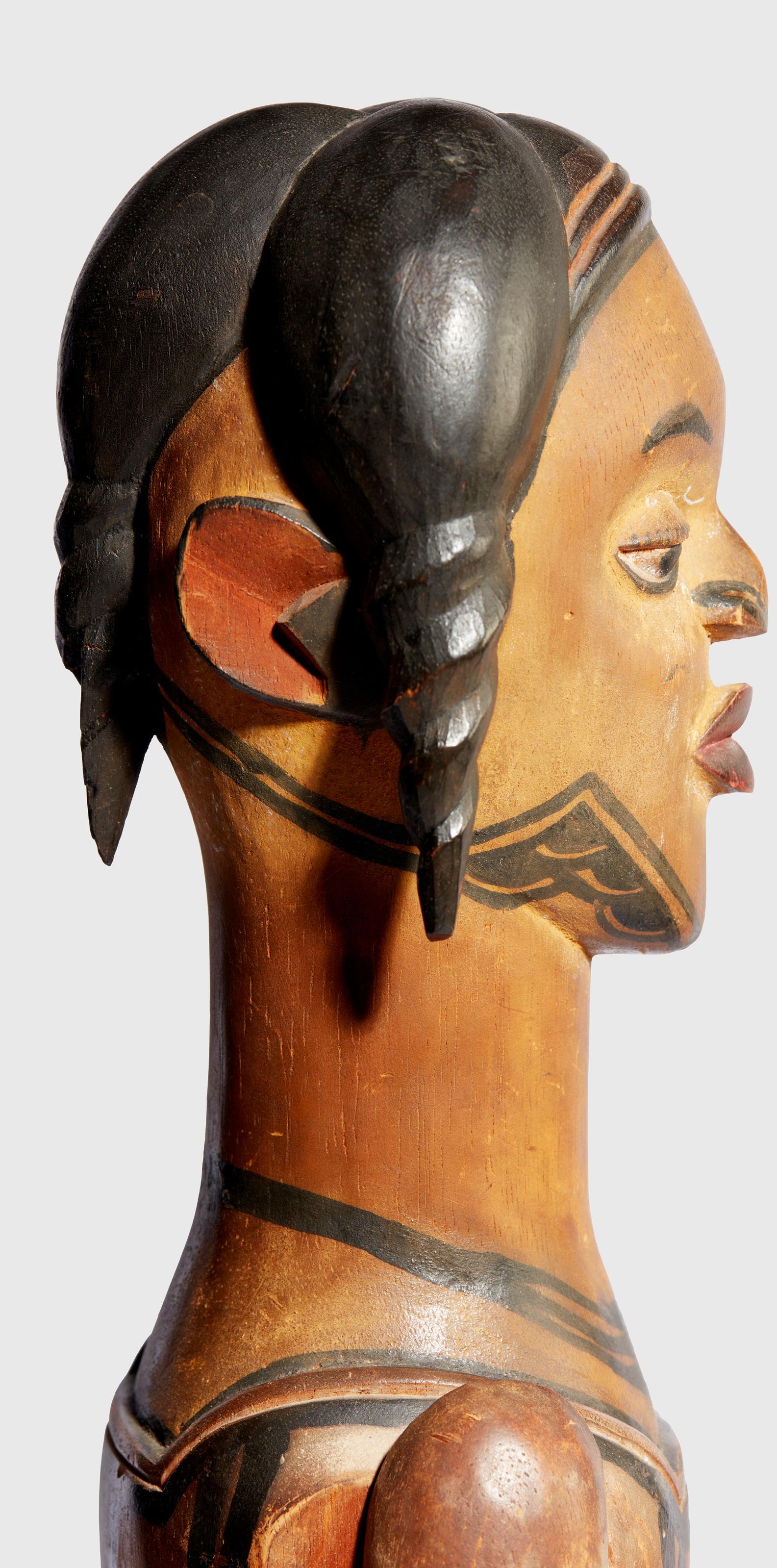

LONDON | EDINBURGH | GLASGOW LYONANDTURNBULL.COM
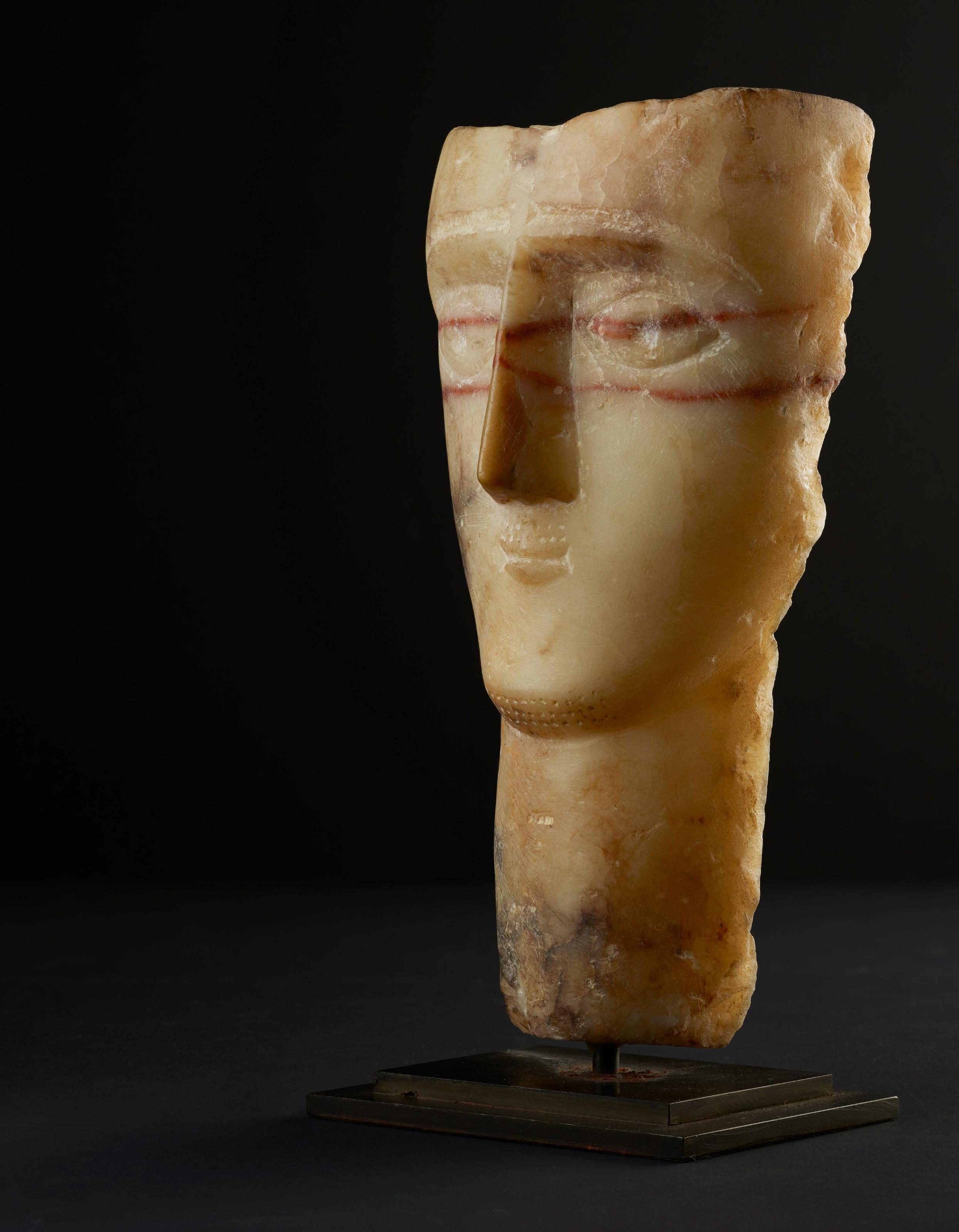





















































































































































































 DENIS MITCHELL (BRITISH 1912-1993) PROBUS, 1971
DENIS MITCHELL (BRITISH 1912-1993) PROBUS, 1971

